Indian Interesting Stories From INLNews.com
How free is India's media? - The Inside Story Podcast
Podcast on Spotify
How Free Is India's Media? The Inside Story
The most powerful celebrity Freemasons of all time (msn.com)
Masons past and present
Freemasonry, while rooted in its early origins as a clandestine society, has evolved to a point where many of its members are high-profile figures today. These fraternal organizations operate on the foundations of humanitarianism, symbolism, philosophy, and charity.
Do you know legendary actor Clark Gable was a Freemason?
You might be surprised at the other celebrity members of this organization!
The most powerful celebrity Freemasons of all time (msn.com)
Masonic beliefs
Central to Freemasonry is the concept of brotherhood, altruism, and truth. Masons strive for ethical growth and self-enhancement through active participation in symbolic rituals and ceremonies.
They have been a persecuted group
Membership of a Masonic lodge has garnered different reactions, depending on the country. For instance, in Spain, Freemasons were once subjected to severe oppression. The 18th-century Spanish regime imposed a ban on masons across its empire. Then, during Franco's dictatorship, masons and communists were seen as the main threats to the state.
But they're celebrated in countries like the UK and Italy
Many members of Mussolini's collaborators were masons, but by the mid-1920s he outlawed Freemasonry. In Britain, where the first Grand Lodge was built, the movement has been viewed more favourably.
Oscar Wilde got into Freemasonry thanks to his friendship with Prince Leopold
The famous writer was very active in Freemasonry thanks, in part, to his relationship with Prince Leopold, the sixth son of Queen Victoria of England, who introduced him to the society. Wilde was first in Apollo Lodge and then in Churchill Lodge.
[But they're celebrated in countries like the UK and Italy]
[Silvio Berlusconi belonged to the Propaganda Due (P2) Lodge]
[Buzz Aldrin, member of Clear Lake Lodge 1417]
Silvio Berlusconi belonged to the Propaganda Due (P2) Lodge
Before he got into politics, Silvio Berlusconi was a prominent member of the Italian secret society known as P2, or Propaganda Due. Specifically, his membership card bore the number 1,816. The Grand Master of the organization, Lucio Gelli, has acknowledged Berlusconi's involvement on multiple occasions, as reported by Italian media outlets such as La Stampa
George Washington was a Master Mason
The first President of the United States of America became a Master Mason at Alexandria Lodge No. 22. He was initiated at age 20, in 1752, at Charity Lodge No. 362 in Campbell, California. At his swearing-in ceremony, he took the oath of office on a Bible from St. John's Lodge in New York.
Buzz Aldrin, member of Clear Lake Lodge 1417
Edwin Buzz Aldrin was the second man and first mason to ever step on the surface of the moon. He was an active member of Clear Lake Lodge No. 1417 in Texas.
Mozart composed peices for Masonic meetings
The Austrian composer Wolfgang Amadeus Mozart became a Master Mason. He had a lot of connection to Freemasonry as a result of his membership in the Zur Wohltätigkeit Lodge in Vienna. Some of his works were even composed for Masonic gatherings.
Prince Philip, Duke of Edinburgh, initiated into Navy Lodge, No. 2612
The husband of Queen Elizabeth II was initiated in 1952 at Naval Lodge No. 2612, of the United Grand Lodge of England, the same one in which his father-in-law, King George VI, was initiated. Prince Philip used to attend the meetings of his lodge without prior notice. When he died, many of the main lodges around the world sent their condolences for the passing of their "brother."
Arthur Conan Doyle, a member of Phoenix Lodge No. 257 de Portsmouth
The creator of Sherlock Holmes, Arthur Conan Doyle, was initiated in January 1887 at Phoenix Lodge No. 257 in Portsmouth. He was also an honorary member of the St. Mary's Chapel Lodge No. 1 in Edinburgh of the Grand Lodge of Scotland.
Mark Twain used mason symbols in his work
Samuel Langhorne Clemens, better known as Mark Twain, was one of many writers who had a relationship with Freemasonry. He became a Grand Master in St. Louis and his works contain Masonic references. He was a member of the Polar Star Lodge No. 79 in St. Louis.
FDR, initiated in Holland Lodge No. 8 in New York
Franklin Delano Roosevelt, the only U.S. President to win four consecutive elections in 1932, 1936, 1940, and 1944, was initiated in the New York Holland Lodge No. 8 in 1911. In Chile, there is even a lodge that bears his name: the Franklin Delano Roosevelt Lodge No. 99 in Limache.
King George VI: "Freemasonry has been one of the strongest influences on my life"
The British King George VI was initiated into Freemasonry in 1919 in the Naval Lodge No. 2612, of the United Grand Lodge of England. After WWII, he wrote: "Freemasonry has been one of the strongest influences on my life,” and collaborated to create a postage stamp full of Masonic symbolism.
Winston Churchill left the masons when he entered politics
The former Prime Minister of the United Kingdom was initiated as a Freemason at the age of 26. He frequently attended Studhome Lodge meetings, but never held a prominent position and left the masons to pursue politics. He also descended from a line of Masons, according to Scottish Rite.
John Wayne, a member of several lodges©Provided by Showbizz Daily (English)
In his youth, the legendary Western actor John Wayne was a member of the DeMolay Order, a youth group from the Mason family. He began in Freemasonry officially in 1970 at the Marion McDanial Lodge 56 in Tucson, Arizona. In 1970, he also became a member of the Shriners, an American Masonic society.
Clark Gable, Beverly Hills Lodge No. 528©Provided by Showbizz Daily (English)
The 'Gone With The Wind' star was in more than 60 motion pictures. In the midst of his success, he joined Freemasonry and was eventually raised to a Master Mason in the Beverly Hills Lodge, No. 528, in 1933.
Michael Richards, a 33-degree Scottish Rite Freemason©Provided by Showbizz Daily (English)
According to American media, the actor who played Cosmo Kramer in 'Seinfeld' is a 33-degree Scottish Rite Freemason, a title granted solely out of recognition for outstanding services.
Simon Bolivar was a member of the Spanish Lodge Lautaro in Cadiz .
Simon Bolivar, the hero who helped secure independence for Bolivia, Colombia, Ecuador, Peru, and Venezuela from the Spanish Empire, was also a mason. He joined the Spanish Lodge Lautaro in Cadiz during his second trip to Europe.
Steve Wozniak, member of the Charity Lodge No. 362 in California©Provided by Showbizz Daily (English)
A fact not everyone knows about Steve Wozniak, one of the founders of Apple, is that he is a Freemason. He joined Freemasonry in 1980 at Charity Lodge No. 362 in Campbell, California.
John Elway, member of the South-Denver Lodge No. 93
The famous Denver Bronco Hall of Fame Quarterback joined his local lodge in 2002. He started to become interested in Freemasonry when his Super bowl winning career ended.
Jesse Jackson, member of Most Worshipful Prince Hall Grand Lodge of Illinois
The civil rights activist who ran for president in the United States Democratic Party primaries in 1984 and 1988, was made a mason by the Grand Master Senter of the Most Worshipful Prince Hall Grand Lodge of Illinois on May 25th, 1987. The lodge was founded in the 18th century and primarily made up of African American members.
Guests: Rana Ayyub - Global Opinions Writer, The Washington Post.
Shoaib Daniyal - Political Editor, Scroll News, India.
Beh Lih Yi - Asia Program Coordinator, Committee to Protect Journalists.
CIA Operation Mind Control - MK Ultra
CIAOperationMindControl_MKUltra (inltv.co.uk)
https://inltv.co.uk/index.php/ciaoperationmindcontrol-mkultra
OPERATION MIND CONTROL - The CIA's Plot Against America
by Walter Bowart
Click Here for INL News Amazon Best Seller Books
 Click Here for INL News Amazon Best Seller Books
Click Here for INL News Amazon Best Seller BooksClick Here for the best range of Amazon Computers
Click Here for INL News Amazon Best Seller Books
Amazon Electronics - Portable Projectors
CIA_MKUltraBrainwashing_Drugs-Mafia (inltv.co.uk)
https://awn.bz/
The most terrifying true story ever to emerge from the United States. Walter Bowart has uncovered a cryptocracy dedicated to manipulating and controlling human minds. Through hypnosis and drugs, ordinary citizens became CIA "zombies", human computers, assassins, with no control over or or consciousness of their actions. Only unexplained memory gaps, or a separate personality which emerged on a trigger, showed the victim that something was amiss. Bowart's account includes top secret documents cold-bloodedly outlining the cryptocracy's program, and outline new evidence that links Lee Harvey Oswald, James Earl Ray and Sirhan Sirhan with Mind Control
"The prostitution of the mind by our secret police preceded the murder of the mind...."...
The Indian 'germ murder' that gripped the world
 By Soutik Biswas India correspondent
By Soutik Biswas India correspondent
On the afternoon of 26 November 1933, a diminutive man brushed past a young landlord in a crowded railway station in the eastern Indian city of Kolkata (then Calcutta).

The murder took place in the busy Howrah station in Kolkata (then Calcutta)
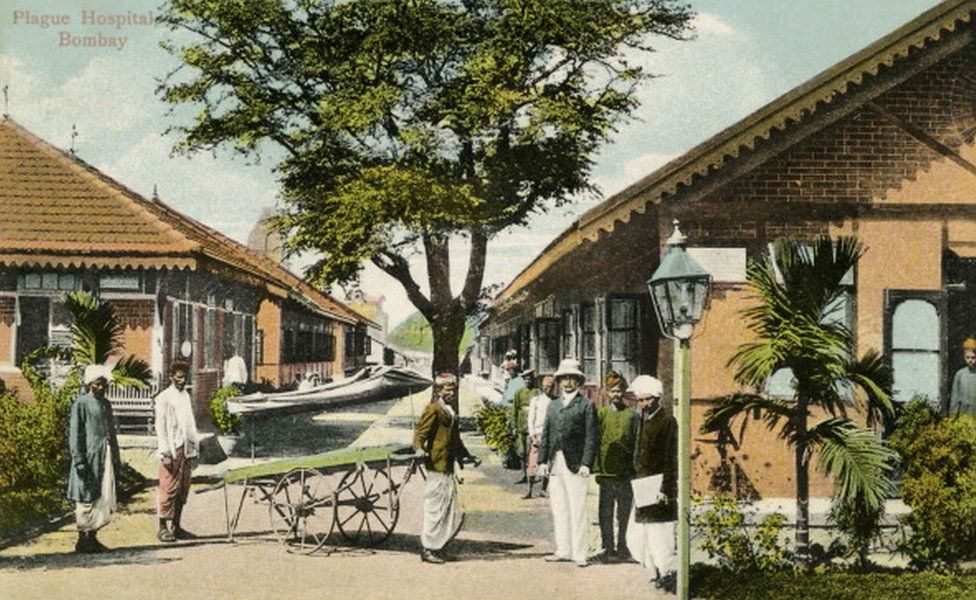
Plague killed more than 12 million people in the Indian subcontinent between 1896 and 1918

Attempts were made to steal bacteria cultures from the Haffkine lab in Mumbai (then Bombay)
What happened over the next year was a plot which was ahead of its time.
As Benoyendra moved to gain possession of the estate, his doctor friend Bhattacharya made at least four attempts to obtain a culture of plague bacteria.
In May 1932, Bhattacharya contacted the director of Mumbai's (then Bombay) Haffkine Institute, the only laboratory in India where these cultures were kept. The director of the lab refused to supply any unless he had the permission of the Surgeon-General of Bengal.
The same month, Bhattacharya approached a doctor in Kolkata and claimed he had discovered a cure for plague, and that he wished to test it, using a culture. According to court records, the doctor allowed him to work in the lab but prohibited him from handling a culture obtained from Haffkine Institute. The work came to a halt as the bacteria failed to grow in the culture, according to Dr Lambert.
In 1933, Bhattacharya again coaxed the doctor in Kolkata to write a letter to the director of the Haffkine Institute. In it the doctor sought permission for Bhattacharya to use the institute's facilities to test his "cure for plague".
That summer, Benoyendra travelled to Mumbai. There he joined Bhattacharya and tried to bribe two veterinary surgeons attached to the institute to smuggle out a culture of plague bacteria.
Benoyendra also went to a market and bought rats to help them pass themselves off as serious scientists. Then the two men went to the Arthur Road Infectious Diseases Hospital, which also stored cultures.
There Benoyendra persuaded officials to "allow his doctor friend to work in his laboratory on his alleged cure", court documents show. There was no evidence that Bhattacharya did any experiments in the lab. On the evening of 12 July, some five days after being given access to the laboratory, Bhattacharya abruptly cut short his "work" and returned to Kolkata with Benoyendra.
Amarendra Chandra Pandey, 20, felt a jab of pain in his right arm as the man dressed in khadi, or coarse, homespun cotton, disappeared into the crowd at Howrah station.
"Someone has pricked me," he exclaimed, but he decided to press on with his journey to the family estate in Pakur, a district now in neighbouring Jharkhand state.
Accompanying relatives implored Amarendra to stay back and get his blood tested. But his half-brother Benoyendra, who was 10 years older and had arrived at the station uninvited, "made light of the incident" and persuaded him not to delay.
Three days later, a doctor examined Amarendra - he had returned to Kolkata after contracting a fever - and saw "something like the mark of a hypodermic needle" at the place where he had felt the prick. Over the next few days, the patient developed a high fever, swelling in his armpits and early signs of lung disease. On the night of 3 December, he sank into a coma. He died early next morning.
Doctors certified that Amarendra had died of pneumonia. But lab reports that arrived after his death pointed to the presence of Yersinia pestis, the lethal bacteria that causes plague, in his blood.
Transmitted by rodents and fleas, plague killed more than 12 million people in the Indian subcontinent between 1896 and 1918. Plague deaths had fallen to around half-a-million between 1929 and 1938, and there had not been a single case of plague recorded in Kolkata in the three years up to Amarendra's death.
The sensational killing of the scion of a wealthy zamindar (landlord) family gripped people in British India and beyond. It was described by some as "one of the first cases of individual bioterrorism in modern world history".
Publications followed the story closely. Time magazine called it a "murder with germs", while Singapore's Straits Times described it as the "punctured arm mystery".
Investigations by the Kolkata police unveiled a tangled web of conspiracy and a stubbornly audacious plot, involving purloining deadly bacteria from a hospital in Mumbai (then Bombay), some 1,900km (1,100 miles) away.
At the heart of the crime was sibling rivalry over family spoils.
The Pandey half-brothers had been engaged in a bitter two-year battle over their deceased father's sprawling estate in Pakur, an area well known for its coal mines and stone quarries. The story of the feuding brothers was framed in popular media reports as one between good and evil.
Amarendra, according to one account, was a "gentlemanly, upholder of high ethical and moral standards, keen on pursuing a higher education, with a penchant for a regular fitness regime" and "much loved" among the locals. Benoyendra, on the other hand, "led a dissolute life, excessively fond of drinking and women".
According to court documents, the plot to kill Amarendra was possibly hatched in 1932 when Taranath Bhattacharya, a doctor and close friend of Benoyendra, unsuccessfully tried to source a culture of plague bacteria from medical laboratories.
Although disputed, some accounts suggest Benoyendra may have first tried to kill his half-brother in the summer of 1932. The two had gone for a walk in a hill station when Benoyendra, according to a report by British health official DP Lambert, "produced a pair of spectacles and forcibly squeezed them on Amarendra's nose, breaking the skin".
Amarendra soon fell sick - the suspicion apparently was that the glasses were tainted with germs. He was diagnosed with tetanus, and given anti-tetanus serum. Benoyendra allegedly brought in three doctors to try change his brother's treatment, but all of them were refused, according to Dr Lambert's account.
What happened over the next year was a plot which was ahead of its time.
As Benoyendra moved to gain possession of the estate, his doctor friend Bhattacharya made at least four attempts to obtain a culture of plague bacteria.
In May 1932, Bhattacharya contacted the director of Mumbai's (then Bombay) Haffkine Institute, the only laboratory in India where these cultures were kept. The director of the lab refused to supply any unless he had the permission of the Surgeon-General of Bengal.
The same month, Bhattacharya approached a doctor in Kolkata and claimed he had discovered a cure for plague, and that he wished to test it, using a culture. According to court records, the doctor allowed him to work in the lab but prohibited him from handling a culture obtained from Haffkine Institute. The work came to a halt as the bacteria failed to grow in the culture, according to Dr Lambert.
In 1933, Bhattacharya again coaxed the doctor in Kolkata to write a letter to the director of the Haffkine Institute. In it the doctor sought permission for Bhattacharya to use the institute's facilities to test his "cure for plague".
That summer, Benoyendra travelled to Mumbai. There he joined Bhattacharya and tried to bribe two veterinary surgeons attached to the institute to smuggle out a culture of plague bacteria.
Benoyendra also went to a market and bought rats to help them pass themselves off as serious scientists. Then the two men went to the Arthur Road Infectious Diseases Hospital, which also stored cultures.
There Benoyendra persuaded officials to "allow his doctor friend to work in his laboratory on his alleged cure", court documents show. There was no evidence that Bhattacharya did any experiments in the lab. On the evening of 12 July, some five days after being given access to the laboratory, Bhattacharya abruptly cut short his "work" and returned to Kolkata with Benoyendra.
The police arrested the two men in February 1934, some three months after the murder. Investigators tracked down Benoyendra's travel papers, his hotel bills in Mumbai, his handwritten entries in a hotel register, his messages to the lab, and receipts from the shop from where he purchased the rats.
By all accounts, the nine-month-long trial was riveting. The defence argued that Amarendra had been bitten by a rat flea. The court said the evidence proved that the two men accused of his murder had "stolen plague bacilli" from the Mumbai hospital and that "they could be carried to Calcutta and kept alive till 26th November 1933", the day of the murder.
The trial court found Benoyendra and Bhattacharya had conspired to kill Amarendra with a "hired assassin", and sentenced them to death. In January 1936, the Calcutta High Court, on appeal, commuted the sentences to life. Two other doctors who were arrested in connection with the murder were acquitted because of lack of evidence. "The case is probably unique in the annals of crime," a judge who heard the appeal remarked.
Dan Morrison, an American journalist who's researching a book on the killing called The Prince and the Poisoner, told me that Benoyendra was a "20th Century man who thought he would outsmart the Victorian institutions that dominated India at the time of the murder". The railway station killing, according to Mr Morrison, was a "thoroughly modern murder".
Biological weapons have been used possibly since the 6th Century BC when the Assyrians poisoned enemy wells with rye ergot, a fungal disease. But, in many ways, Amarendra's murder has echoes of the killing of Kim Jong-nam, the 45-year-old half brother of North Korea's leader Kim Jong-un, as he waited for a flight in Kuala Lumpur in 2017. Two women, who were later arrested, had rubbed his face with a lethal nerve agent.
In the case of the almost-forgotten Howrah railway station murder 88 years ago, the man who murdered the prince and the weapon of killing - the hypodermic needle - were never found.
Read more by Soutik Biswas
Slain Church Founder Planned Film On CIA Drug Experiments (from CIA Now Released Files)
https://www.cia.gov/
The sinister draw of Indian true crime shows
The sinister draw of Indian true crime shows - BBC News
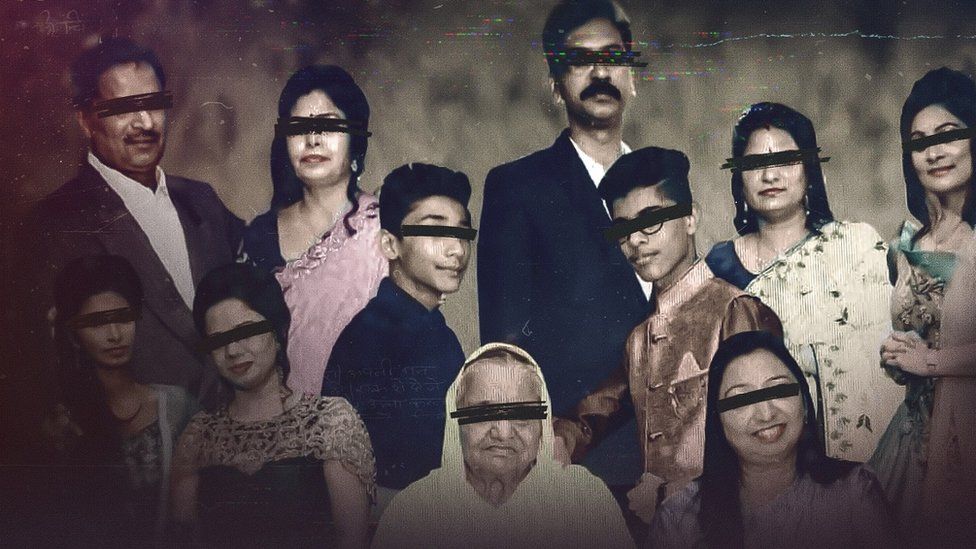
The Burari Deaths examines the mysterious deaths of 11 members of a family in capital Delhi

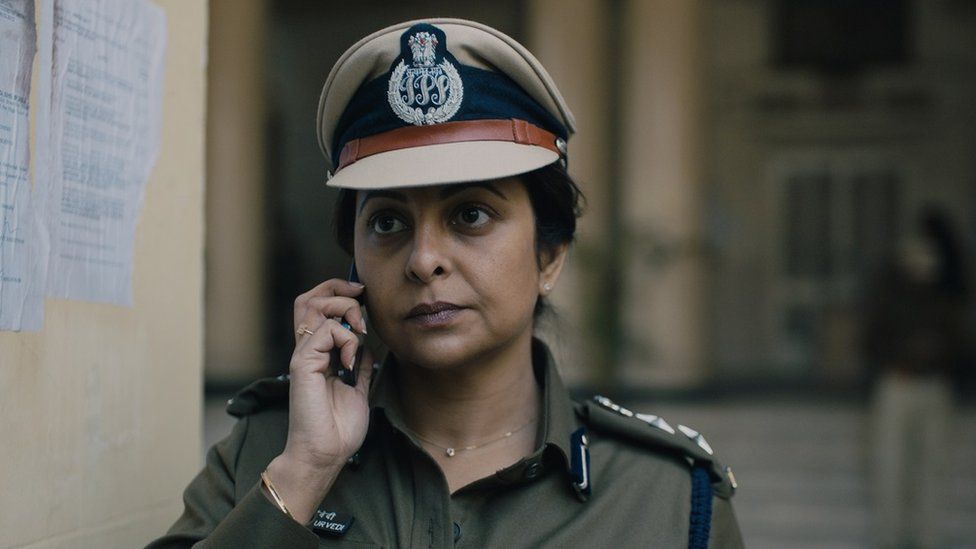
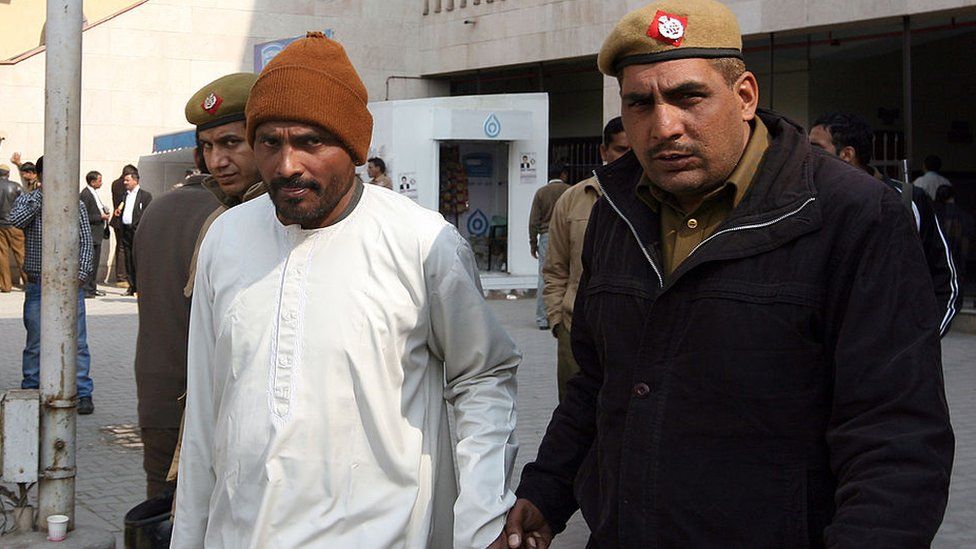
The psychology student who lives in India's financial capital, Mumbai, says she's a fan of true crime shows because she enjoys "watching how a criminal's mind works", but confesses to feeling anxious about her own safety after bingeing on them.
She is among thousands of Indians who are swiftly taking to popular and at times, sensationalist Indian true crime shows and podcasts on streaming platforms.
These slickly-produced shows focus on Indian-born criminals and their evil deeds, shining a spotlight on the country's history of crime.
Docuseries like The Indian Predator traces the crimes of serial killers. House of Secrets: The Burari Deaths examines the controversial theories surrounding the deaths of 11 members of a family in capital Delhi. The Emmy award-winning drama series, Delhi Crime, is based on the horrific gang-rape of a woman in Delhi in 2012.
Fans say these shows are creating a lexicon of Indian criminals and crimes that was largely absent before. Rakhi, who grew up watching and reading about American serial killers like Jeffrey Dahmer or Ted Bundy, says she "now talks about Charles Sobhraj and Jolly Joseph".
The true crime genre is not new to India; pulpy detective magazines from the 2000s often drew inspiration from real-life crimes for their plots as did TV shows like Crime Patrol and CID. But these shows had cheesy graphics and dialogues that inspired humour rather than fear.
Fans say that today's web series are more gripping and informative: they explore the criminal's background, mindset and present multiple perspectives on the case.
Seema Hingorrany, a therapist, says true crime shows are addictive because they give the viewer a "high" by triggering the release of certain feel-good chemicals in the brain.
"They also allow you to vicariously experience extremely thrilling situations without actually putting yourself in harm's way," she says.
These shows often use visceral visuals to grab attention. In the docuseries The Butcher of Delhi, a scene of the killer butchering a body - though it's out of the frame - is repeated multiple times. There are partially-blurred photos of decapitated bodies, tied-up victims and blood spatters.
The show tells the story of Chandrakant Jha, a migrant worker who killed and dismembered several victims - all of them poor migrants - in the 1990s and early 2000s and dumped their bodies in front of a jail, along with notes taunting the police.
Director Ayesha Sood says that depicting the violence in such a jarring fashion was a conscious decision, but the caveat was that the violence would be suggested rather than actually shown.
"The fact is that the crimes were brutal and the case was ignored by the media, police and public for years," says Ms Sood. "We sometimes only want to hear about people who are like us - and the news cycle reflects this - but it's important to understand that brutality happens across class, and that we need to pay attention to it wherever it happens."
Ms Sood says that Indian crime shows - by virtue of their subjects - create room for important conversations around criminality and its genesis in the country, how criminal behaviour is dealt with and what can be done to create safer spaces for everyone.
Sukoon Tyagi, who's an avid fan of The Desi Crime Podcast - which highlights crimes from India and other South Asian countries - says that the podcast has made her more vigilant about her safety and that she pays attention to how a victim has escaped a dangerous situation.
For Ms Tyagi, the podcast reflects a reality she has always known. She lives in Delhi, which is known for its high crime rate. As per the National Crime Records Bureau's (NCRB) latest report, two minor girls were raped in Delhi every day in 2021.
"The crimes that are talked about have been committed in places you know or frequent, so you cannot distance yourself from the fear," she says.
Some studies say that women are more likely to consume true crime media because they can relate to the victim - who very often is female - and because it helps them gain insight into why and how a crime was perpetrated and what they could do to save themselves if they are confronted with the same situation as the victim.
However, critics say such shows and podcasts can sometimes be factually inaccurate and poorly researched. "These shows are also fraught with ethical issues," says Srinath Rao, a Mumbai-based crime reporter. "There's little to no thought about how the show could impact the victim's or criminal's family".
After the documentary on the Burari deaths released in 2021, several memes about the tragic incident surfaced online. The key message of the documentary, which was to highlight the poor state of mental health in the country, was lost on many as it became a punch line of jokes.
The same year, a Netflix series on serial killer Jeffrey Dahmer sparked controversy after family members of a victim claimed that they found the show "traumatising". A 2019 biopic on serial killer and rapist Ted Bundy, and starring actor Zac Efron, drew the ire of critics for "glamourising Bundy's charisma" and "making him look a bit like a rockstar".
Ms Hingorrany says that true crime shows can also trigger anxiety or desensitise a person.
"The criminals depicted often have poor conflict-resolution skills and resort to violence and criminal activity. A person watching these shows could internalise such behaviours unknowingly," she says.
Ms Sood, however, says that these shows, when made well, can "push us to look inside and what's happening around us".
"Fear is a powerful emotion," she says. "It can keep you safe."
BBC News India is now on YouTube. Click here to subscribe and watch our documentaries, explainers and features.
'Fridge murder': Is India seeing a wave of gruesome copycat murders?
-
Published
- 'Fridge murder': Is India seeing a wave of gruesome copycat murders? - BBC News
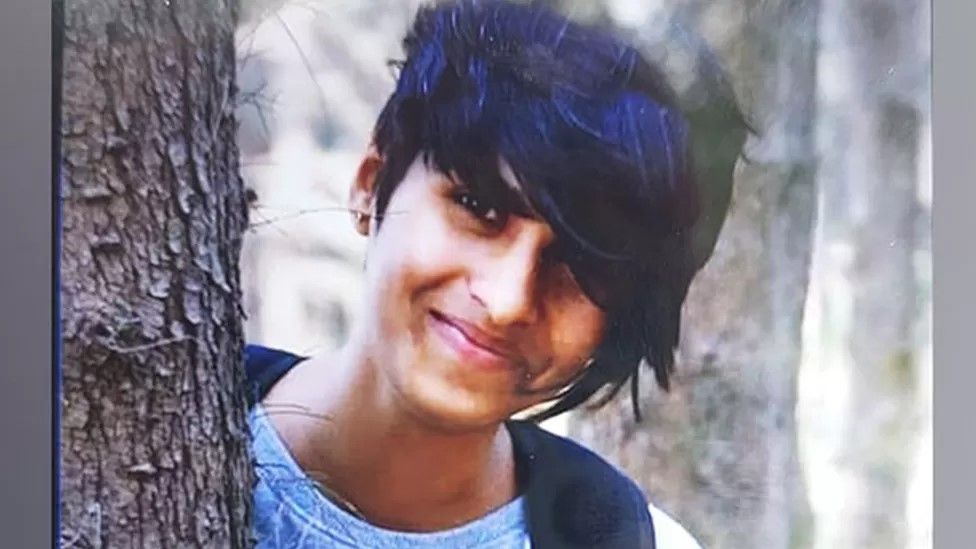
- Shraddha Walkar's murder made headlines in India
-
 By Soutik Biswas India correspondent
By Soutik Biswas India correspondent News networks reporting near a pond in Delhi where Walkar's body parts where allegedly thrown
News networks reporting near a pond in Delhi where Walkar's body parts where allegedly thrownSome 30 years ago, a scientist in the Indian capital, Delhi, killed his wife following an altercation at home, chopped her body into parts and stuffed them into a trunk.
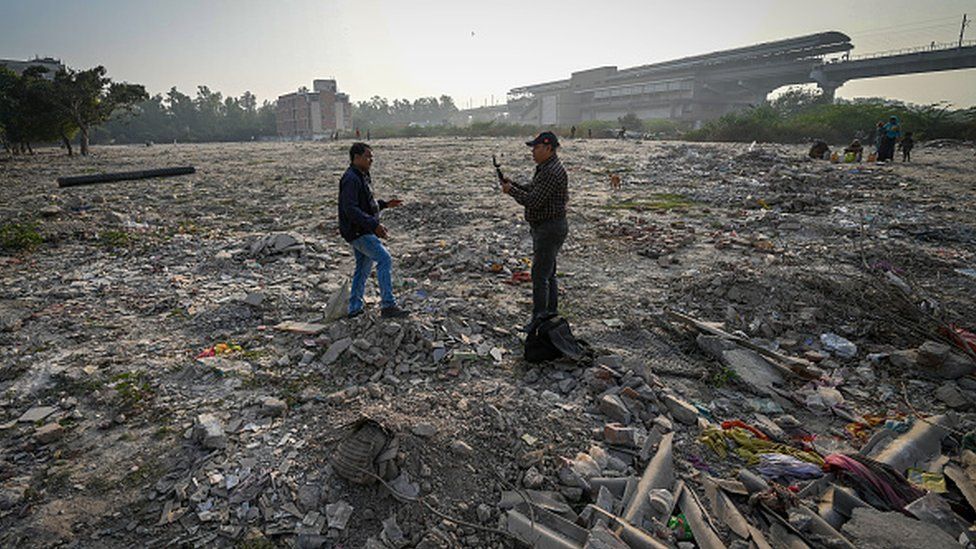
Police in Delhi looking for remains of a man who was allegedly killed by family members in November
He then travelled with the trunk more than 1,500km (932 miles) in a crowded train to the southern city of Hyderabad and checked into a hotel near a marsh. Over the next few days, he disposed off the remains in a muddy lake. One day, a stray dog scavenging for food yanked a human hand out of the bog.
"The man dismembered the body and took the parts to another city to eliminate evidence. There was nothing new about a 'dismemberment murder'. But we wondered whether the method of disposal of the body [parts] was inspired by a book or film," recounts Dependra Pathak, a senior Delhi police official.
A rash of similar killings in recent months have dominated headlines in India, triggering speculation about whether these were copycat murders. In each case, the victim had been killed, chopped into pieces and stuffed into a refrigerator or a suitcase. The remains had then been ferried in a suitcase or a bag and scattered in a sprawling ground, desolate roads or a forest.
The full crime data in India doesn't offer any clues. More than 29,000 cases of murder were registered during 2021, a marginal increase of 0.3% over 2020. Most of the killings were provoked by "disputes", followed by "personal vendetta or enmity" and "gain [for money]". We don't know how many victims were dismembered or what weapons were used for the killings.
"Copycat murder and murder suicides are real. The media spreads the contagious behaviour: imitation," wrote Loren Coleman, a cultural behaviourist who studied how media's saturated coverage of crimes impacted people.
Aftab Poonawala, who was charged in November with the murder of his partner Shraddha Walkar, was apparently inspired by Dexter, a US crime drama featuring a forensic blood splatter analyst who moonlights as a vigilante serial killer.
Police claim that Poonawala strangled Walkar, chopped her body into 36 pieces, stored them in a refrigerator and dumped them in a forest near their home.
"Sensationalising such killings can create hysteria among people, and even inspire copycat acts," says Anuja Kapur, a criminal psychologist.
Yet, sleuths and crime psychologists say there's no reason to believe the India's rash of "fridge" and "suitcase" murders - as a sensation-loving media has described them - are copycat crimes. "Copycat crimes are real. But in my experience, the methods of eliminating evidence borrow more from films and novels rather than the crime itself," says Mr Pathak.
For one, dismembering corpses after killing a victim to get rid of the evidence is an old and common crime. The media's "bad news bias" - oversaturated coverage of sensational murders - spurs increased reporting of similar crimes, creating an impression that such killings were becoming more frequent.
"Dismemberment murders are relatively rare but they also happen all the time. It's just that many cases are not reported by the media. I am looking into three cases of murder and dismemberment that haven't been reported by the media at all," says Sudhir K Gupta, head of forensic medicine at Delhi's All India Institute of Medical Sciences.
When Dr Gupta began his career as a forensic surgeon in India three decades ago, he would come across cases where the victims were called out of their homes, murdered in desolate areas and their corpses were thrown in the jungles.
As the country urbanised and more families became nuclear, more murders were committed in less-crowded homes, and, in some cases, the corpses were dismembered and disposed off.
"Forensic reconstruction of the events leading to the murder and identification of the victim can become a challenge when corpses are dismembered," says Dr Gupta. "But even a detailed examination of human bones can tell us the gender, age, date of death and even the probable case of death."
International studies offer some clues about "dismemberment murders".
A study of 13 cases from a sample of cases spanning 10 years in Finland found that none of the victims were strangers to the offenders, and nearly half were partners or family members. At the time of the killing, the study found, the majority of the offenders were jobless, and none had been in any occupation that required knowledge of human bodies or handling of corpses.
Another study of 30 homicide cases involving dismembered bodies over half a century by the department of forensic medicine in Kraków, Poland found that these murders were usually not planned, and were committed by offenders who were in "close relationship with victim (family or friend) in the same place as the killing - the home of the perpetrator". A separate study by the Boston University school of medicine showed that 76% of dismembered crimes were committed by men.
Very little is known about the patterns of such "dismemberment" killings in India. What is also not known is how many murderers end up surrendering to the police after the act, and how many try to conceal evidence by dismembering or mutilating a corpse.
"But what we know is that many of the these killings reveal the infirmities in modern-day social relationships in India, like tensions in troubled marriages, extra-marital affairs, live-in relationships," says Mr Pathak. "That is when things often go out of control."
- When a cobra became a murder weapon in India
-
Read more by Soutik Biswas
When a cobra became a murder weapon in India
-
Published
- When a cobra became a murder weapon in India - BBC News

- Suraj Kumar (middle) was convicted of killing his wife with a cobra bite
-
Last week, an Indian man was given a rare double-life sentence for killing his wife by making a cobra bite her. Soutik Biswas and Ashraf Padanna piece together the events leading to the grisly murder.
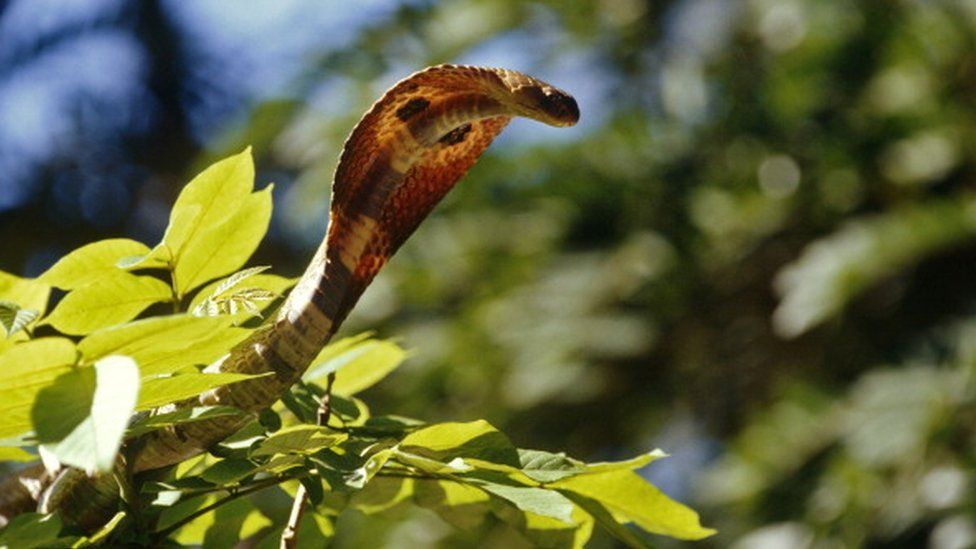
The spectacled cobra is one of the most venomous snakes in the world

Uthra slept on the bed on the left in this room where she was killed

Police found the plastic container in which Suraj kept the cobra that killed his wife

The murder took place on the ground floor of this house in Kollam district
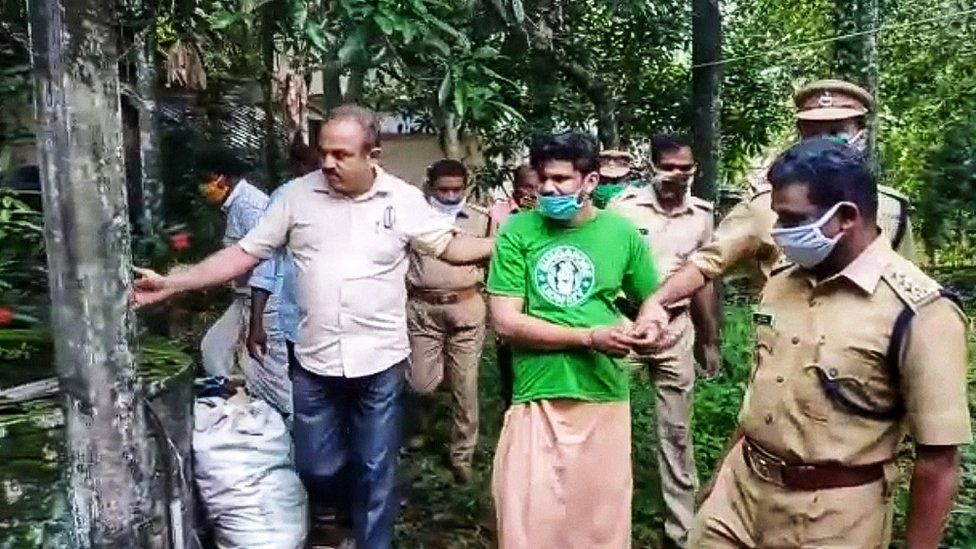
Suraj (middle) had been planning to kill his wife for more than a year, police say
In April last year, 28-year-old Suraj Kumar paid 7,000 rupees ($92; £67) for a spectacled cobra, one of the most venomous snakes in the world. Trade in snakes is illegal in India, so Suraj made the clandestine purchase from a snake catcher, Suresh Kumar, in the southern state of Kerala.
Suraj drilled a hole in a plastic container for air to flow in, put the cobra inside, and took it home.
Thirteen days later, he put the container in a bag and trudged to his in-laws' home, about 44 km (27 miles) away, where his wife Uthra was recovering from a mysterious snake bite.
Suraj and Uthra had met two years earlier, via the services of a matrimonial broker. Suraj's father was an auto-rickshaw driver and his mother a homemaker. Uthra, who was three years younger than Suraj and suffered from learning disabilities, came from a significantly more well-off family - her father was a rubber trader and her mother was a retired school principal.
When the couple married, Suraj accepted a dowry from Uthra's parents of 768 grams of gold (worth about $32,000 at today's rates), a Suzuki sedan and 400,000 rupees in cash. He also received 8,000 rupees a month from her parents "to look after their daughter", investigators said.
It was her parents' home Uthra returned to after being released from hospital, where she was treated for the snake bite. It had put her there for 52 days and required three painful surgeries to heal her affected leg. She had been bitten by a Russell's viper - a highly venomous earth-coloured snake responsible for thousands of deaths in India every year.
Then on the night of 6 May, investigators say, while Uthra was still recuperating, she accepted a glass of fruit juice from Suraj which was laced with sedatives. When the mixture had put her under, Suraj brought out the container with the cobra, overturned it, and dropped the five-foot-long snake on his sleeping wife.
But rather than attack her, the snake slithered away. Suraj picked it up and flung it on Uthra, but again it slithered off.
Suraj tried a third time - he held the reptile by its trademark hood and pressed its head near Uthra's left arm. The agitated cobra, using the fangs at the front of the mouth, bit her twice. Then it slinked off to a shelf in the room and stayed there all night.
"Cobras don't bite unless you provoke them, Suraj had to catch it by its hood and force it to bite his wife," says Mavish Kumar, a herpetologist.
Suraj washed the juice glass, destroyed a stick he had used to safely handle the snake and deleted incriminating call records on his mobile phone, according to investigators.
When Uthra's mother entered the room the next morning, she told the police she saw her daughter lying on the bed with "her mouth open, and her left hand dangling on one side".
She said Suraj was also in the room.
"Why didn't you check whether she was awake?" Manimekhala Vijayan asked her son-in-law.
"I didn't want to disturb her sleep," Suraj told her.
The family rushed Uthra to the hospital, where the doctors pronounced her dead by poisoning and called the police.
The autopsy report found two pairs of puncture wounds, less than an inch apart, on her left forearm. Blood and viscera samples revealed the presence of cobra venom and sedative drugs. Cobra venom can kill in hours by paralysing respiratory muscles.
Acting on a complaint by Uthra's parents, the police arrested Suraj on 24 May in connection with his wife's unusual death. After a 78-day investigation and with charges running into more than 1,000 pages, the trial began.
More than 90 people, including herpetologists and doctors, testified. The prosecution built its case using Suraj's call records, internet history, a dead cobra exhumed from the back garden, a stash of sedatives in the family car and evidence that he bought not one but two snakes. Investigators said that Suraj had also purchased the Russell's viper which had bitten Uthra months before she died.
Suresh, the snake catcher, turned on Suraj and confessed to selling him both snakes. A herpetologist told the court that it was highly unlikely a cobra would have entered the couple's bedroom through a raised window. The crime scene was even recreated, using a live cobra, a snake handler and a dummy of the victim on a bed.
"Cobras are not very active at night. Every time we dropped a cobra on the supine dummy, it slithered to the floor and went into a dark corner of the room," Mavish Kumar said. "Even when we provoked the cobra, it did not try to bite."
He then caught the neck of one cobra and "induced" the bite on a piece of chicken tied to the plastic hand of the dummy. The distance between the bites was the same as it had been on Uthra's arm.
"This is a case of diabolical and ghastly uxoricide," said Judge M Manoj, referring to the murder of a wife. Judge Manoj sentenced Suraj to life in prison, saying he had schemed to kill Uthra and "disguise it as a death from an accidental cobra bite".
According to investigators, the fatal cobra bite was Suraj's third, not second, attempt to kill his wife in just four months.
Suraj, who worked as a collection agent for a local bank, met the snake catcher Suresh in February last year, and bought the Russell's viper from him for 10,000 rupees. He took the snake home in a plastic container and hid it under a heap of firewood in a shed.
Then on 27 February, Suraj released the snake on the landing of the first floor of his home, investigators said, and asked his wife to go upstairs to fetch his mobile phone.
Uthra saw the viper coiled up on the marble floor and raised an alarm, her mother told the police. Suraj came up, picked up the snake with a stick, and left the house. He put it back in the container.
On the night of 2 March, Suraj tried again. He laced his wife's pudding with sedatives, and released the viper in the bedroom while she slept.
This time, investigators said, the snake attacked. Uthra woke up screaming in pain, bites on her leg, and Suraj threw the snake out of the window.
"Snakebite cases are common in Kerala, so we didn't suspect any foul play here," said Vijayasenan Vidhyadharan, Uthra's father. (About 60,000 people die of snakebites in India every year.)
It took more than two hours that night to find a hospital that provided critical care treatment. Uthra was suffering from swelling and haemorrhage. Three skin transplant surgeries later, she returned home to her parent's two-storey house in a verdant village in Kollam to rest.
Suraj remained with his son and parents at his home in Pathanamthitta. But he was already plotting again.
"While his wife was in the hospital, Suraj was trawling the internet about handling snakes and learning about snake venom," said Anoop Krishna, one of the investigators.
Investigators say Suraj had been plotting the murder since the birth of his son, Dhruv, in 2019. His internet history revealed that he searched venomous snakes and watched snake videos on YouTube, including a channel by a locally well-known snake handler. One of the snake-handler's most popular videos is about the "dangerous and aggressive Russell's viper".
Suraj reportedly told his friends that his wife was "haunted by the curse of a serpent" in her dreams, in which she was "destined to die of snakebite".
In reality, Suraj was determined to kill his wife, steal her money, and marry another woman, investigators said.
"He planned it meticulously and succeeded in the third attempt," said Apukuttan Ashok, the lead investigating police officer. Public prosecutor Mohanraj Gopalakrishnan called the case a "milestone in police investigations in India, when prosecutors could decisively prove that an animal was used as a weapon of murder".
Suraj received a rare double life sentence for the crime. According to Gopalakrishnan, he showed no remorse.
The Indian tribesmen catching giant snakes in Florida
-
Published
- The Indian tribesmen catching giant snakes in Florida - BBC News
-
By Soutik Biswas India correspondent

- Burmese pythons (Python bivittatus) have several common names, including Asiatic rock python and black-tailed python
- They are native to India, lower China, the Malay Peninsula and some islands of South and Southeast Asia
- The snakes - which usually reach up to 3m (about 12 feet) in length, but can be more than 5m long - have secured a foothold in the southeast US, after pet snakes were released, or escaped, into the wild
- They are now considered a threat to biodiversity in the Florida Everglades

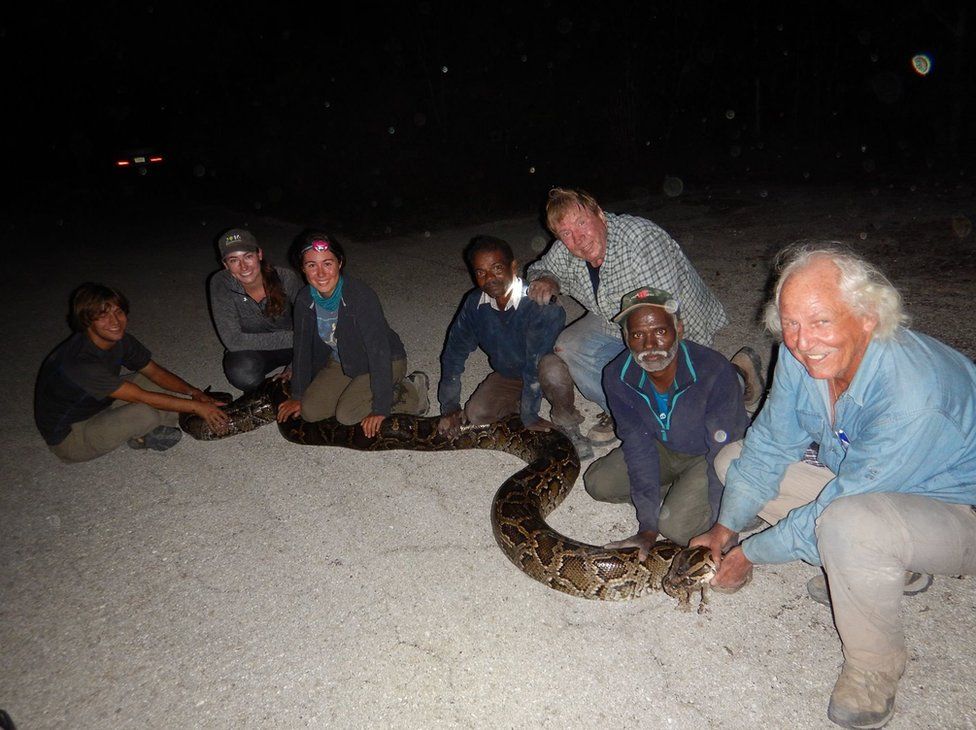 Their biggest catch as been a 16ft-long female python in an abandoned missile base
Their biggest catch as been a 16ft-long female python in an abandoned missile base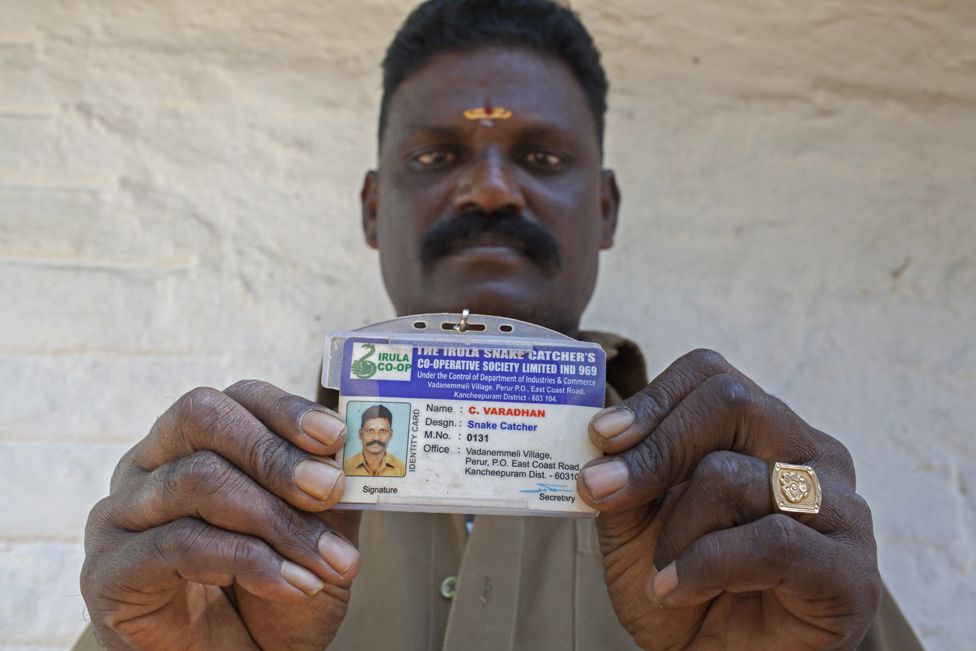 The Irulas have a government licence to catch 8,300 snakes in India every year
The Irulas have a government licence to catch 8,300 snakes in India every year A co-operative of Irula snake catchers has 370 members, including 122 women
A co-operative of Irula snake catchers has 370 members, including 122 women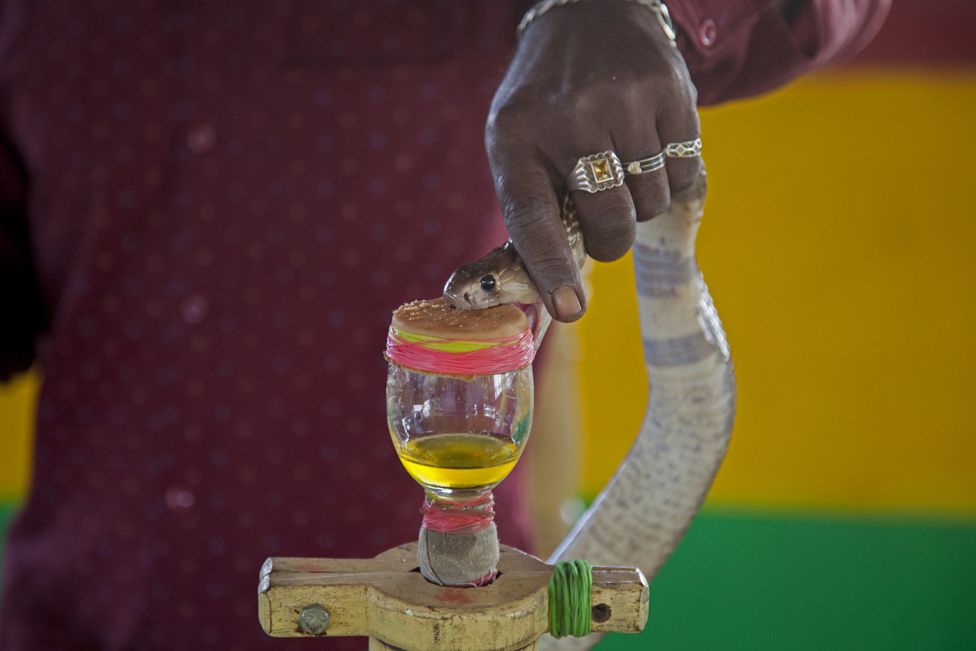 Venom is extracted from each snake four times a month
Venom is extracted from each snake four times a month here are more than 850 poisonous snakes in the co-operative farm
here are more than 850 poisonous snakes in the co-operative farm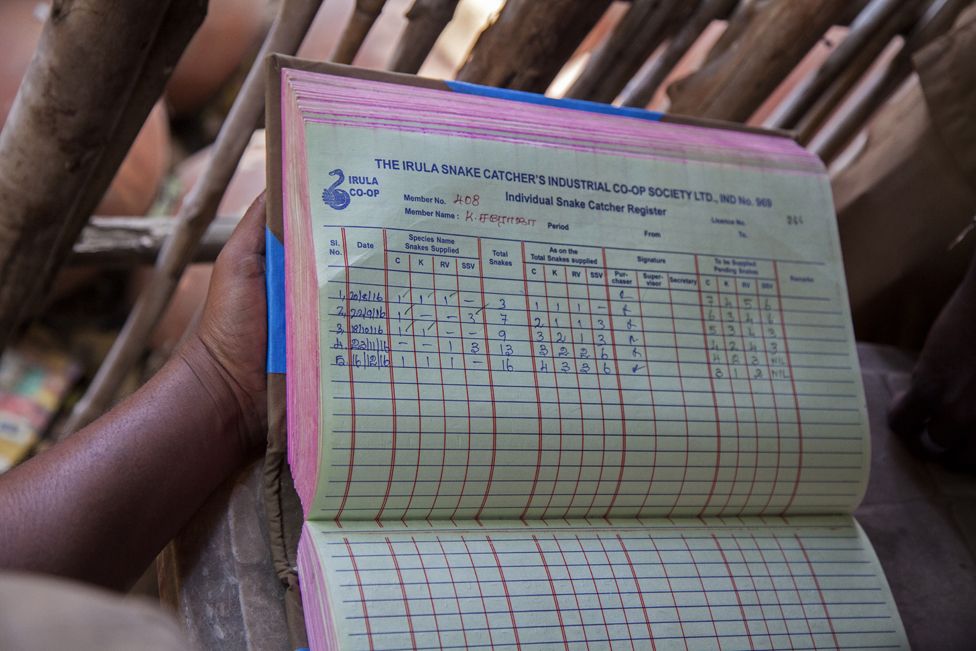 Last year, the co-operative sold snake venom worth 30 million rupees
Last year, the co-operative sold snake venom worth 30 million rupees The snakes are kept in earthen pots filled with sand and covered by white cloth
The snakes are kept in earthen pots filled with sand and covered by white cloth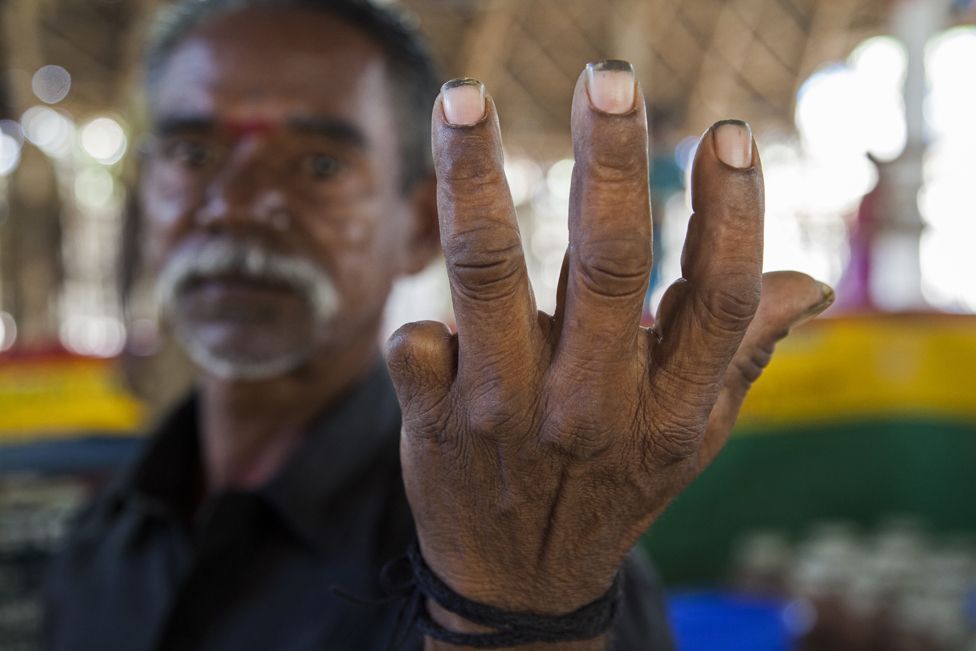 This Irula snake-catcher lost his finger after a cobra bite
This Irula snake-catcher lost his finger after a cobra bite"Masi and Vadivel are doing an incredible job. They excel at determining if pythons are present at a site, locating them if they are, and then catching them when located," Frank Mazzotti, a biologist at the University of Florida who heads a team of researchers investigating pythons, told me.
"They can see pythons even when they are covered by grass. All they need is a glint of snake and they pounce. The rest of us are usually wondering where the snake is. Next thing we see they are holding it."
The Miami Herald marvelled at the snake-hunting skills of the Irulas, whom herpetologist Rom Whitaker describes as the "best snake catchers" in the world. The newspaper reported that the Irulas appeared to have "mysterious" tracking techniques.
"They move slowly and rather than focus on roads and levees where snakes have typically been found basking, they head straight for thick brush. The Irulas believe the boulders and high grasses that line the levees are more lucrative hunting grounds.
"And when the going gets slow, everyone must stop to squat for a quick song of prayer - usually an ancient invocation mixed with an ad lib about pythons or the weather - accompanied by a beedi cigarette."
Writer and film-maker Janaki Lenin, who is accompanying the tribesmen, has provided a gripping account of the female python they recovered in Key Largo. The two men cut the roots that blocked the entrance to the bunker, pried open a door, went inside, poked the snake, broke through a concrete shaft and hauled out the 75kg (165lb) reptile.
Another time, a eight-foot-long python, according to Ms Lenin, "struggled and emptied its bowels" on Masi, who held the tail. "After the Irula bagged the python, the grinning but impressed Americans held their noses with their fingers, miming how stinky the snake faeces were," she recounted.
Masi said he was not bothered. "Only if you are covered in it, can you catch snakes."
For the past month, the two men, who have travelled around the world to catch snakes, have been living in the home of Joe Wasilewski, a well-known herpetologist. Their two months of work is funded by the Florida Fish and Wildlife Conservation Commission.
After an oatmeal breakfast, they are driven to work. Sometimes they go out after dark. In the early days, they survived on Trinidadian Indian food, but since then they have tried hotdogs and burgers and watched an NFL game.
"All that they say so far is that they like being in America and want to catch lots of pythons," Ms Lenin said.
Masi and Vadivel, members of an ancient tribe, have become unlikely globe-trotting snake-catchers. Last July, they went to Thailand to help researchers implant radio transmitters for their study, and ended up catching two king cobras.
Back home, the men are part of a thriving 35-year-old co-operative of community members, who catch snakes and extract and sell their venom for a living. India is home to 50 species of venomous snake and bites kill some 46,000 people a year, accounting for nearly half the snakebite deaths in the world.
The Irulas poached snake and lizard for their skins until the trade was outlawed in 1972. A decade later, they formed a co-operative near the southern city of Chennai and switched to catching poisonous snakes - mainly cobras, kraits and vipers - to extract and sell venom. The venom is now sold to seven laboratories, who manufacture most of India's anti-snake venom serum.
Last year, the co-operative's 370 members, including 122 women, sold snake venom worth 30 million rupees ($446,500; £357,900), up from a mere 6,000 rupees in 1982.
They have a government licence to catch 8,300 snakes every year - each snake is released in the wild after four extractions in a month - but demand they are allowed to catch three times as many.
After all, a gram of cobra venom sells at 23,000 rupees today, nearly eight times as much as the price in 1983. An Irula snake-catcher earns some 8,000 rupees every month, apart from other health and pension benefits.
"We are illiterate and poor. We don't own land. Snakes have saved our lives," says K Ravi, an Irula. But most of them say their children want to move to the big cities and get a "company job". The daughter of an Irula couple is the first collegiate in the co-operative, and is training to become a nurse.
It is not clear whether this will be the last generation of these snake-catchers, a community of 116,000 tribespeople. For many, that would mark the passing away of a traditional hunting skill.
"They are better at the above than any other snake catchers that I have known," Mr Mazzotti says.
"Think of [the game of] cricket. What is the difference between really good amateurs and professionals? The Irulas are professionals."
Every morning, two Indian tribesmen in T-shirts and long trousers, leave their dwellings in southern Florida and head into the Everglades to hunt for some of the world's biggest snakes.
Masi Sadaiyan and Vadivel Gopal, members of the once-nomadic Irula tribe, are armed with crowbars and machetes. Wearing fleece jackets and baseball caps, they slash and wade their way through the largest subtropical wilderness in the world to hunt down Burmese pythons.
The non-native snakes - which escaped into the wild in Florida or were released as pets - pose the biggest threat to the small mammal population of the national park. They also eat birds, alligators and deer. In 2005, a Burmese python tried to swallow an alligator and exploded in the park, leaving both the predators dead.
Ever since the pythons were spotted in the wild more than two decades ago, authorities have tried everything to catch the elusive snakes in the marshes, but with limited success.
They have used pythons (called Judas snakes) to find other pythons during the mating season, asked people to turn in their pet snakes, poisoned prey, and even encouraged people to hunt them for a cash prize.
Last year, some 1,000 hunters participated in a competitive month-long Burmese python hunt to rid the wetland of the invasive species, and caught 106 snakes.
By comparison, in the past four weeks, the two 50-something tribesmen from India have caught 27 pythons, including a 16ft-long (5m) female in an abandoned missile base in Key Largo. Pythons that are caught are later put down.
The global fight against snake bites
- The global fight against snake bites - BBC Future
- Venomous snake bites are responsible for 138,000 deaths every year around the world, but could some disarmingly simple interventions help to save lives?
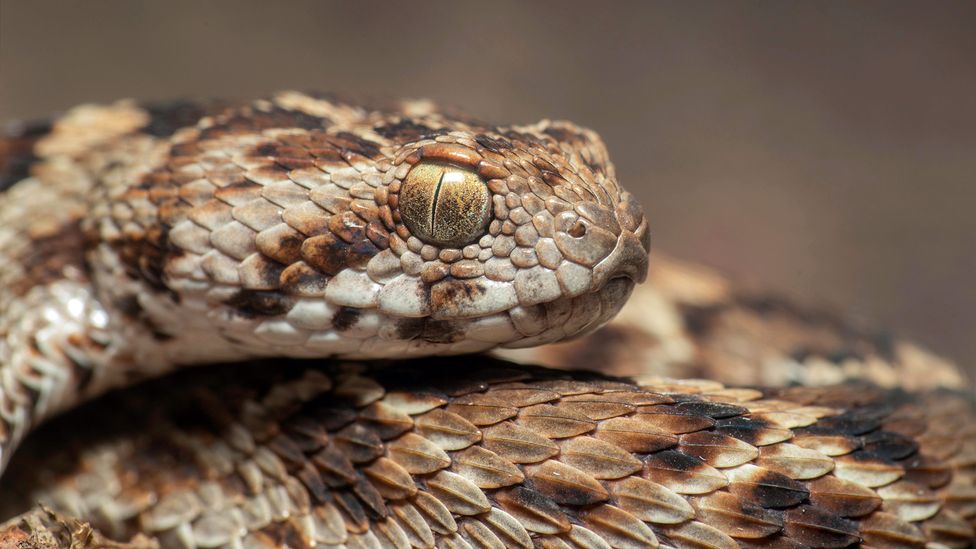
-
"In the monsoon, the fields are overgrown with weeds," says Tukaram Rao, a farm labourer from the village of Rathnapuri in Karnataka, south-west India. "We have to walk out in the midst of those at night to turn on the water pump for the field. Sometimes if the water pipes are disjointed, we walk alongside the water pipe, feeling with our hands to fix it."

- With their drab colouring, Russell's vipers can be hard to spot in the dense undergrowth of agricultural fields (Credit: Alamy)
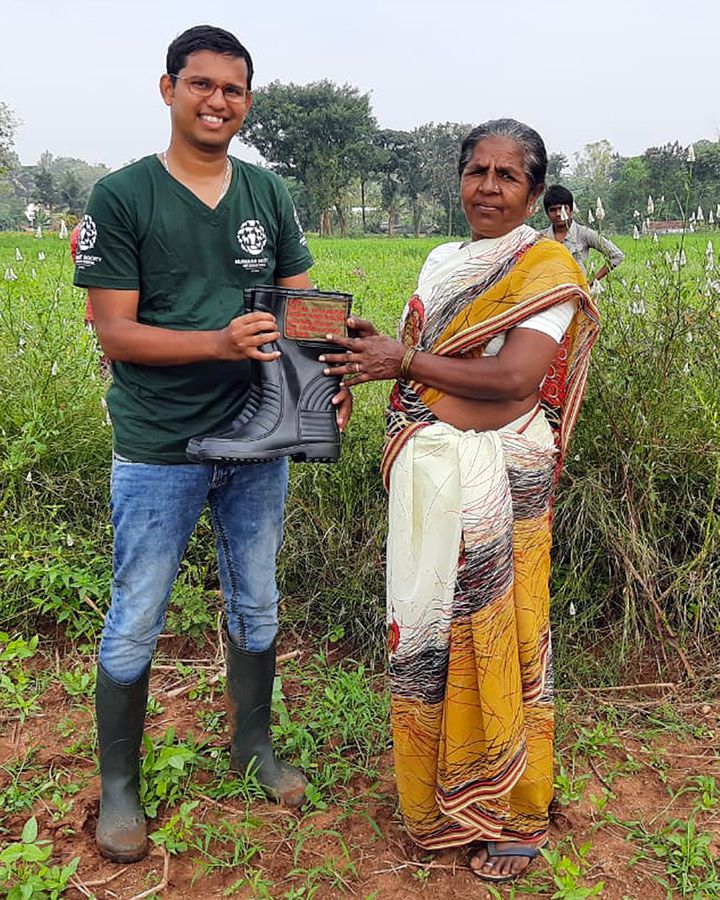
- The majority of snake bites in India occur as accidents when people tread on snakes they don't see – thick rubber boots can offer some protection (Credit: Sumanth Bindumadhav/HSI)
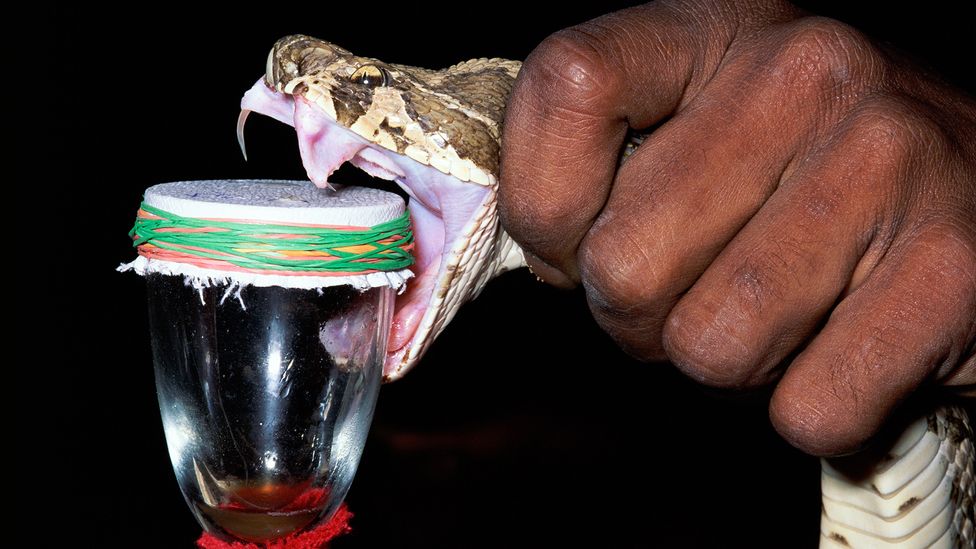
- Snakes are "milked" for venom in order to produce antivenom, but often these vital antidotes are in short supply in many parts of the world (Credit: Minden Pictuers/Alamy)
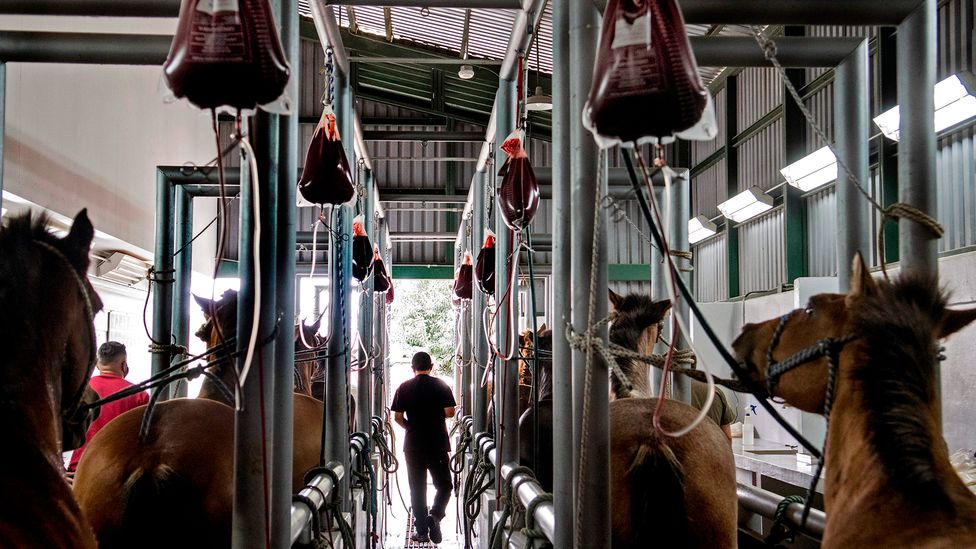
- Antivenom has been produced for over a century by injecting horses with venom so they generate antibodies against the toxins (Credit: Ezequiel Becerra/AFP/Getty Images)
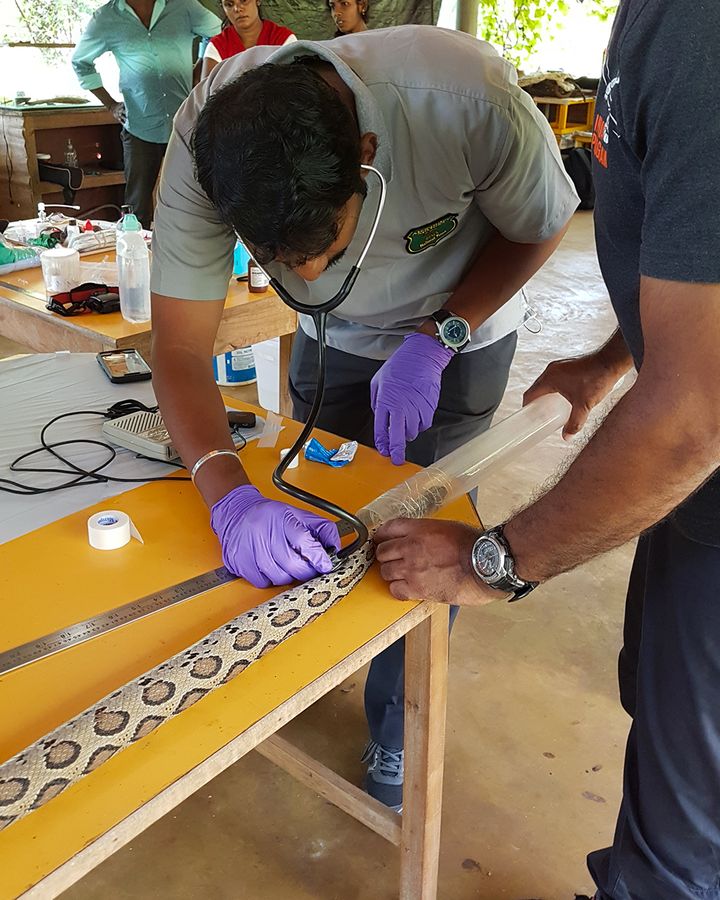
- Tagging snakes with radio trackers is helping researchers in India understand the behaviour of venomous snakes (Credit: Sumanth Bindumadhav/HSI)

- Inflammation caused by snake venom in a bite glows as hot spots on an infrared camera (left) compared to those without venom (Credit: P. Sabitha et al/Plos NTD)
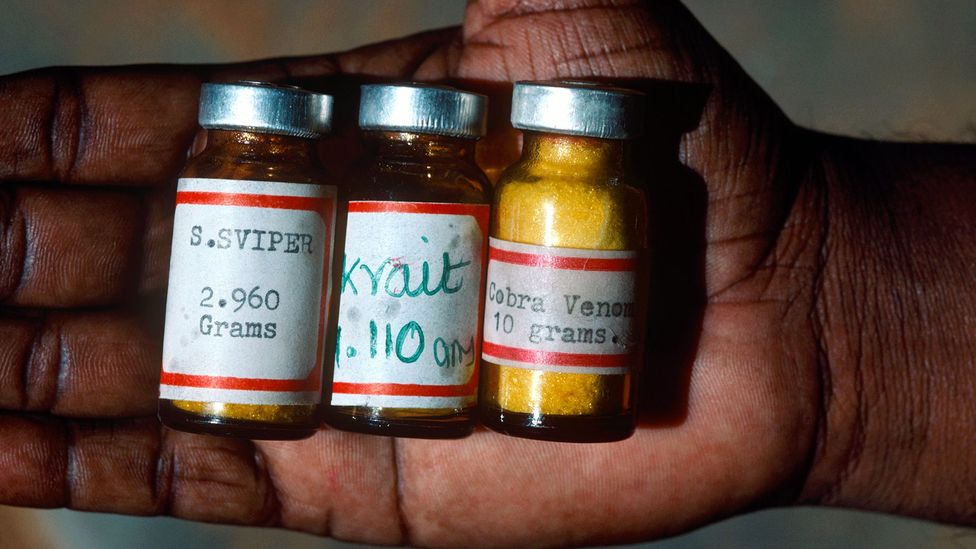
- Antivenom is highly specific to different species of snake and treating a bite can require several vials (Credit: Jeff Rotman/Alamy)
-
Like many farm workers in rural India, Rao and his neighbours tend to get around barefoot. But lurking in the thick undergrowth is something more worrisome than leaking water pipes. This is the perfect habitat for the Russell's viper, a large, earth-coloured and highly venomous snake found across much of India and other parts of South Asia.
These snakes are mainly active during the night and are masterful ambush predators, remaining motionless for long periods before striking ferociously at their prey. They mainly hunt rodents or small frogs that scurry into their path in the fields where they forage – these snakes are not interested in humans. Yet they account for more bites and deaths in India than any other species of snake. The Russell's viper is estimated to be responsible for as many as 43% of snake bites in India and is responsible for 30-40% of snake bites in Sri Lanka.
Much of the reason for this is how they hunt. Sluggish to the point of immobility, they inch their way through the grass, their green and brown camouflage making them almost invisible in daylight. At night, they are impossible to spot. For farmers working in paddy fields or among overgrown plants, the snakes are easy to step on or disturb. And when they feel threatened, the Russell's viper quickly becomes aggressive, striking out at random with its fangs.
-
"Sometimes they go away, sometimes we end up getting bit," says 48-year-old Rao about the snakes they encounter when working in the fields. Most villagers are scared of the snakes, he says and usually run away when they come across one in the field.
This fear is perhaps well founded. There are around 2.8 million cases of snake bites in India each year and 50,000 deaths. In the past two decades, more than 1.2 million people have died from snake bites in India alone, according to one recent analysis. Globally snake bites are thought to cause between 81,000 and 138,000 deaths each year, according to some estimates.
But the true impact of snake bites is greater still. A bite from a venomous snake can leave survivors with life-changing injuries. It is something Rao has seen first-hand.
"Another farmer was recently weeding his turmeric field when he accidentally got bit on his leg and the flesh around his ankle rotted away," he says. "The rot spread to his knee. Now he is unable to do any work." Doctors were eventually forced to amputate part of the unfortunate man's leg and his wife has had to take on extra work to provide for the family, Rao adds. It is not an uncommon story.
-
Of the estimated 4.5 million people who are bitten by snakes worldwide each year, around 2.7 million men, women and children are left seriously injured
-
"Three times as many victims – around 400,000 per year – are left with long-term disabilities such as limb necrosis leading to amputations, disfigurement and blindness," says Laura-Oana Albulescu, who studies snake venom at the Liverpool School of Tropical Medicine in the UK. "The psychological sequelae are only now being investigated but are significant as people can end up unable to work, destitute from the treatment cost, not fitting into their society – disabled young girls are not able to work or marry."
The global health burden created by snake bites is thought to be huge. Of the estimated 4.5 million people who are bitten by snakes worldwide each year, around 2.7 million men, women and children are left seriously injured, according to the Global Snakebite Initiative, a non-profit organisation aimed at addressing the problem of snake bites.
"Snake bites are a far bigger problem than many people realise," explains Leslie Boyer, founding director of the Venom Immunochemistry, Pharmacology and Emergency Response (Viper) Institute at the University of Arizona in the US. The World Health Organization considers snake bites to be such a burden on some communities that they recently classified snake bite envenomation – where venom is injected by a bite – as a neglected tropical disease.
You might also be interested in:
- Can India save its most elusive cat?
- The ingenious new tricks to beat disease
- The life saving medicines inspired by animals
Snake bites are now recognised as one of the world's most important neglected health problems and one that disproportionately affects poorer communities.
But should snake bites be such a large problem? "We've known how to make antivenoms for about 120 years," says Boyer, referring to some of the early work by scientists at the Pasteur Institute in France, the Lister Institute in England and the Butantan Institute in Brazil. While many antivenoms are relatively effective, the complex nature of snake venom can make treatment difficult. Access to antivenom can be patchy and treatments with it can be expensive.
This has led some to seek other ways of tackling the health burden caused by snake bites.
Rao and his neighbours are now involved in one such project aimed at helping the communities most at risk from snake bites to protect themselves. And the solution is deceptively simple – they are being given boots.
-
"Many people in rural parts of India are walking around in the dark without footwear," says Sumanth Bindumadhav, senior manager of the wildlife, disaster response and Dharwad program at the Humane Society International in India. "Over 90% of bites occur when people step on a snake without even seeing them."
His organisation has handed out more than 400 rubber boots and 200 solar lamps to residents in Rao's village and the surrounding area. "Putting a light in people's hands and footwear that will cover up to the ankle can seem simple, but it makes a big difference," says Bindumadhav. "The Russell's viper has some of the longest fangs of any snake in India, but it is very hard for them to penetrate gumboots. And preventing snake bites is better than treating them."
Snake venom is a complex cocktail of toxins that varies from species to species. Some of the enzymes and small proteins found in snake venom interfere with the signals sent by nerve cells. Depending on the exact toxin, these can lead to rapid, painful muscle contractions or paralysis. Victims often suffocate as the muscles controlling the respiratory system malfunction.
Other toxins, such as those found in black mamba venom, bind to heart muscle cells to prevent them from beating. Some toxins often found in viper venom cause victims to bleed to death by preventing blood clotting while others can cause blood cells to break down, starving victims of oxygen. There are toxins that cause the blood to coagulate in a bite victim's veins or attack the cells of key organs in the body. There are also venom toxins that trigger extreme inflammation or lead to necrosis, where the tissue on a limb dies and rots away.
-
Many snakes have a combination of different toxins that can cause a number of these effects at once. It means treating snake bites is no simple task.
"Any one snake bite contains hundreds of toxins in different proportions that vary by individual species," says Boyer. "You can't use a single small molecule drug against something like that."
Fortunately, antivenom is relatively easy to make, provided you have the know-how and access to some horses. At its most basic, antivenom is made by collecting venom from the snake you are interested in (a process known as "milking"), injecting a small amount into a horse and then collecting the antibodies it then produces. These are then purified and can be injected into bite victims to neutralise any venom toxins they encounter.
But it is not always effective and can require large amounts of antivenom as the number of antibodies in each dose can be low.
"Depending on the snake bite, it can take between one and 20 vials of antivenom, and there are cases in the US that have gone to 100 vials," says Boyer. In one study in South Africa, for example, snake bite victims received an average of five vials of antivenom each, but at some hospitals that figure was 19 vials per patient.
The low levels of antibodies that target venom toxins in antivenom can also lead to other problems such as anaphylactic shock as the patient's immune system reacts to the animal antibodies in the antidote – a condition known as serum sickness. "Unfortunately, only 15-20% of the antibodies are specific to and will neutralise venom toxins, hence the adverse reactions," says Albulescu.
Any one snake bite contains hundreds of toxins in different proportions that vary by individual species - Leslie Boyer
Antivenom can also be very expensive. Depending where you are in the world, a single vial can cost anything from $18-200 (£13-£145) in Sub-Saharan Africa to $17,000 (£12,362) in parts of the US. Boyer's own research group was instrumental in developing a rattlesnake antivenom sold in both Mexico and the US. It costs around $100-200 per vial (£73-£145) in Mexico but can cost several thousand dollars in the US. When she analysed the difference in costs between the two countries, Boyer found that much of the difference in price is due to the way healthcare is funded rather than production costs. "Developing and manufacturing antivenom is a very small piece of the pie," she says.
In Latin America, where venomous snakes are also a major problem, there has been a long history of domestic antivenom production from countries such as Mexico, Brazil and Argentina that has helped to keep prices low and a steady supply, says Boyer. But legal, regulatory and hospital costs, alongside the idiosyncrasies of the US medical insurance system have driven up prices 1,000-fold in the US. Relatively low demand for venom in the US and Europe – around 7,000-8,000 people are bitten by snakes in the US annually – also leads to higher prices.
This has knock-on effects for other parts of the world that have to rely on imported antivenom, Boyer adds. "It is difficult to rear horses in areas where there is African horse sickness, so many countries in Sub-Saharan Africa are reliant upon importing antivenom from Europe," she says. "Even though antivenom is cheaper there, it can still cost many times the annual wage of a worker."
India has some of the cheapest antivenom in the world, costing around $6.5-11 (£4.7-8) per vial, but problems with quality and availability often mean patients do not get the treatment they need.
"Every year there is a shortage of antivenom," says Bindumadhav. Rural communities particularly struggle to get treatment and are disproportionately hit by the consequences of snake bites due to the wider costs of treatment and loss of income that can result.
"It tends to be the lowest strata of society who are getting bitten in the countries with the highest number of snake bites," says Bindumadhav. "It is farmers and labourers rather than politicians and business leaders who are being bitten." This means the problem is largely overlooked.
Hospitals in India also primarily use a polyvalent (or multipurpose) antivenom as an antidote against the "big four" snakes that cause the majority of bites – the spectacled cobra, the common krait, saw-scaled viper and the Russell's viper. It is produced using venom from these four snakes. But India has more than 60 venomous species of snake and there is no specific antivenom against most of them. Instead, the "big four" antivenom is often used as a general snake bite treatment. Recent research has found, however, that it is largely ineffective against the venom of other important snakes in the country.
To compound the problem further, other research has shown that even among the big four, the toxins in the venom can vary depending on where in the country they are. It means that antivenom produced using snakes in southern India might be less effective against the venom from the same species in the north or those in Sri Lanka or Nepal.
The hope is these could lead to drugs that can be carried in first-aid kits as a way of reducing the potency of snake venom to buy victims some time
Recently the Wellcome Trust launched a major new initiative to develop new drug treatments for snake bites in an effort to address the shortcomings of current antivenom treatments. It estimates that just £57m ($79m) was invested into research on snake bites in the decade between 2008-2017. It has pledged to spend £80m ($110m) over seven years on new research.
Some researchers are focused on new antibody-based treatments that work against a wider range of snake venoms or induce less side effects. One approach has been to use camels instead of horses to make antivenom while others are attempting to manufacture human antibodies against snake venom, but both approaches are too expensive to yet be used commercially.
Instead, some researchers are turning to other types of drug treatments that can work against some of the nastier components of snake venom.
Albulescu is among them. She has found that a drug used to treat heavy metal poisoning in Germany called DMPS could be repurposed to be used as a first line intervention against the venom of saw-scaled vipers. This family of snakes, also known as carpet vipers, are found across Africa, the Middle East, India, Sri Lanka and Pakistan. When threatened they rub the scales on their body together to produce a distinctive sizzling sound, and they possess a highly toxic venom that contains enzymes known as metalloproteinases. These rely upon a zinc molecule in their structure to degrade the cell membranes of blood vessels and break down the structures there, leading to haemorrhaging that causes victims to bleed to death.
Albulescu found that DMPS can capture the zinc in the metalloproteases and stop them from functioning. "It's formulated as an oral capsule and can be administered easily in the field immediately after a bite," she says. "We propose its use as a first line intervention which can neutralise some of the venom toxicity and prevent the onset of systemic haemorrhage, buying the victim time." When DMPS was combined with a later antivenom treatment, Albulescu and her colleagues found survival in animal models increased to 100%.
Of course, transferring such a treatment into humans and into the imperfect world of real-life situations, where giving such drugs in a timely fashion might be difficult. And saw-scaled viper venoms contain other unpleasant toxins that DMPS does not act against.
Drugs that work against a wider range of snakes are also more desirable as often snake bite victims do not know exactly which species they have been bitten by. If the snake is misidentified, it can lead to inappropriate treatment.
Albulescu and her team have made some progress, finding a mixture of two other toxin inhibitors that appear to work against a wider range of viper venoms including the Terciopelo, or fer-de-lance, in Central America, the puff adder in Africa and the Indian saw-scaled viper. Another group at the University of Copenhagen in Denmark recently announced that they had developed a drug that works against the neurotoxins found in many snake venoms, including those of cobra.
The hope is eventually these could lead to drugs that can be easily stored and carried in first-aid kits as a way of reducing the potency of snake venom to buy victims some time.
"These are never going to be one-size-fits-all treatments," says Boyer. "But they could be a bridge to antivenom. It could help someone survive the trip to a hospital where they stock antivenom or protect a limb from necrotising damage. It might also reduce the amount of antivenom that is needed."
But she adds that many of these small molecule drug treatments have yet to be proved in clinical settings. And they too could suffer from the same economic pitfalls as antivenom unless efforts are taken to keep prices low. Instead, Boyer is more excited about innovations that are taking place outside of the laboratory to keep people safe from snake bites.
"These are more about sharing knowledge so people can take care of their own and educating people about snakes," she says.
One such example is the Asclepius Snakebite Foundation, an international group of researchers and medical professionals who train local doctors and nurses in Africa to manage snake bites alongside public health initiatives to help protect people from being bitten. They help local people understand where the risk of encountering snakes is high and how they can reduce them, such as moving debris away from houses. They also train motorcycle taxi drivers in basic snakebite first aid so they can transport patients from remote locations to treatment centres.
In India, the Humane Society International has also been working to train doctors in the region around Karnataka to deal with snake bites, but it is also trying to educate rural communities with simple ways to reduce their risk too.
The Indian krait, for example, is one of the "big four" snakes responsible for the majority of venomous bites in India. The venom of the common Indian krait can kill within a few hours and a higher proportion of its victims appear to die compared with other snakes. But it can be thwarted by a few simple steps, says Bindumadhav.
"It has a dubious reputation for biting people while they are asleep on the floor," he says. "A simple solution is to have a mosquito net hung from above and tucked under the mattress. In India a net like this costs a dollar. It is not expensive."
Knowing whether a bite victim has been envenomed is a challenge, particularly when antivenom treatments are in short supply
But Bindumadhav says there are other challenges. "There is still a tendency for some bite victims to be taken to a faith healer rather than to hospital," says Bindumadhav. "The Russell's viper doesn't always inject venom when it bites – these are dry bites but the panic they cause can lead to psychological symptoms instead. Then they appear to get better after a trip to the healer. Unfortunately, in those cases where venom is injected, it means their treatment is delayed."
Knowing whether a bite victim has been envenomed is a challenge, particularly when antivenom treatments are in short supply. Some researchers are working on techniques to help them identify whether a bite victim has been injected with venom by using thermal imaging cameras.
"Most snake venoms, and for that matter many other animal venoms, result in tissue inflammation at the site of a bite," says Tamilarasu Kadhiravan, a professor of medicine at the Jawaharlal Institute of Postgraduate Medical Education and Research in Puducherry, India. "Venom-induced inflammation is accompanied by an increase in skin temperature, which is seen as hotspots on infrared images."
He has found that the tissue around envenomated bites tends to be between 1-3C higher than the surrounding skin. He and his colleagues have used the technique to help identify which snakebite patients might need most attention.
"We treat 200-250 patients with snake bites every year," Kadhiravan says. "Antivenoms are a precious resource. Typically, in our setting, treatment with 20 vials of antivenom for a single patient costs about $70 (5,278 Indian Rupees/£51)." He says using an infrared imaging camera costs around $1 (75 Indian Rupees/£0.73) per patient. "If infrared imaging could prevent wasteful use of antivenom in situations where it is not really indicated, it could be used to treat more patients who actually need it."
Technology is also helping with identification of snake species themselves, which in turn can also help to make treatment more effective.
Doctors in Nepal and Switzerland, for example, have been developing genetic testing techniques to help identify the snake species responsible by analysing swabs taken from bite marks. While they found they could identify some of the species responsible, it only worked in around a quarter of cases and the technique still takes too long to be used effectively in an emergency setting to identify snakes.
Instead, artificial intelligence could also offer some assistance by helping to identify snake species from photographs taken by eyewitnesses to a snake bite. Many victims of bystanders take images on their mobile phones to assist in identification, but unless a medical professional is trained to tell the difference between species, these can be of little use. Isabelle Bolon, a vet at the University of Geneva, in Switzerland, and her collaborators are developing an app that uses machine vision algorithms to automatically identify snake species. Knowing which species is responsible could not only ensure patients get the right treatment more quickly, but also help to build up a more accurate picture of which snakes are really responsible for bites.
In Rathnapuri, India, the Humane Society International in India have been working alongside the conservation initiative The Liana Trust to understand more about the snakes that live around the villages by learning about their behaviour. Working with locals, Bindumadhav and the team have attached radio tags to around 30 snakes, allowing them to track and record the snakes' behaviour over a three-year period.
"Every morning we find the snakes, look at what habitat they are in, whether they are shedding their skin or have just fed," he says. "We are looking at how close they are to where people are working, where they are moving. It is giving us a lot more accurate information that we need to help tell people how to avoid and respect the snakes."
Involving local people in this research has also been crucial as it is helping to overcome local resistance to the interventions they are attempting to introduce, says Bindumadhav. Farmers, for example, often prefer not to use boots or flashlights when working in the field as they impede their ability to move around or to do work quickly. Similar schemes to hand out boots in Africa have failed because villagers found the boots uncomfortable and as the rubber was valuable, they sold them off, says Albulescu. Boyer too has heard of similar problems.
For farmers like Tukaram Rao, knowing more about the snakes has helped to dispel much of the fear that surrounds them.
"Before this, we used to be very scared of snakes," he says. "We used to run away on seeing a snake or not work in that area at all. Now we have some basic knowledge. For example, when we go to work, we use a stick to check the area before we start working."
Rao had his own close encounter with a Russell's viper recently while walking from his house to secure his cows. "I first noticed something shining in the pathway," he says. "I asked my son to fetch a light and we drove it away."
He hopes that as they learn more about Russell's vipers and their behaviour, it could ultimately allow his community to live alongside the snakes rather than in conflict with them.
"Many people used to kill snakes on sight," he says. "But as we understand them better it could lead to fewer snakes being killed."
Bindumadhav's ambitions are greater still. He wants to make the entire district around the village free from snake bite deaths. "We are starting with a village," he says. "But we hope to scale it out to other districts. Snakes are misunderstood creatures – there is no reason anyone has to die from them."
* This article has been updated on 15 April 2021 to reflect an change in the estimate for spending on venom research. Recent research commissioned by the Wellcome Trust found £57m had been spent between 2008-2017 rather than its earlier estimate of £30m.
A wedding bomb, a letter and an unlikely suspect
-
Published
- A wedding bomb, a letter and an unlikely suspect - BBC News

-
After a massive search, police in India have arrested a college teacher in connection with a "wedding bomb" that killed a newly-married man and injured his wife. Soutik Biswas reports on how the investigation into a killing which shocked India took an unexpected turn.

A video grab of the Sahu's kitchen moments after the blast
The letter arrived in a stamped envelope on a hot summer morning in early April.
The sender had printed "Important Letter" on a piece of paper and addressed it to the police chief of Balangir, a rural district in Orissa state studded with temples and farms.
It was an anonymous and rather strangely-written letter containing 130 words printed in English on white foolscap. And it related to the recent wedding gift bomb murder in the district.
Soumya Sekhar Sahu, a 26-year-old software engineer, had been killed and his 22-year-old wife Reema seriously injured when he opened a parcel addressed to him, five days after their marriage in February.
Sahu's 85-year-old great aunt was also killed in the explosion at the family home in the sleepy town of Patnagarh.
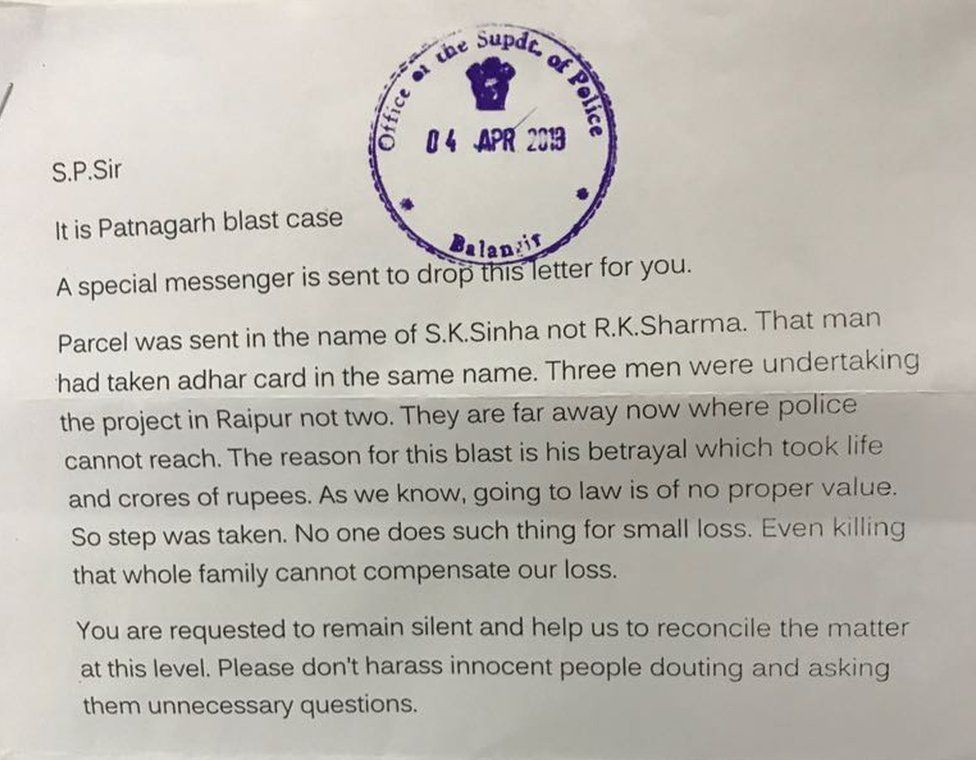
The anonymous letter provided the first clue
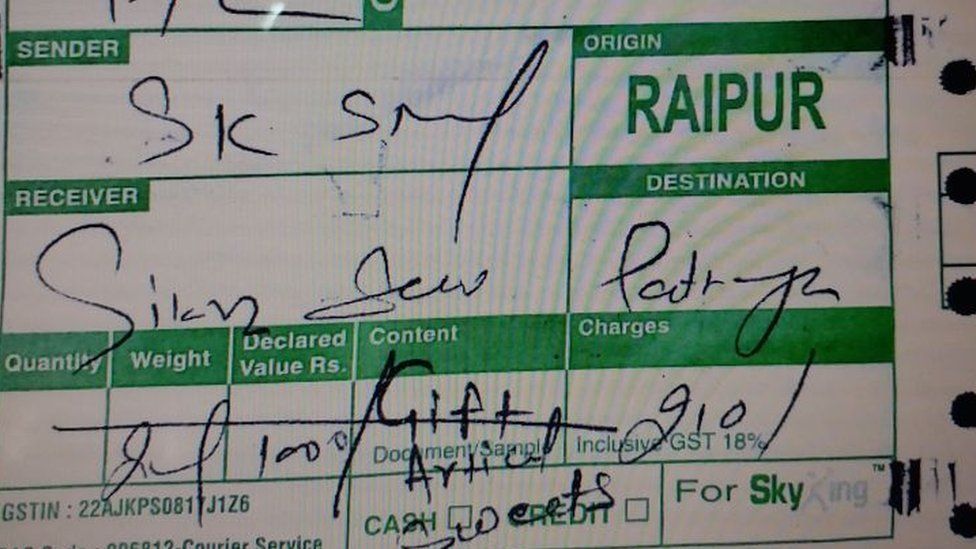
The police read the recipient's 'fake' name wrongly
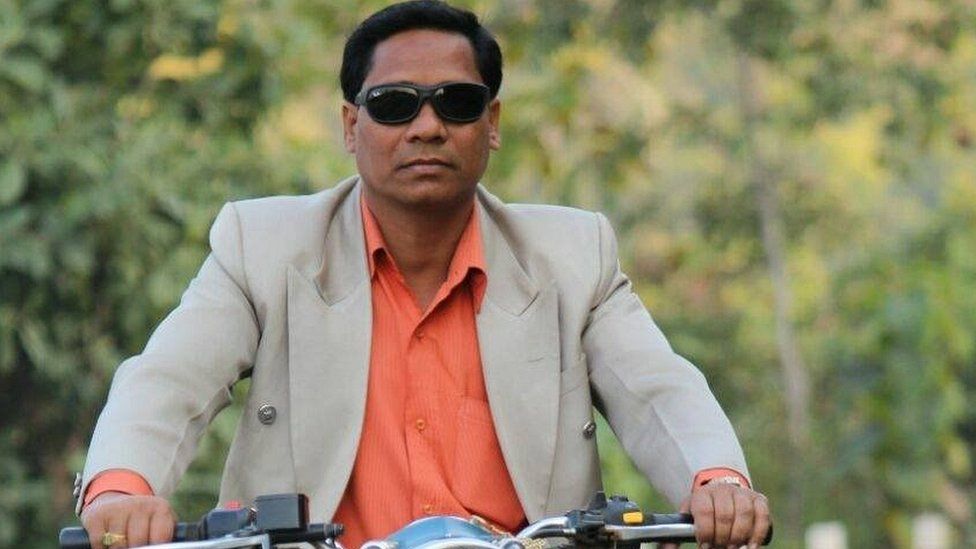
Mr Meher was replaced by the victim's mother as the principal of the college

More than 800 people attended the reception at Mr Sahu's house
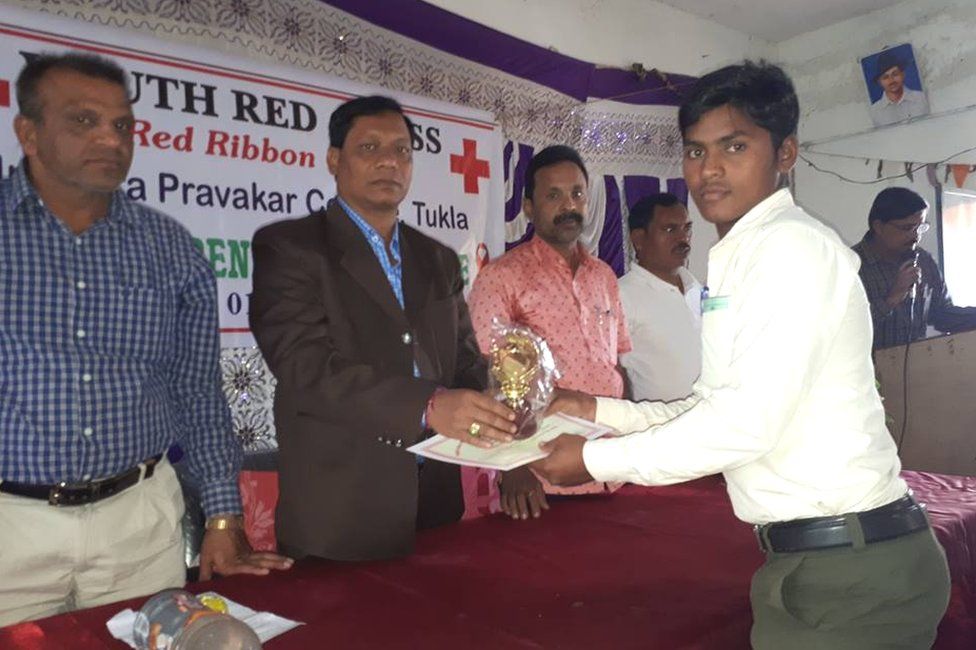
Mr Meher was a regular fixture at community events
Police said the parcel had been sent by someone called SK Sharma from Raipur, some 230km (142 miles) away in neighbouring Chhattisgarh state. Both the name and address were found to be fake, police say.
The letter they say was sent to the Balangir police chief began with the disclaimer that a "special messenger" had been sent by the writer to "drop this letter". And then, it came to the point quickly.
The parcel with the bomb had been sent in the name of SK Sinha, not RK Sharma, it said. Three men, it said, had "undertaken the project" and they "were far away now where police cannot reach". The reasons for the blast, the sender wrote with an awkward flourish, were the groom's "betrayal" and money. The first reason possibly alluded to a scorned lover, and the second to a property dispute.
"Even the killing of the whole family cannot compensate our loss," the sender wrote.
In the end, the tone turned forceful. The police, wrote the sender, should "remain silent" and "not harass innocent people, doubting and asking them unnecessary questions".
For more than a month, two dozen investigators questioned more than 100 people - friends and relatives of the couple mainly - in four cities in connection with the killing. They had scoured thousands of mobile phone records, and scanned laptops and phones belonging to the couple.
Investigators had looked into a threatening call the victim received last year after his engagement, and found out it was from a young man known to his then fiancée who had blamed her for "ditching him and getting engaged to a richer boy". Encouraged by the lead, they had picked up the man and questioned him. They let him go after they found nothing amiss beyond a "silly threat" on the phone.
Detectives had also drawn up a list of more than a dozen possible suspects, but had no firm leads on any of them. The case was going cold. As public and media pressure grew, the government handed the case over to the elite crime branch.
More than 300km (186 miles) away in the state capital, Bhubaneshwar, crime branch chief Arun Bothra received a scan of the letter on WhatsApp. Mr Bothra, a 50-year-old journalist-turned-policeman, was taking over the investigation.
"I read the letter the whole day and night. I must have read it a hundred times. It revealed a lot of things," he told me.
"It was clear that the sender knew more about the crime than we did. By writing that it was being sent by a messenger, he wanted to tell us that the crime was not the work of a local man. He wanted to tell us that the plot was executed by three people. He wanted to be taken seriously, so he was kind of blowing his fake cover by pointing out a mistake we had made," Mr Bothra said.
Mr Bothra sought records of the case. He found that the police had bungled while deciphering the parcel booking receipt - the untidy and hurried scrawl of the sender's name did not appear to resemble SK Sharma.
"If you observe the writing closely, the name is more akin to SK Sinha or SK Singh - look at the loop in the end. And the police, the media, the survivors all kept repeating the sender was SK Sharma. And since we knew he had used a fake name, we did not bother about it."
"I kind of instantly sensed the killer had himself sent the letter. How did he know that SK Sinha had sent the parcel? He had made a big mistake. The letter was the turning point in our investigation."
Forensic scientists say they found a number of faint, unhelpful fingerprints on the letter. They sent the envelope to extract a genetic profile from the saliva the sender may have used on the glue seam, but none was found.
Investigators sent a copy of the letter to the parents of the victim. They were asked whether they suspected anyone. The victim's mother, a teacher in a local college, went over the letter again and again.
"It was then the mother said this letter could have been written by a colleague of hers who taught English at the college. She said he had a similar writing style and choice of words. Then she said something interesting. She said the teacher would often use the phrase 'completing the project'," said Mr Bothra.
Workplace rivalry
Punji Lal Meher, 49, had been called in for questioning a week after the fatal blast. The victim's mother had told police that he harassed her after she replaced him as principal of the college last year. The two had reportedly humiliated each other in public, but in the end Mr Meher appeared to have swallowed his pride.
"We had really found nothing to pursue Mr Meher. There was never a lead really. We thought it was a case of usual workplace politics," one investigator told me.
In his Facebook posts, Mr Meher is usually dressed in formal suits and blazers, a mark of an upwardly mobile man. He wears a gold-coloured watch, a prominent gold ring, and shiny ties, belts and shoes. In one picture, he sits astride a motorcycle, wearing an orange shirt and sunglasses.
In other pictures, he is giving away medals at college functions, addressing an Aids awareness meeting, attending a yoga conference. His personal information details say he joined the college in 1996, became the principal in 2014. He's less prolific on Twitter. "There should be only one religion - the religion of humanity," he tweeted in February 2016.
It was time to rethink the case and bring in Mr Meher for questioning, Mr Bothra told investigators. So they did.
Mr Meher is alleged to have told police that he was out on his evening walk, when a man stopped him, gave him a letter and threatened to harm him if he didn't travel to Balangir town and deliver the letter.
"It was the most incredible story that we've heard from a suspect," says Mr Bothra.
According to police, Mr Meher said he began buying and hoarding firecrackers in October, when India celebrated Diwali, the festival of lights. He is alleged to have hoarded gunpowder from the crackers, from which they say he made the bomb. In a couple of months, it was ready, police say. They believe he then put it in a cardboard box and gift-wrapped it.
On a balmy morning in February, he was ready to send the bomb to its destination, investigators say.
He attended college in the morning, took a class, returned home, picked up the gift-wrapped parcel and went to the nearest railway station on his bike, leaving his Datsun sedan at home, it is alleged. He kept his phone at home in what police believe was an attempt to create an alibi that he never left his house. He then took the two-and-half-hour train journey to Raipur without a ticket to avoid being captured by CCTV cameras at the station ticket counter, police say.
The police theory is that in Raipur, he took a cycle rickshaw and then a tuk-tuk to visit two courier services before deciding on one located in a basement. According to reports, at the first shop a woman employee asked the rickshaw puller about the contents of the parcel. Mr Meher is alleged to have panicked, walked into the shop and took back the parcel. (The police are seeking to retrieve CCTV footage from the shop.)
After booking in the lethal parcel - with the contents given as "gift articles, sweets" - police say Mr Meher told them he took the evening train back and was in bed at home by midnight. In less than a week the parcel then made a 650km journey on three buses and passed through four pairs of hands before reaching Patnagarh on 20 February. Three days later, the bomb exploded in the Sahu house. Mr Meher attended the marriage - and funeral of the victim.
"I was consumed by rage and hatred. I could not swallow the humiliation," Mr Meher is alleged to have told the police last week.
Mr Meher is currently in police custody while the investigation continues, and is yet to enter a plea.
LAWSUIT FORCES CIA CONFESSION ON MK-ULTRA
https://www.cia.gov/
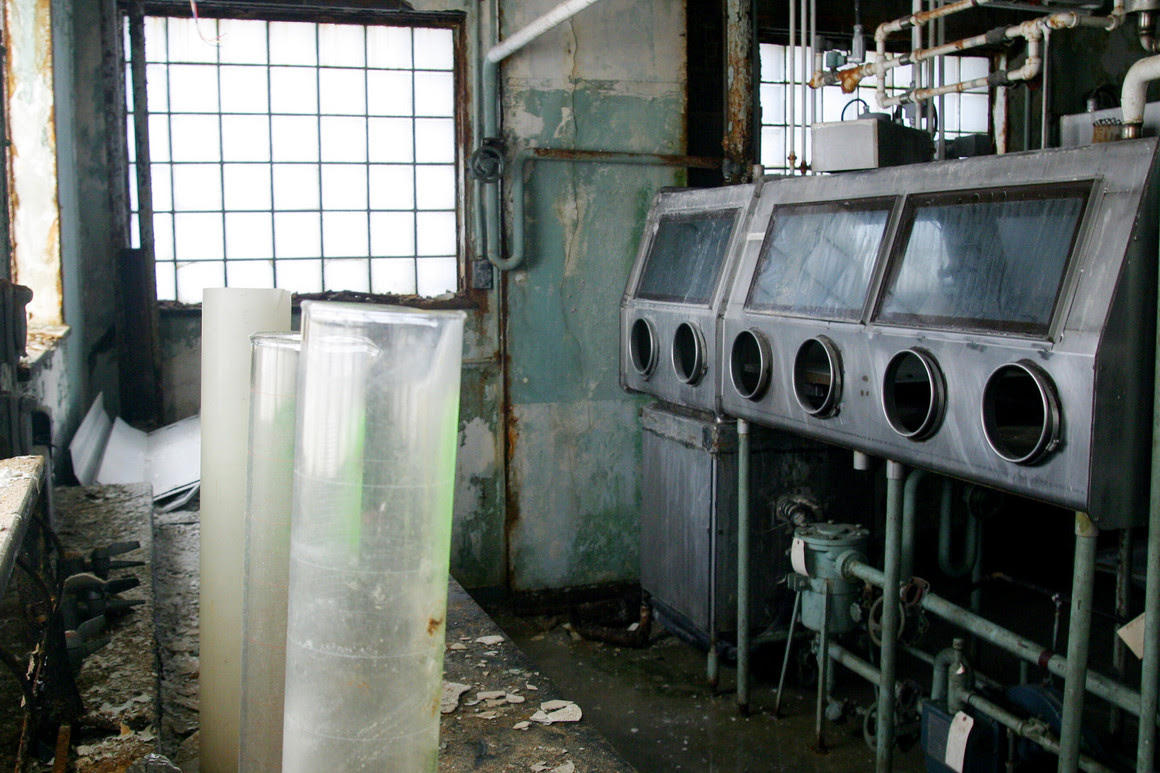
Building 470 on the campus of Fort Detrick in Frederick, Md
OPERATION MIND CONTROL - The CIA's Plot Against America
by Walter Bowart
The Secret History of Fort Detrick, the CIA’s Base for Mind Control Experiments
Today, it’s a cutting-edge lab. In the 1950s and 1960s, it was the center of the U.S. government’s darkest experiments.
In 1954, a prison doctor in Kentucky isolated seven black inmates and fed them “double, triple and quadruple” doses of LSD for 77 days straight. No one knows what became of the victims. They may have died without knowing they were part of the CIA’s highly secretive program to develop ways to control minds—a program based out of a little-known Army base with a dark past, Fort Detrick.
Suburban sprawl has engulfed Fort Detrick, an Army base 50 miles from Washington in the Maryland town of Frederick. Seventy-six years ago, however, when the Army selected Detrick as the place to develop its super-secret plans to wage germ warfare, the area around the base looked much different. In fact, it was chosen for its isolation. That’s because Detrick, still thriving today as the Army’s principal base for biological research and now encompassing nearly 600 buildings on 13,000 acres, was for years the nerve center of the CIA’s hidden chemical and mind control empire.
Detrick is today one of the world’s cutting-edge laboratories for research into toxins and antitoxins, the place where defenses are developed against every plague, from crop fungus to Ebola. Its leading role in the field is widely recognized. For decades, though, much of what went on at the base was a closely held secret. Directors of the CIA mind control program MK-ULTRA, which used Detrick as a key base, destroyed most of their records in 1973. Some of its secrets have been revealed in declassified documents, through interviews and as a result of congressional investigations. Together, those sources reveal Detrick’s central role in MK-ULTRA and in the manufacture of poisons intended to kill foreign leaders.
In 1942, alarmed by reports that Japanese forces were waging germ warfare in China, the Army decided to launch a secret program to develop biological weapons. It hired a University of Wisconsin biochemist, Ira Baldwin, to run the program and asked him to find a site for a new bio-research complex. Baldwin chose a mostly abandoned National Guard base below Catoctin Mountain called Detrick Field. On March 9, 1943, the Army announced that it had renamed the field Camp Detrick, designated it as headquarters of the Army Biological Warfare Laboratories and purchased several adjacent farms to provide extra room and privacy.
After World War II, Detrick faded in importance. The reason was simple: The United States had nuclear weapons, so developing biological ones no longer seemed urgent. As the Cold War began, however, two seemingly unrelated developments on opposite sides of the world stunned the newly created Central Intelligence Agency and gave Detrick a new mission.
The first was the show trial of the Roman Catholic Primate of Hungary Joseph Cardinal Mindszenty for treason in 1949. At the trial, the cardinal appeared disoriented, spoke in a monotone and confessed to crimes he had evidently not committed. Then, after the Korean War ended, it was revealed many American prisoners had signed statements criticizing the United States and, in some cases, confessing to war crimes. The CIA came up with the same explanation for both: brainwashing. Communists, the CIA concluded, must have developed a drug or technique that enabled them to control human minds. No evidence of this ever emerged, but the CIA fell hard for the fantasy.
In the spring of 1949 the Army created a small, super-secret team of chemists at Camp Detrick called the Special Operations Division. Its assignment was to find military uses for toxic bacteria. The coercive use of toxins was a new field, and chemists at the Special Operations Division had to decide how to begin their research.
At the same time, CIA had just established its own corps of chemical magicians. CIA officers in Europe and Asia were regularly capturing suspected enemy agents and wanted to develop new ways to draw prisoners in interrogation away from their identities, induce them to reveal secrets and perhaps even program them to commit acts against their will. Allen Dulles, who ran the CIA’s covert-operations directorate and would soon be promoted to direct the agency, considered his mind control project—first named Bluebird, then Artichoke, then MK-ULTRA—to be of supreme importance, the difference between the survival and extinction of the United States.
In 1951, Dulles hired a chemist to design and oversee a systematic search for the key to mind control. The man he chose, Sidney Gottlieb, was not part of the silver-spoon aristocracy from which most officers of the early CIA were recruited, but a 33-year-old Jew from an immigrant family who limped and stuttered. He also meditated, lived in a remote cabin without running water and rose before dawn to milk his goats.
Gottlieb wanted to use Detrick’s assets to propel his mind control project to new heights. He asked Dulles to negotiate an accord that would formalize the connection between the military and the CIA in this pursuit. Under the arrangement’s provisions, according to a later report, “CIA acquired the knowledge, skill, and facilities of the Army to develop biological weapons suited for CIA use.”
Taking advantage of this arrangement, Gottlieb created a hidden CIA enclave inside Camp Detrick. His handful of CIA chemists worked so closely with their comrades in the Special Operations Division that they became a single unit.
Some scientists outside the tight-knit group suspected what was happening. “Do you know what a ‘self-contained, off-the-shelf operation’ means?” one of them asked years later. “The CIA was running one in my lab. They were testing psychochemicals and running experiments in my labs and weren’t telling me.”
Gottlieb searched relentlessly for a way to blast away human minds so new ones could be implanted in their place. He tested an astonishing variety of drug combinations, often in conjunction with other torments like electroshock or sensory deprivation. In the United States, his victims were unwitting subjects at jails and hospitals, including a federal prison in Atlanta and an addiction research center in Lexington, Kentucky.
In Europe and East Asia, Gottlieb’s victims were prisoners in secret detention centers. One of those centers, built in the basement of a former villa in the German town of Kronberg, might have been the first secret CIA prison. While CIA scientists and their former Nazi comrades sat before a stone fireplace discussing the techniques of mind control, prisoners in basement cells were being prepared as subjects in brutal and sometimes fatal experiments.
These were the most gruesome experiments the U.S. government ever conducted on human beings. In one of the them, seven prisoners in Lexington, Kentucky, were given multiple doses of LSD for 77 days straight. In another, captured North Koreans were given depressant drugs, then dosed with potent stimulants and exposed to intense heat and electroshock while they were in the weakened state of transition. These experiments destroyed many minds and caused an unknown number of deaths. Many of the potions, pills and aerosols administered to victims were created at Detrick.
One of the most well-known victims of the MK-ULTRA experiments was Frank Olson. Olson was a CIA officer who had spent his entire career at Detrick and knew its deepest secrets. When he began musing about quitting the CIA, his comrades saw a security threat. Gottlieb summoned the team to a retreat and arranged for Olson to be drugged with LSD. A week later, Olson died in a plunge from a hotel window in New York. The CIA called it suicide. Olson’s family believes he was thrown from the window to prevent him from revealing what was brewing inside Camp Detrick.
A decade of intense experiments taught Gottlieb that there are indeed ways to destroy a human mind. He never, however, found a way to implant a new mind in the resulting void. The grail he sought eluded him. MK-ULTRA ended in failure in the early 1960s. “The conclusion from all these activities,” he admitted afterward, “was that it was very difficult to manipulate human behavior in this way.”
Nonetheless Fort Detrick, as it was renamed in 1956, remained Gottlieb’s chemical base. After the end of MK-ULTRA, he used it to develop and store the CIA’s arsenal of poisons. In his freezers, he kept biological agents that could cause diseases including smallpox, tuberculosis and anthrax as well as a number of organic toxins, including snake venom and paralytic shellfish poison. He developed poisons intended to kill Cuban leader Fidel Castro and Congolese leader Patrice Lumumba.
During this period, Fort Detrick’s public profile rose uncomfortably. No one knew the CIA was making poisons there, but its role as the country’s principal center for research into biological and anti-crop warfare became clear. From mid-1959 to mid-1960, protesters convened once a week at the gate. “No rationalization of ‘defense’ can justify the evil of mass destruction and disease,” they wrote in a statement.
In 1970, President Richard Nixon ordered all government agencies to destroy their supplies of biological toxins. Army scientists complied. Gottlieb hesitated. He had spent years assembling this deadly pharmacopeia and did not want to destroy it. After meeting with CIA Director Richard Helms, he reluctantly agreed that he had no choice.
One batch, a supremely potent shellfish poison known as saxitoxin, escaped destruction, though. Two canisters containing nearly 11 grams of saxitoxin—enough to kill 55,000 people—were in Gottlieb’s depot at Fort Detrick. Before Army technicians could remove them, two officers from the Special Operations Division packed them into the trunk of a car and drove them to the Navy Bureau of Medicine and Surgery in Washington, where the CIA maintained a small chemical warehouse. One of Gottlieb’s aides later testified that he had ordered this operation without informing his boss. By the time the saxitoxin was discovered and destroyed in 1975, Gottlieb had retired.
Gottlieb was the most powerful unknown American of the 20th century—unless there was someone else who conducted brutal experiments across three continents and had a license to kill issued by the U.S. government. Detrick, his indispensable base, still contains untold stories of the cruelty that began there—just 50 miles from the center of the government that has kept them sealed for decades. September 15, 2019
Brainwashed: The echoes of MK-ULTRA

Brainwashed: The echoes of MK-ULTRA
https://newsinteractives.cbc.
During the Cold War, the CIA secretly funded mind-control experiments on unwitting Canadians in a program codenamed MK-ULTRA. The experiments laid the groundwork for modern-day torture techniques. And victims and their families are still seeking recognition and justice.
By Michelle Shephard, Lisa Ellenwood and Chris Oke October 21, 2020
The following story is based on material from the CBC podcast Brainwashed, a six-part series co-produced with The Fifth Estate that investigates the CIA's covert mind-control experiments — from the Cold War and MK-ULTRA to the so-called U.S. war on terror. The series is available on CBC Listen, Apple Podcasts or Google Podcasts.
When Lloyd Schrier tells his story, it sounds more like a conspiracy than his family's tragic past.
But many of the details are laid out in a thick file of documents, correspondences and reports. He has news articles and pictures spanning decades, all describing what his family went through. And he has his mother's heartwrenching medical report that is still hard for him to comprehend.
"She had her 30th and last day of sleep on March 24th," Schrier said as he read from the 1960 hospital record.
"They gave her all the drugs … about four or five barbiturates and amphetamines at a time."
Esther Schrier received electroshock therapy, massive amounts of drugs and so-called psychiatric treatments that sound as if they were lifted from the pages of George Orwell's dystopian novel, Nineteen Eighty-Four.
She was a patient at Montreal’s Allan Memorial Institute in the 1960s. She had gone to "the Allan," as the hospital is known, to seek treatment for what today would be considered anxiety or postpartum depression.
But once she walked through those hospital doors and into the care of a psychiatrist named Dr. Ewen Cameron, she became an unwitting experiment subject for a massive CIA brainwashing operation codenamed MK-ULTRA.
And Schrier was part of this clandestine program, too, because his mother was pregnant with him at the time.
"It's crazy," said Schrier. "I don't think it was fair to do that to a developing fetus."
Lloyd Schrier tells the story of his family's tragic past as part of the CBC podcast Brainwashed. (Lisa Ellenwood/CBC)
Schrier is now 60 years old, semi-retired, living in Toronto and still fighting to be recognized as an experiment victim.
Hundreds of relatives whose loved ones were experimented upon by Cameron are now demanding compensation for family members and an apology from the Canadian government.
Canada has never provided a list of the victims of the experiments that took place during Cameron's tenure from 1943 to 1964. In the decades since, no government has ever admitted liability, let alone apologized — despite the fact that part of the experiments in Montreal were funded not only by the CIA, but also by the Canadian government.
"I think eventually they should come out with the truth. I think after all this time I don't know what they're trying to prove, who they're trying to protect. I don't think it's right," said Schrier. "I think they should come out and just, you know, deal with it."
To "deal with it" means acknowledging the legacy of a dark period that still reverberates today.
The idea of mind control has been constantly revisited by governments in periods of fear and uncertainty.
For Schrier and other relatives who have launched two separate lawsuits against the Canadian government and others, their mission is personal. They say their lives were irrevocably damaged by what happened. Families split up. Children were placed in foster homes. The trauma has been generational.
But the story of MK-ULTRA isn't just relegated to Cold War history.
The idea of mind control — the theory that breaking a person down will make them do something against their will — has been constantly revisited by governments during other periods of fear and uncertainty, when the military and medicine collide.
What happened at Montreal's Allan Memorial Institute laid the groundwork for torture spanning decades to follow.
Lloyd Schrier's mother, Esther, had a difficult childhood, losing both her parents at an early age. In 1936, when she was four years old, her father died. Slightly more than a year later, her mother was diagnosed with a brain tumour and given a lobotomy. Unable to look after her children, she was committed to a psychiatric institution.
Esther and her older brother were moved around from the care of relatives and to foster homes, and suffered wherever they went.
But she was resilient and smart. In her late teens, she trained as a nurse and got a job at the Jewish General Hospital in Montreal. She met her future husband, Haskell Schrier, on a blind date. After they married in 1955, the couple became a fixture in Montreal's Jewish social scene.
Three years later, after an uneventful pregnancy, she gave birth to their first child, a baby girl they named Lynn Carole. But the baby died of a staph infection when she was just three weeks old, and Esther struggled with her grief. Medical records show she felt she was responsible for her daughter's death.
When she was pregnant again, two years later, she was still struggling with this guilt. Part of her "condition" identified in her medical records when she was admitted to the Allan was her anxiety over possibly losing another baby.
Esther Schrier trained as a nurse in her late teens and worked at the Jewish General Hospital in Montreal. (Submitted by Lloyd Schrier)
Haskell Schrier had read an article about Cameron and was impressed by the Allan's reputation for offering cutting edge psychiatric care.
"Oh, 'He was God-like,' they would say," said Lloyd Schrier. "I think he was head of the Canadian and the American psychiatric associations. And even the World Psychiatric Association."
Cameron, a Scottish-born American psychiatrist, did hold all those titles at various points in his career, and he was the first director of the Allan.
What wasn't known, until many years later, was that Cameron's reputation also came to the attention of the CIA. They were interested in his psychiatric research that involved extreme sensory deprivation, drugs, and an intense repetition of recorded messages.
Three years after the CIA launched MK-ULTRA, they approached Cameron through the Society for the Investigation of Human Ecology, a research foundation and one of their front organizations through which they funnelled money. They encouraged him to apply for a grant, which he did, and quickly received. From January 1957 to September 1960, the CIA gave Cameron $60,000 US, equivalent to slightly more than $500,000 today.
Esther Schrier entered the hospital in February 1960 to receive what her family thought was the best care money could buy.
But her medical notes show disregard for her well-being and that of her unborn child right from the start.
She spent 30 days in what was called the "sleep room," a place where patients were put in a drug-induced coma and roused only for three feedings and bathroom breaks per day. She lost 13 pounds that month. Her records show she couldn't stand up because she was too weak.
She also underwent a treatment called "depatterning."
Medical notes show details of the treatment Esther Schrier received from Dr. Ewen Cameron in 1960. (Submitted by Lloyd Schrier)
Cameron believed that breaking down a patient's minds to a childlike state — through drugs and electroshock therapy — would allow him to work from a clean slate, whereby he could then reprogram the patients. Part of his reprogramming regime would involve what he dubbed "psychic driving," which meant playing recorded messages to the patients for up to 20 hours a day, whether they were asleep or awake.
These voices were played through headphones, helmets or speakers, sometimes installed right inside a patient's pillow. Records show some patients would hear these messages up to half a million times.
By March 12, 1960, Esther Schrier's medical records state that she was "considered completely depatterned." She was incontinent, mute and had trouble swallowing.
"That's crazy, to do that to a pregnant woman," said her son. "When she woke from the sleep room, she didn't know who my father was. She didn't know it was her husband. I guess she didn't know anything. You know, she used to tell me she had to relearn everything."
Lloyd Schrier remembers his mother telling him that among the many things she forgot was how to boil water.
Several times during her treatments, she developed gynecological symptoms. Her records indicate she started to bleed and they brought in an obstetrician to treat her.
They would let her rest for four or five days and then resume treatments. Cameron's notes say that on Aug. 17, 1960, six months after she entered the Allan, she had 29 electroshock treatments, with most of them of the extreme variety he was using. But because she was "now in her eighth month of pregnancy," the treatments stopped.
On Sept. 27, 1960, Lloyd was born, and Esther Schrier said she felt helpless. She couldn't remember basic life functions, let alone how to take care of a newborn.
Haskell and Esther Schrier, with their baby, Lloyd. (Submitted by Lloyd Schrier)
Years later, in a 2004 BBC Scotland interview, Esther Schrier recalled how lost she had been.
"I had a new baby, and I didn't know what to do with the baby. I had help, a baby nurse, but she had to have a day off and she left me a book, and I'll just give you a little example [from the book]: 'When you hear the baby cry, go to the room. Pick up baby and step by step how to feed the baby,' and that was very frightening."
Esther and Haskell Schrier are now deceased. She died of cancer in 2017 at the age of 84 and despite all she went through and what she lost, her son said she managed to live a full life and they remained close.
And he feels he was fortunate despite having lived under the dark shadow of what happened to his mother and uncertainty of how it impacted his health.
Many patients of Cameron emerged from the Allan completely broken, unable to find their way back to the lives they once lived. Relatives from across Canada have reached out to the CBC, describing the ongoing trauma the experiments have caused. Families were ripped apart by divorce or children were taken to foster homes. The grief rippled outward and spanned generations.
"I think I was lucky. I think the only side-effects that I know of, I guess in school, I was a bit slow in the beginning," said Lloyd Schrier.
"But I ended up going through high school, and I went, we have in Montreal CEGEP, I did the two years, and then I went on to McGill, and I did a bachelor of commerce. So … I was able to get my degrees and everything." But, he said, "I will never know what I could have been."
While MK-ULTRA officially ended in 1963, the mind-control experiments continued to echo into the early years of the 21s century, reaching from one amorphously named war to another: the Cold War to the U.S. war on terror.
Hundreds of captives who were rounded up after the Sept. 11, 2001, attacks ended up the U.S. offshore prison on the naval base at Guantanamo Bay, Cuba.
After the attacks of Sept. 11, 2001, hundreds of captives were held at the U.S. naval base in Guantanamo Bay, Cuba. (Michelle Shephard)
But the CIA was also holding those they considered "high-value detainees" in a network of secret prisons around the world that were collectively known as black sites.
These men were considered prized captives and their interrogators believed they might have information about impending attacks. They wanted answers, and they wanted them fast.
In 2002, in a secret CIA prison in Thailand, the FBI interrogated a prisoner named Abu Zubaydah. He had been shot and captured during a raid in Pakistan. The FBI had used traditional interrogation techniques, including what they termed "rapport-building," to try to earn his trust.
But the CIA didn’t think they were getting the answers they needed from him, so the agency turned to two psychologist contractors they had paid more than $80 million US to develop a new interrogation regime. It had been euphemistically named "enhanced interrogation techniques" and Abu Zubaydah was the first test case.
The "techniques" that psychologists James Mitchell and Bruce Jessen devised included waterboarding, sleep deprivation, confinement boxes, shackling and exposing detainees to extreme temperatures, sounds and pain.
The details of what happened to Abu Zubaydah are contained in the 6,700-page U.S. Senate intelligence committee report on torture, which was released in 2014, although only a 549-page executive summary has been declassified.
An excerpt: "After Abu Zubaydah had been in complete isolation for 47 days, the most aggressive interrogation phase began.… Security personnel entered the cell, shackled and hooded Abu Zubaydah.… The interrogators then removed the hood, performed an attention grab, and had Abu Zubaydah watch while a large confinement box was brought into the cell and laid on the floor."
The Senate report goes on to describe in detail how over 19 days of torture, on a "near 24-hour-per-day basis," he was waterboarded 83 times, placed in the coffin-like wooden box, held naked and his body contorted into stress positions.
The report states: "After the use of the enhanced interrogation techniques ended, CIA personnel at the detention site concluded that Abu Zubaydah had been truthful and that he did not possess any new terrorist threat information."
At least 118 detainees were subjected to this type of tortured interrogation.
"I think it's important [to note] that Mitchell and Jessen really were not the wizards that designed and imagined the program," said retired U.S. army general and psychiatrist Stephen Xenakis. "I do think that they were used by authorities above them in the agency and probably the White House to come up with something like that."
Xenakis specializes in treating post-traumatic stress disorder and has worked extensively with soldiers and veterans, as well as Guantanamo detainees and former captives from the CIA black sites.
"I think that essentially what they based their understanding on was bad science, completely not validated in any way," he said. "There’s no reason to think that it would have any positive effect to be useful."
And that "bad science" reaches all the way back to Cameron's work at the Allan.
WATCH | In 1980, The Fifth Estate interviewed two Canadians who went through the MK-ULTRA program:
OPERATION MIND CONTROL
As Kinzer notes in his book, even after MK-ULTRA was shut down, the CIA’s fascination about mind control continued. In the early 1960s, some of the experiments from MK-ULTRA were detailed in the CIA’s Kubark Counterintelligence Interrogation Manual.
Over 128 pages, the Kubark manual suggests interrogation methods, including "deprivation of sensory stimuli, threats and fear, pain, hypnosis and narcosis," and long sections devoted to sensory deprivation, which was drawn from "a number of experiments at McGill University."
Kubark relies directly on Cameron's work at McGill University, which the Allen is part of, and his theory that to make a mind malleable, you need to break it down to an infantile state.
By the 1980s, the CIA had devised the Human Resource Exploitation Training Manual (HRE), which was essentially an updated version of Kubark. As a Baltimore Sun investigation revealed in 1997, Honduran military forces accused of kidnapping, torture and murder had been trained by the CIA and were using the HRE.
Then came the so-called enhanced interrogation techniques.
"The idea that people were going to produce truthful information, valid information, in those states of mind had never, ever been established," said Xenakis.
"We knew from lots of records of PoWs – I, in fact in the '70s, interviewed a number of PoWs coming out of Vietnam – that they didn't produce good information when they were under high duress, when they were tortured. They just said what they needed to say to stop it."
Only twice in the years since Cameron experimented on psychiatric patients has their suffering been officially acknowledged. For the victims and their families, both times fell short of what they were seeking.
Nine patients of Cameron sued the CIA in the U.S. in the 1980s for their treatment as part of MK-ULTRA. It became a landmark case when it was settled out of court in 1988, and they received compensation, but the CIA did not accept any liability.
Esther Schrier could have been the 10th complainant but was too embarrassed to have people know about her mental health challenges.
WATCH | Bob Logie describes the experimental treatments he was given:
During the trial, it was exposed that the Canadian government had provided even more funding to Cameron, and for a longer period, than the CIA.
Eventually, in 1994, almost 20 years after the experiments were first publicly exposed, the Canadian government offered compensation for people who were experimented upon by Cameron from 1950 to 1965 (even though some believe Cameron started his experiments in the late 1940s). The patients had to prove they had experienced "full or substantial depatterning," to be eligible.
Seventy-seven former patients received $100,000 each. They were known as ex gratia payments, which essentially means giving compensation without the admission of liability.
Esther Schrier received a payment, but her son was rejected. Even after taking the case to the Federal Court of Canada in 1996, Lloyd Schrier was denied, with a judge upholding previous decisions saying that he was not a patient.
He received a letter from Allan Rock, who was the minister of justice and attorney general of Canada at the time.
"Payments under this plan are made on compassionate and humanitarian grounds to former patients," the letter said. "As the Government of Canada does not accept any liability or negligence for the treatment given to patients of Dr. Cameron, we have limited this payment to former patients. The government can only do so much and, therefore, limiting payments was necessary."
WATCH | How experiments at the Allan Memorial Institute affected a family:
Lloyd Schrier can’t see why he wouldn’t be eligible.
"When you look at the order it says they’re giving it on humanitarian grounds and I cannot see why I wouldn’t be included in that," he said.
"No one's taking any responsibility and I think they should."
Schrier is just one of hundreds of relatives who say they bear the emotional scars of those who were unwitting human experiment subjects of Cameron. They’ve recently found each other and came together after a 2017 story by the CBC's The Fifth Estate. Through two lawsuits against multiple defendants, including McGill University Health Centre, Royal Victoria Hospital and the attorney general of Canada, they are hoping to force the Canadian government into apologizing for its support of the experiments at the Allan.
But the Canadian government appears to have not changed its position. A spokesperson from the Department of Justice responded to an email from CBC, saying that Canada has already "taken action to provide assistance to those affected."
And McGill University seems to be trying to erase this history from its past. In the Allan Memorial Institute, a portrait of Cameron, who was the hospital's first director and leader for 21 years, still hangs in the halls alongside other past directors. But his name has been removed.
There is also no mention of this history on the university's official website. CBC asked the university why, and while a spokesperson did not answer the question directly, they wrote that they are "truly empathetic to those who were impacted."
FRIDAY, JUNE 21, 2013 THE BUSH FAMILY
https://aangirfan.blogspot.com/2013/06/the-bush-family.html
This above Blog has been removed,
however some of this blog attached below was saved in the INL News Group's Media Files
Sorry, the blog at aangirfan.blogspot.com has been removed. This address is not available for new blogs.
George W. Bush's great-great-great-great-grandfather, Thomas Walker, was a slave trader.
"There could not possibly have been a more inhuman monster than this Walker.
"Many a poor seaman has been brought by him to an untimely end."
In 1797, his own crew mutinied, shot him dead and threw him overboard.
Read more: http://www.dailymail.co.uk/
Brice Taylor, in her book, writes that George H W Bush was a child abuser.
Brice says that her daughter Kelly was abused by George H W Bush.
Brice writes:
"Over the years, Kelly was closely tied into the trauma I received.
"Repeatedly she was tortured and traumatized in front of me in an effort to keep me in line.
"Her torture fragmented her psyche in order to create multiple personalities within her, so she could follow in my footsteps for later use as a 'presidential model' ...
"George Bush, was/is a pedophile and Kelly was created to be, as I later found out from a renegade CIA operative, what was called a 'Bush Baby.'"
Cathy O'Brien describes how she and her daughter were hunted like animals - by George Bush - on Bob Hope's Jordan Ranch.
What about some other presidents?
"From an early age, Brice Taylor was prostituted as a mind controlled sex slave to Presidents John F. Kennedy, Lyndon Johnson, Richard Nixon, Gerald Ford and then Governor Ronald Reagan.
Thanks For The Memories - The Truth Has Set Me Free! /
File:Thanks for the Memories.pdf - WikiSpooks
Sidney Gottlieb (August 3, 1918 – March 7, 1999) was an American chemist and spymaster who headed the Central Intelligence Agency's 1950s and 1960s assassination attempts and mind-control program, known as Project MK Ultra
CIA Directors — Test your ‘Spy’ knowledge with our quiz!
Posted on February 23, 2017
https://gosint.wordpress.com/2017/02/23/cia-directors-test-your-spy-knowledge-with-our-quiz/
CIA Directors — Test your ‘Spy’ knowledge with our quiz!
Posted on February 23, 2017by L
How much do you know about spy agencies? Take this quiz to find out your knowledge of the CIA Directors. Follow us on Twitter: @Intel_Today
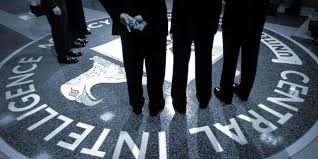
The Office of United States Director of Central Intelligence (DCI) was the head of the American Central Intelligence Agency from 1946 to 2005, acting as the principal intelligence advisor to the President of the United States and the United States National Security Council, as well as the coordinator of intelligence activities among and between the various U.S. intelligence agencies (collectively known as the Intelligence Community from 1981 onwards).
The office existed from January 1946 to April 21, 2005, and was replaced on that day by the Director of National Intelligence (DNI) as head of the Intelligence Community and the Director of the Central Intelligence Agency (D/CIA) as head of the CIA.
The Office of United States Director of Central Intelligence (DCI) was the head of the American Central Intelligence Agency from 1946 to 2005, acting as the principal intelligence advisor to the President of the United States and the United States National Security Council, as well as the coordinator of intelligence activities among and between the various U.S. intelligence agencies (collectively known as the Intelligence Community from 1981 onwards).
The office existed from January 1946 to April 21, 2005, and was replaced on that day by the Director of National Intelligence (DNI) as head of the Intelligence Community and the Director of the Central Intelligence Agency (D/CIA) as head of the CIA.
The list includes the following persons:
George H. W. Bush January 30, 1976 – January 20, 1977
William J. Casey, January 28, 1981 – January 29, 1987
Robert M. Gates (Acting) December 18, 1986 – May 26, 1987 & November 6, 1991 – January 20, 1993
Porter Goss September 24, 2004 – April 21, 2005 & April 21, 2005 – May 5, 2006
Michael Hayden May 30, 2006 – February 12, 2009
Leon Panetta February 13, 2009 – June 30, 2011
Michael Morell (Acting) July 1, 2011 – September 6, 2011 & November 9, 2012 – March 8, 2013
David Petraeus September 6, 2011 – November 9, 2012
John Brennan March 8, 2013 – January 20, 2017
Mike Pompeo January 23, 2017 – present
RELATED POST: Message from Director Pompeo to CIA Workforce
RELATED POST: CIA Director Mike Pompeo — Who Is Who in World Intelligence and Security Agencies?
Here are ten quotes from DCI and D/CIA. Can you identify them? Click on the right answer and it will appear in GREEN. If your choice pops up in RED, try again… Good luck!
1. Even when I was at CIA, I’d go to visit foreign leaders and I’d say, ‘You know, I’m not a diplomat. I’m just an old CIA guy’… I said, ‘If I wanted to be diplomatic, I’d have been a diplomat.’
Leon Panetta
Michael Hayden
David Petraeus
Robert M. Gates
2. My literal responsibility as director of the CIA with regard to covert action was to inform the Congress – not to seek their approval.
Michael Hayden
Robert M. Gates
David Petraeus
William Casey
3. I’m going to be so much better a president for having been at the CIA that you’re not going to believe it.
Michael Hayden
Mike Pompeo
George H. W. Bush
David Petraeus
4. You know, as director of the CIA, I got an awful lot of intelligence about all the horrible things that could go on across the world.
Mike Pompeo
Robert M. Gates
Porter Goss
Leon Panetta
5. Proud parents document the arrival and growth of their future CIA officer in all forms of social media that the world can access for decades to come.
Mike Pompeo
Michael Hayden
Porter Goss
David Petraeus
6. Effective, we were; efficient, we weren’t. And so, as director of the CIA, I went after the inefficiencies part.
George H. W. Bush
Leon Panetta
Micheal Hayden
Robert M. Gates
7. We’ll know our disinformation program is complete when everything the American public believes is false.
David Petraeus
Michael Hayden
William Casey
George H. W. Bush
8. The one thing that struck me right off the bat was what Donald Trump said about Benghazi.There is this view out there that [Hillary Clinton] lied about what caused the attack, that she said it was the video.
Michael Morell
Leon Panetta
David Petraeus
Mike Pompeo
9. We need to make sure that leaks of classified information, of national security secrets, needs to be rigorously pursued and prosecuted to the fullest extent of the law.
William Casey
Leon Panetta
John Brennan
Robert M. Gates
10. I couldn’t get a job with CIA today. I am not qualified.
Michael Hayden
George H. W. Bush
Leon Panetta
Porter Goss
RELATED POST: MOSSAD — Test your ‘SPY’ knowledge with our quiz!
The end…REFERENCES
Director of Central Intelligence — WIKIPEDIA
Director of the Central Intelligence Agency — WIKIPEDIA
Related
CIA Directors [DCI and D/CIA] -- Test your "Spy Knowledge" with our Quiz! [2018]In "CIA"
CIA D/NCS — Test Your ‘Spy’ Knowledge With Our Quiz! [UPDATE]In "CIA"
This entry was posted in CIA, CIA Director, QUIZ and tagged CIA Director, QUIZ. Bookmark the permalink.
← Ex-CIA Sabrina De Sousa Detained in Portugal — to be Extradited to Italy
An Introduction to French Intelligence Agencies →
2 Responses to CIA Directors — Test your ‘Spy’ knowledge with our quiz!
OPERATION MIND CONTROL by Walter Bowart
Walter Bowart was born in Omaha, Nebraska, in 1939. He was awarded a McMahon journal-ism scholarship to the University of Oklahoma and has since worked as an editor, publisher and writer. His articles have appeared in many journals including The East Village Other, the underground newspaper which he founded in 1965.
Walter Bowart lives in Tucson, Arizona, with his wife and three children.
Published in the U.S.A. by Dell Publishing Co., Inc. 1978
First published in Great Britain by Fontana 1978
This book is dedicated to those who are obedient to authority. May they follow in the path of Daniel Ellsberg, L. Fletcher Prouty, Victor Marchetti, John Marks, and George OToole, become responsible, and break free from the chains of command.
“ I know of no safe depository of the ultimate powers of society but the people themselves, and if we think them not enlightened enough to exercise their control with a wholesome discretion, the remedy is not to take it from them, but to inform their discretion by education” …. Thomas Jefferson
“In the technotronic society the trend would seem to be towards the aggregation of the individual support of millions of uncoordinated citizens, easily within reach of magnetic and attractive personalities effectively exploring the latest communication techniques to manipulate emotions and control reason,” …… Zbigniew Brzezinski, National Security Advisor to USA President Jimmy Carter
Author's Note
This book is an exercise in citizens' intelligence. The author and the majority of those who've contributed to it are private citizens working on their own in a synergistic effort, without major funding or corporate support, without government privilege or "need to know," other than that need cited by Jefferson—the need for informed discretion in a democracy. Without the help of these many people, who, like the author, were motivated by shock and outrage that citizens have been so victimized by their own government, this book would not have been undertaken.
Thanks first to the victims of mind control who had the courage to come forward and tell their stories.
A number of professional people gave valuable technical assistance and patient explanations. My thanks to Harry Arons, Robert Brauers, Dr. and Mrs. Sidney M. Cohen, Dr. Remo Dicenso, Betty Dumaine, Dr. Milton E. Erickson, Morris Ernst, Bernard Fensterwald, George Griffin, Col. Laird Guttersen, Dr. Paul Henshaw, Edward Hunter, Hon. Louis K. Lefkowitz, John MacDonald, V. R. Sanchez, Alan W. Sheftin, Dr. Edgar Schein, Mrs. E. D. Yeomans, and Col. Joseph H. Ziglinski.
I received a great deal of assistance from a number of researchers and writers around the world. Thanks to Chip Berlet, Nancy Bressler, Jeff Cohen, Loren Coleman, Richard Crowe, William Grimstad, Paul Hoch, L. Ron Hubbard, Larry Lee, Charles Maierson, John Marks, David McQueen, Sandra Meiersdorff, Janet Michaud, Beverly Ogden, George OToole, Richard Popkin, Jeff Quiros, William Stevenson, Scoop Sweeny, Harold Weisberg, David Williams, and Peter Watson.
Other valuable assistance was given by the following institutions and organizations: The Rare Books and Special Collections Division of Princeton University Library, Brain Mind Bulletin, Zodiac News Service, Freedom News Service, Pacific News Service, The Fifth Estate, Network Against Psychiatric Assault, The Assassination Information Bureau, American Society of Clinical Hypnosis, Sanity Now, Society for Clinical and Experimental Hypnosis, Center for National Security Studies, Group for the Advancement of Psychiatry, and the National Technical Information Service.
My understanding of the intelligence community was molded by exchanges with a number of intelligence and military people. They shall remain nameless. Special overt thanks to Colonel L. Fletcher Prouty, Michael Kradz and Alan Bell of Dektor Counterintelligence and Security, and Carl F. Boode of Desert Security. Tom Miller gave me much of his time and expertise, as Director of Research and citizens' counter-intelligence agent extraordinaire. He gave me research and editorial assistance and encouragement. Above and beyond the call he patiently listened to the vent of all my frustrations over a period of years. His interest in the subject never waned, and research for his own book
The Assassination Please Almanac (1977, Contemporary Books) uncovered leads for this one. Kudos to Dr. Robert M. Thomson, Johanna Moore G., Martha Sowerwine, my mother Fenna, and my wife Peggy for their patience and support.
I owe a special debt of gratitude to Richard Condon, who gave me early encouragement and offered his valued commentary. And to my editors Wendy Broad and Cynthia Vartan who burned midnight oil to polish this manuscript.
Last and foremost I am indebted to my Enid High School journalism teacher, Miss Ruth Scott, who, twenty years ago, started me on the path of citizens' intelligence. —Walter Bowart July 7, 1977 Tucson, Arizona
Contents
Foreword by Richard Condon 13
Chapter 1 The Cryptorian Candidate 19
Chapter 2 Only One Mind for My Country 27
Chapter 3 The Mind Laundry Myth 43
Chapter 4 Without Knowledge or Consent 59
Chapter 5 Pain-Drug Hypnosis 75
Chapter 6 The Guinea Pig Army 87
Chapter 7 The MKULTRANS 99
Chapter 8 The Mata Hari of Mind Control 115
Chapter 9 The Slaves Who Buried the Pharaoh .. 131
Chapter 10 Brave New World in a Skinner Box .. 151
Chapter 11 A School for Assassins 161
Chapter 12 The Four Faces of a Zombie 171
Chapter 13 The Lone Nuts 183
Chapter 14 The Ignored Confessions 197
Chapter 15 Another Hypno-Patsy?.... 205
Chapter 16 Confession by Automatic Writing 215
Chapter 17 The Patriotic Assassin 233
Chapter 18 Deep Probe 249
Chapter 19 From Bionic Woman to Stimulated Cat 261
Chapter 20 The Engines of Security 275
Appendix A Memorandum from Richard Helms to
- Lee Rankin, Warren Commission
Document 1131 285
Appendix B List of Drugs Tested by the CIA 289
Notes 293
Bibliography 297
Index 311
Reuters Article Confirms Ukrainian Biolabs are Creating High-Threat mRNA Pathogens
Karen Kingston from The Kingston Report
This is NOT Russian Disinformation
The existence of US-funded biolabs in the Ukraine creating highly-infectious viruses (mRNA pathogens) to target Russian civilians and create global pandemics is not “Russian-disinformation”. The REUTERS article confirms that the Ukraine was creating high-threat pathogens. Lieutenant General Kirillov confirms that these artificial viruses, or mRNA pathogens, are the cause of global pandemics, such as COVID-19.
The Russian military investigation confirms that COVID-19 and other pandemics are global operations that are well-planned out by the Pentagon (DTRA), USAID, US Intelligence Communities, NIH, EcoHealth Alliance, and that US pharmaceutical companies are involved. The Lieutenant General specifically mentions Pfizer and my med-legal analysis regarding their mRNA vaccine technology.
I hope government leaders and media outlets in the United States will express an interest in the med-legal analysis that is literally being used in the war room of a global military power to seize and destroy Pfizer’s mRNA bioweapon injections across Europe, Asia, and Africa soon….or, at least before it’s too late to save America and our children.
The Kingston Report. TRUTH WINS.
Reuters Article Confirms Ukrainian Biolabs are Creating High-Threat mRNA Pathogens
Karen Kingston from The Kingston Report
Ukraine biolabs are creating highly infectious mRNA viruses that are fueling global pandemics and killing millions of global civilians. Why is the United States funding Ukraine's biowarfare programs?
March 21, 2023: On March 11, 2023, REUTERS reported that, “The World Health Organization advised Ukraine to destroy high-threat pathogens housed in the country's public health laboratories to prevent "any potential spills" that would spread disease among the population.”
This REUTERS article now confirms the findings of the Russian biowarfare investigation, conducted by Lieutenant General Igor Kirillov, Military Chief of Russia’s Nuclear, Biological, and Chemical Protection Troops, that the Ukraine has been creating highly-infections pathogens (mRNA viruses) to target citizens of Russia, as well as to create global pandemics
The big question is, “Why is the United States supporting a country that has been creating bioweapons for use on global civilians? Shouldn’t the United States be supporting Russia, the nation that is trying to seize and destroy the bioweapons that are being used on global civilians?”
The answer is because President Biden is acting on behalf of the enemies of America. President Biden and his son Hunter helped fund the high-threat mRNA pathogens that causing the disabilities and death of millions of civilians around the globe.

The above is a screenshot from the WHO’s Disease Outbreak News. I added the image of the mRNA nanotech and brought to you by Pfizer logo on the right.
When discussing the cause of global pandemics, as announced by the World Health Organization, Lieutenant General Igor Kirillov states;
“In light of statements by the World Health Organization about outbreaks of Marburg fever, Lassa fever, anthrax, and cholera in different regions of the world, the extremely difficult situation with economically significant animal diseases; African swine fever, pathogenic avian influenza, foot-and-mouth disease.
The height of foolishness appears to be the work done at Boston University to INCREASE the PATHOGENIC PROPERTIES of pathogens, such as COVID-19, so-called “directed evolution,” changes that may or may NOT take tens or hundreds of years in nature, and to create ARTIFICIAL VIRUSES with a higher risk of infecting humans.
An analysis of documents, some of which were obtained during the special military operation, shows that such research on enhancing the functions of dangerous pathogens conducted, including in the states of Central Asia and Transcaucasia, is systematic, and large U.S. pharmaceutical companies are involved in its implementation.”
Lieutenant General Kirillov states that the cause of global pandemics are artificial viruses or pathogens (mRNA pathogens) created by labs funded by the US government and directed by the Pentagon’s DTRA (Defense Threat Reduction Agency). The US Pentagon (DTRA) was ‘conducting research’ using these highly-infectious mRNA pathogens on civilians in Transcaucasia.
Transcaucasia is an eastern European region that southern Russia is part of
This is NOT Russian Disinformation
The existence of US-funded biolabs in the Ukraine creating highly-infectious viruses (mRNA pathogens) to target Russian civilians and create global pandemics is not “Russian-disinformation”. The REUTERS article confirms that the Ukraine was creating high-threat pathogens. Lieutenant General Kirillov confirms that these artificial viruses, or mRNA pathogens, are the cause of global pandemics, such as COVID-19.
The Russian military investigation confirms that COVID-19 and other pandemics are global operations that are well-planned out by the Pentagon (DTRA), USAID, US Intelligence Communities, NIH, EcoHealth Alliance, and that US pharmaceutical companies are involved. The Lieutenant General specifically mentions Pfizer and my med-legal analysis regarding their mRNA vaccine technology.
I hope government leaders and media outlets in the United States will express an interest in the med-legal analysis that is literally being used in the war room of a global military power to seize and destroy Pfizer’s mRNA bioweapon injections across Europe, Asia, and Africa soon….or, at least before it’s too late to save America and our children.
The Kingston Report. TRUTH WINS.
Psalm 124: 2-5
If the Lord had not been on our side when people attacked us, they would have swallowed us alive when their anger flared against us; the flood would have engulfed us, the torrent would have swept over us, the raging waters would have swept us away.
The Kingston Report is reader-supported. Consider becoming a free or paid subscriber.
Expertise and Intelligence is Required to Win an Intelligence War
I’ve been fighting this psychological war to educate Americans and our government officials for two years now. If you want America to take control of this biowarfare nightmare, please reach out to government leaders and powerful media influencers to request for me to present the evidence that can take down Pfizer and stop the mRNA technology platform dead in its tracks. I can be reached through This email address is being protected from spambots. You need JavaScript enabled to view it.
If the Lord had not been on our side when people attacked us, they would have swallowed us alive when their anger flared against us; the flood would have engulfed us, the torrent would have swept over us, the raging waters would have swept us away.
The Kingston Report is reader-supported. Consider becoming a free or paid subscriber.
Expertise and Intelligence is Required to Win an Intelligence War
I’ve been fighting this psychological war to educate Americans and our government officials for two years now. If you want America to take control of this biowarfare nightmare, please reach out to government leaders and powerful media influencers to request for me to present the evidence that can take down Pfizer and stop the mRNA technology platform dead in its tracks. I can be reached through This email address is being protected from spambots. You need JavaScript enabled to view it.
Keep up the good fight!
The Goodness Inside
People often ask me for advice on supplements and medical treatments. I can’t make medical recommendations for you, but for me, I know that reducing the level of acid in your body and taking a supplement that contains zeolite can help remove toxic metals from your body
I use TouchStone Essentials Zeolite daily.
Thank you for reading The Kingston Report. This post is public so feel free to share it.
Fears mobster Patrick Irwin will try to retake control of West of Ireland drug scene after arrest over brutal attack on lawyer Alan Toal by Ken Foy Inpendent.ie
Gangster Patrick Irwin has been arrested by gardaí investigating a brutal assault on a now deceased barrister whose Porsche car was also stolen in the incident.Former garda Alan Toal’s body was discovered in his home in November where he had been living in fear after allegedly being attacked by Irwin in Tullamore, Co Offaly last August.
Foul play was quickly ruled out in the death of Mr Toal who lived near Arklow, Co Wicklow.
It is understood convicted drug dealer Irwin (41) spent a number of months outside the jurisdiction after the incident but he presented himself for questioning on his return and arrived at Tullamore garda station in Co Offaly on February 22.
He was detained there and questioned about the alleged assault on Mr Toal before being released without charge. A file will now be prepared for the Director of Public Prosecutions (DPP).
“There may be difficulties in this case as the alleged injured party is now deceased,” a source said.
It is understood Irwin has been based in his native Sligo since returning to the country, where it is feared he may try to reassert control over the drug-trafficking scene in the west of Ireland.
These concerns have been strengthened by the fact that one of his main rivals in the organised drugs trade in the west is currently locked up and facing the prospect of a lengthy jail term.
Last week, Barry Young (37) with an address of Geldof Drive, Cranmore, Co Sligo, pleaded guilty at the Special Criminal Court to directing a criminal organisation.
Young who is currently in custody in Portlaoise Prison, appeared before the three-judge, non-jury court last Friday where he replied “guilty” when the charge was put to him by the registrar.
“With Young locked up and other members of his gang under severe pressure at the moment from gardaí, there may be every likelihood Irwin and his crew see an opportunity. There’s a lot of money to be made,” a source said.
Mr Toal’s car has not been recovered by gardaí, but some sources have said it is suspected to be somewhere in Northern Ireland.
Irwin’s gang was the focus of a major operation by the Criminal Assets Bureau (CAB) in July last year in which one of Irwin’s key associates was raided in an operation in which drugs, cars and €24,000 cash were seized.
In 2012, CAB seized Irwin’s home in Dromahair, Co Leitrim. It was estimated by CAB to have cost €400,000 when built.
Irwin who had links to slain gang boss Eamon “The Don” Dunne and other dangerous Dublin-based gangsters was released from jail in August, 2018, after serving a consecutive 10-year jail sentence for drug dealing and savagely assaulting a garda.
His alleged victim, Mr Toal (60) had previously represented Irwin but the two men later had a dispute – understood to be about financial matters.
In an interview with the Irish Independent a fortnight after he was allegedly assaulted by Irwin, Mr Toal said his assailant threatened to kill him and burn down his home if he made a complaint to gardaí.
Mr Toal said despite the alleged threat, he had no hesitation in making a statement to gardaí which he said was eight pages long.
He said that if such behaviour was tolerated it would “erode the entire fabric of the criminal justice system”.
Mr Toal did not name Irwin, but gardaí are investigating claims the criminal headbutted and punched him in the restaurant of the Bridge House Hotel in Tullamore, Co Offaly, on August 18 before fleeing in the barrister’s Porsche Panamera.
Mr Toal had a consultation with clients at the hotel on the morning of August 18 and afterwards went to the premises’ restaurant, at which point it is alleged he was attacked.
“I was viciously confronted and assaulted by a notorious criminal alleging that I had been avoiding him over the past several years, among other matters, none of which were true, rather delusional,” he said in a statement to the Irish Independent.
“I sat, stared and smiled at this person as he assaulted me and assured me he would kill me and burn my house down if I made a complaint of his behaviour to the gardaí. These were not vacuous threats.”
Mr Toal said that after his assailant left, he found his car, which had his wig, gown and briefcase in the boot, had been stolen.
Bank of Ireland was the hardest hit among the Irish banks by midday, with shares plummeting 10.4pc. AIB shares were down 7.6pc. The two were the worst performing stocks on the Irish stock exchange.
Shares in insurer FBD also took a pouinding, falling 7pc.
Markets swing wildly as bank rescues fail to bring calm
McGrath sets up task force to monitor banks and tech after SVB collapse
The moves followed a strong bounce in financial stocks on Tuesday as contagion fears related to the collapse of SVB subsided and investors anticipated continued interest rate increases from the European Central Bank (ECB) on Thursday.
The Irish banks were part of a broader trend in European banks, as Credit Suisse dropped to fresh record lows after the lender's biggest shareholder said it could not raise its 10pc stake citing regulatory issues.
Credit Suisse fell below 2 Swiss francs for the first time after Saudi National Bank said it could not go above 10pc ownership due to a regulatory issue.
Credit Suisse shares were last down by more than 22pc. Trading in the shares was halted a number of times by the stock exchange operator as volumes soared and the stock plummeted.
An index of European bank stocks fell in morning trading and was last down 5pc, hitting its lowest level since January 4. The index has lost 13pc in value since last Wednesday, marking its biggest week-on-week loss since Russia's invasion of Ukraine last February.
"Markets are wild. We move from the problems of American banks to those of European banks, first of all Credit Suisse," said Carlo Franchini, head of institutional clients at Banca Ifigest in Milan.
"This is dragging lower the whole banking sector in Europe. The shares accelerated losses after the Saudis (commented) ...I believe Credit Suisse's crisis can be solved and the bank will not be let to go belly up," Franchini said.
Shares in Swiss bank UBS were last down 21pc.
Markets swing wildly as bank rescues fail to bring calm
McGrath sets up task force to monitor banks and tech after SVB collapse
Silicon Valley Bank fails in largest bank collapse since 2008 crisis | Banking | The Guardian
Please read full article below on this www.inltv.co.uk web page

Santa Clara police officers exit Silicon Valley Bank in Santa Clara, California.

INLNews.com United Arab Emirates Country Rank #274,588
https://inlnews.com/
inlnews.com/
Handy Easy Email and World News Links
GoogleSearch GMail YahooMail HotMail AOLMail
AustralianDailyNews wikipedia.org
INLNews rt.com AWNNews YahooMail HotMail
awn.bz-Illuminati-History (inltv.co.uk)
Trending stories on Indian Lifestyle, Culture, Relationships, Food, Travel, Entertainment, News and New Technology News - Indiatimes.com
From mind control to murder? How a deadly fall revealed the CIA’s darkest secrets
Frank Olson died in 1953, but, because of clandestine US government experiments, it took decades for his family to get closer to the truth Stephen Kinzer Fri 6 Sep 2019
Glass shattered high above Seventh Avenue in Manhattan before dawn on a cold November morning in 1953. Seconds later, a body hit the sidewalk. Jimmy, the doorman at the Statler hotel, was momentarily stunned. Then he turned and ran into the hotel lobby. “We got a jumper!” he shouted. “We got a jumper!”
The night manager peered up through the darkness at his hulking hotel. After a few moments, he picked out a curtain flapping through an open window. It turned out to be room 1018A. Two names were on the registration card: Frank Olson and Robert Lashbrook.
Police officers entered room 1018A with guns drawn. They saw no one. The window was open. They pushed open the door to the bathroom and found Lashbrook sitting on the toilet, head in hands. He had been sleeping, he said, and “I heard a noise and then I woke up.”
“The man that went out the window, what is his name?” one officer asked.
“Olson,” came the reply. “Frank Olson.”
“In all my years in the hotel business,” the night manager later reflected, “I never encountered a case where someone got up in the middle of the night, ran across a dark room in his underwear, avoiding two beds, and dove through a closed window with the shade and curtains drawn.”

The Statler Hotel in Manhattan. Photograph: Bettmann Archive
Leaving the police officers, the night manager returned to the lobby and, on a hunch, asked the telephone operator if any calls had recently been made from room 1018A. “Yes,” she replied – and she had eavesdropped, not an uncommon practice in an era when hotel phone calls were routed through a switchboard. Someone in the room had called a number on Long Island, which was listed as belonging to Dr Harold Abramson, a distinguished physician, less well known as an LSD expert and one of the CIA’s medical collaborators.
“Well, he’s gone,” the caller had said. Abramson replied: “Well, that’s too bad.”
To the first police officers on the scene, this seemed like another of the human tragedies they saw too often: a distressed or distraught man had taken his own life. They could not have known that the dead man and the survivor were scientists who helped direct one of the US government’s most highly classified intelligence programmes.
Early the next morning, one of Olson’s close colleagues drove to Maryland to break the terrible news to the dead man’s family. He told Alice Olson and her three children that Frank “fell or jumped” to his death from a hotel window. Naturally, they were shocked, but they had no choice other than to accept what they were told. Alice did not object when told that, given the condition of her husband’s body, family members should not view it. The funeral was held with a closed casket. There the case might have ended.
Decades later, however, spectacular revelations cast Olson’s death in a completely new light. First, the CIA admitted that, shortly before he died, Olson’s colleagues had lured him to a retreat and fed him LSD without his knowledge. Then it turned out that Olson had talked about leaving the CIA – and told his wife that he had made “a terrible mistake”. Slowly, a counter-narrative emerged: Olson was disturbed about his work and wanted to quit, leading his comrades to consider him a security risk. All of this led him to room 1018A.
* * *
Frank Olson had been one of the first scientists assigned to the secret US biological warfare laboratories at Fort Detrick in Frederick, Maryland during the second world war. There Olson began working with the handful of colleagues who would accompany him throughout his clandestine career. One was Harold Abramson. Others included ex-Nazi scientists who had been brought to work on secret missions in the US. For a time they worked on aerosol technologies – ways to spray germs or toxins on enemies and to defend against such attacks. Later, Olson met with American intelligence officers who had experimented with “truth drugs” in Europe.
Olson was discharged from the army in 1944, but remained at Fort Detrick on a civilian contract and continued his research into aerobiology. Several times he visited the secluded Dugway Proving Ground in Utah, which was used for testing “living biological agents, munitions and aerosol cloud production”. He co-authored a 220-page study entitled Experimental Airborne Infections, which described experiments with “airborne clouds of highly infectious agents”.
In 1949, he travelled to the Caribbean for Operation Harness, which tested the vulnerability of animals to toxic clouds. The next year, he was part of Operation Sea Spray, in which dust engineered to float like anthrax was released near San Francisco. He regularly travelled to Fort Terry, a secret army base on Plum Island, off the eastern tip of Long Island, which was used to test toxins too deadly to be brought on to the US mainland.
This was the period when senior army and CIA officers were becoming deeply alarmed at what they feared was Soviet progress toward mastering forms of warfare based on microbes. Their alarm led to the creation of the special operations division. Rumours about its work spread through offices and laboratories. Olson learned of it over an evening game of cards with a colleague, John Schwab, who unbeknown to him, had been named the division’s first chief. Schwab invited him to join. Olson accepted immediately.
Less than a year later, Olson succeeded Schwab as chief of the special operations division. His job description was vague but tantalising: collect data “of interest to the division, with particular emphasis on the medico-biological aspects”, and coordinate his work with “other agencies conducting work of a similar or related nature”. That meant the CIA.
Olson’s speciality was “the airborne distribution of biological germs”, according to one study. “Dr Olson had developed a range of lethal aerosols in handy sized containers. They were disguised as shaving cream and insect repellants. They contained, among other agents, staph enteroxin, a crippling food poison; the even more deadly Venezuelan equine encephalomyelitis; and most deadly of all, anthrax ... Further weapons he was working on included a cigarette lighter which gave out an almost instant lethal gas, a lipstick that would kill on contact with skin and a neat pocket spray for asthma sufferers that induced pneumonia.”

Frank Olson in 1952. Photograph: AP
By the time Olson stepped down as chief of the special operations division in early 1953, complaining that the pressures of the job aggravated his ulcers, he had joined the CIA. He stayed with the division, which was officially part of the army but functioned as a CIA research station hidden within a military base. There he came to know Sidney Gottlieb and his deputy, Robert Lashbrook, the two scientists who would soon be running a top-secret CIA project codenamed MK-Ultra.
Gottlieb was the CIA’s chief poison-maker. Over two decades, he oversaw medical experiments and “special interrogation” projects in which hundreds of people were tormented and many minds were permanently shattered. During this period, there was an obsession at the CIA: there is a way to control the human mind, and if it can be found, the prize will be nothing less than global mastery. MK-Ultra was a top secret programme of experiments in mind control that used, as its basic formula, doses of LSD given to “expendables”. Gottlieb wanted to discover how much LSD a human being could take. Could there be a breaking point, he wondered – a dose so massive that it would shatter the mind and blast away consciousness, leaving a void into which new impulses or even a new personality could be implanted?
In his laboratory at Fort Detrick, Olson directed experiments that involved gassing or poisoning laboratory animals. These experiences disturbed him. “He’d come to work in the morning and see piles of dead monkeys,” his son Eric later recalled. “That messes with you. He wasn’t the right guy for that.”
Olson also saw human beings suffer. Although not a torturer himself, he observed and monitored torture sessions in several countries.
“In CIA safe-houses in Germany,” according to one study, “Olson witnessed horrific brutal interrogations on a regular basis. Detainees who were deemed ‘expendable’ – suspected spies or moles, security leaks, etc – were literally interrogated to death in experimental methods combining drugs, hypnosis and torture, to attempt to master brainwashing techniques and memory erasing.” * * *
As Thanksgiving approached in 1953, Olson received an invitation to gather on Wednesday 18 November for a retreat at a cabin on Deep Creek Lake in western Maryland. This retreat was one in a series that Gottlieb convened every few months. Officially, it was a coming-together of two groups: four CIA scientists from the technical services staff, which ran MK-Ultra, and five army scientists from the special operations division of the chemical corps. In reality, these men worked so closely together that they comprised a single unit. They were comrades in search of cosmic secrets. It made sense for them to gather, discuss their projects and exchange ideas in a relaxed environment.
The first 24 hours at the retreat were uneventful. On Thursday evening, the group gathered for dinner and then settled back for a round of drinks. Lashbrook, Gottlieb’s deputy, produced a bottle of Cointreau and poured glasses for the company. Several, including Olson, drank heartily. After 20 minutes, Gottlieb asked if anyone was feeling odd. Several said they were. Gottlieb then told them their drinks had been spiked with LSD.
The news was not well received. Even in their altered state, the subjects could understand what had been done to them. Olson was especially upset. According to his son Eric, he became “quite agitated and was having a serious confusion with separating reality from fantasy”. Soon, though, he and the others were carried away into a hallucinatory world. Gottlieb later reported that they were “boisterous and laughing … unable to continue the meeting or engage in sensible conversations”. The next morning, they were in only slightly better shape. The meeting broke up. Olson headed back to Frederick. By the time he arrived, he was a changed man.
The next morning, 23 November, Olson showed up early at Fort Detrick. His boss, Vincent Ruwet, arrived soon after. Neither were in good shape. More than four days had passed since they had been given LSD without their knowledge. Ruwet later called it “the most frightening experience I have ever had or hope to have”.
Olson began pouring out his doubts and fears. “He appeared to be agitated, and asked me if I should fire him or he should quit,” Ruwet later recalled. Ruwet tried to calm him, assuring him that his work was excellent, and recognised as such. Slowly, Olson was persuaded that resignation was too extreme a reaction.
By this time MK-Ultra had been under way for seven months. It was one of the government’s deepest secrets, guarded by security that was, as Olson had been told when he joined the special operations division, “tighter than tight”. Barely two dozen men knew its true nature. Nine had been at Deep Creek Lake. Several of those had been surreptitiously dosed with LSD. Now one of them seemed out of control. This was no light matter for men who believed that the success or failure of MK-Ultra might determine the fate of the US, and all humanity.
Olson had spent 10 years at Fort Detrick and knew most, if not all, of the special operation division’s secrets. He had repeatedly visited Germany and brought home pictures from Heidelberg and Berlin, where the US military maintained clandestine interrogation centres. He was one of several special operations division scientists who were in France on 16 August 1951, when an entire French village, Pont-Saint-Esprit, was mysteriously seized by mass hysteria and violent delirium that afflicted more than 200 residents and caused several deaths; the cause was later determined to have been poisoning by ergot, the fungus from which LSD was derived. Perhaps most threatening of all, if US forces did indeed use biological weapons during the Korean war – for which there is circumstantial evidence but no proof – Olson would have known. The prospect that he might reveal any of what he had seen or done was terrifying.
“He was very, very open and not scared to say what he thought,” Olson’s friend and colleague Norman Cournoyer later recalled. “He did not give a damn. Frank Olson pulled no punches at any time … That’s what they were scared of, I am sure.”
Olson’s doubts deepened. In spring 1953, he visited the top-secret Microbiological Research Establishment at Porton Down in Wiltshire, where government scientists were studying the effects of sarin and other nerve gases. On 6 May, a volunteer subject, a 20-year-old soldier, was dosed with sarin there, began foaming at the mouth, collapsed into convulsions, and died an hour later. Afterward, Olson spoke about his discomfort with a psychiatrist who helped direct the research, William Sargant.
A month later, Olson was back in Germany. On that trip, according to a later reconstruction of his travels, Olson “visited a CIA safe house near Stuttgart [where] he saw men dying, often in agony, from the weapons he had made.” After stops in Scandinavia and Paris, he returned to Britain and visited Sargant again. Immediately after their meeting, Sargant wrote a report saying that Olson was “deeply disturbed over what he had seen in CIA safe houses in Germany” and “displayed symptoms of not wanting to keep secret what he had witnessed”. He sent his report to his superiors with the understanding that they would forward it to the CIA. Sargant said later: “There were common interests to protect.” * * *
Five days after being dosed with LSD, Olson was still disoriented. Ruwet, his boss at the special operations division, called Gottlieb to report this. Gottlieb asked him to bring Olson in for a chat. At their meeting, Gottlieb later testified, Olson seemed “confused in certain areas of his thinking”. He made a quick decision: Olson must be taken to New York City and delivered to the physician most intimately tied to MK-Ultra – Harold Abramson.
Alice Olson was told that Abramson was chosen because her husband “had to see a physician who had equal security clearance so he could talk freely”.
That was partly true. Abramson was not a psychiatrist, but he was an MK-Ultra initiate. Gottlieb knew that Abramson’s first loyalty was to MK-Ultra – or, as he would have put it, to the security of the US. That made him the ideal person to probe Olson’s inner mind. Olson told Abramson that ever since the Deep Creek Lake retreat, he had been unable to work well. He could not concentrate and forgot how to spell. He could not sleep. Abramson sought to reassure Olson, who seemed to relax afterwards.
A week had passed since Olson was given LSD at Deep Creek Lake. He planned to return to his family for Thanksgiving dinner. The day after seeing Abramson, accompanied by Lashbrook and Ruwet, he boarded a flight to Washington. An MK-Ultra colleague was waiting when they landed. Ruwet and Olson got into his car for the drive to Frederick. Soon after they set off, Olson’s mood changed. He asked that the car be stopped. Olson turned to Ruwet and announced that he felt “ashamed to meet his wife and family” because he was “so mixed up”.
“What do you want me to do?” Ruwet asked.
“Just let me go. Let me go off by myself.” “I can’t do that.”
“Well then, just turn me over to the police. They’re looking for me anyway.”
Ruwet suggested Olson return to New York for another session with Abramson. Olson agreed, so they took a taxi to Abramson’s weekend home on Long Island. Abramson spent about an hour with Olson, followed by 20 minutes with Lashbrook.
The next morning, Abramson, Lashbrook and Olson drove back to Manhattan. During a session at his Fifty-Eighth Street office, Abramson persuaded Olson that he should agree to be hospitalised as a voluntary patient at a Maryland sanatorium. Olson and Lashbrook left, registered at the Statler Hotel, and were given room 1018A.
Over dinner at the Statler, Olson told Lashbrook that he was looking forward to his hospitalisation. He mused about books he would read. Lashbrook later said he was “almost the Dr Olson I knew before the experiment”. The two returned to their room. Olson washed his socks in the sink, watched TV for a while and lay down to sleep.
At 2.25am, he went out the window. * * *
Every secret service needs officers who specialise in cleaning up messes. In the CIA of the 1950s, those officers worked for Sheffield Edwards at the Office of Security. The cover-up he directed in the hours and days after Frank Olson died was a model of brisk efficiency.
With the calm self-assurance for which he was known at the CIA, Edwards announced how the cover-up would unfold. First, the New York police would be persuaded not to investigate, and to cooperate in misleading the press. Second, a fake career – a “legend” – would be constructed for Lashbrook, who, as the sole witness, would be questioned by investigators and could under no circumstances be recognised as working for the CIA, much less MK-Ultra. Third, the Olson family would have to be informed, placated and kept cooperative.
While Alice, at home in Maryland, was being informed of her husband’s death, Lashbrook was welcoming the CIA cavalry to room 1018A at the Statler in New York. It took the form of a single officer. In internal reports, he is called “Agent James McC”. Later, he was identified as James McCord, who would go on to become a footnote to US political history as one of the Watergate burglars. McCord had previously been an FBI agent specialising in counterintelligence. Making police investigations evaporate was one of his specialities.
As soon as Edwards called McCord before dawn on 28 November, he swung into action. He took the first morning plane to New York and arrived at the Statler about 8am. He spent an hour questioning Lashbrook and then, at about 9.30am, advised him to go to the morgue at Bellevue hospital, as the police had requested, to identify Olson’s body. While he was away, McCord minutely searched room 1018A and nearby rooms.
Shortly after noon, Lashbrook returned to the Statler, where McCord was waiting. Over the next few hours, Lashbrook made a series of telephone calls. One was to Gottlieb. When he hung up, he told McCord that Gottlieb had instructed him to go to Abramson’s office, pick up a report and take it back to Washington by hand. Lashbrook carried Abramson’s report to Washington on the midnight train. CIA security officers in New York took care of the remaining details. The investigating police detective concluded that Olson had died from multiple fractures “subsequent upon a jump or fall”. That became the official narrative.
Despite the successful cover-up, Olson’s death was a near-disaster for the CIA. It came close to threatening the very existence of MK-Ultra.
Gottlieb and his bosses at the CIA might have taken this as a moment for reflection. In light of this death, they could have reasoned, further experiments with psychoactive drugs should be stopped, at least on unwitting subjects. Instead, they proceeded as if Olson’s death had never happened. * * *
On 12 June 1975, the Washington Post ran a story about an army scientist who had been drugged with LSD by the CIA, reacted badly and jumped out of the window of a New York hotel. This story, with its lurid mix of drugs, death and the CIA, proved irresistible. For the next several days, reporters barraged the CIA with demands to know more. The Olson family called a press conference in the family’s back yard. Alice read a statement saying that the family had decided to “file a lawsuit against the CIA, perhaps within two weeks, asking several million dollars in damages”. She insisted that her husband had “not acted irrational or sick” during the last days of his life, but was “very melancholy” and “said he was going to leave his job”.
“Since 1953, we have struggled to understand Frank Olson’s death as an inexplicable ‘suicide,’” she said. “The true nature of his death was concealed for 22 years.”
Besides announcing plans to sue the CIA, the Olson family also asked the New York police department to open a new investigation. The Manhattan district attorney, Robert Morgenthau, replied immediately, promising that his office would begin “looking into certain aspects” of the case.
Alarm bells went off at the White House after the Olson family announced its plan to sue the CIA. A lawsuit, if allowed to proceed, would give the family, as well as homicide detectives in New York, a tool they could use to force disclosure of deep secrets. President Ford’s chief of staff, Donald Rumsfeld, and his deputy, Dick Cheney, recognised the danger. Cheney warned Rumsfeld in a memo that a lawsuit might force the CIA “to disclose highly classified national security information”. To head off this disaster, he recommended that Ford make a public “expression of regret” and “express a willingness to meet personally with Mrs Olson and her children”.

President Ford (centre right) in the Oval Office with the Olson family. Photograph: Bettmann/Bettmann Archive
Ford took his aides’ advice. He invited Alice and her three adult children to the White House. On 21 July 1975, they met in the Oval Office. It was a unique historical moment: the only time an American president has ever summoned the family of a CIA officer who died violently and apologised on behalf of the US government. Later, they met with CIA director William Colby at the agency’s HQ in Langley, Virginia. He apologised for what he called a “terrible thing” that “should never have happened”.
“Some of our people were out of control in those days,” Colby said. “They went too far. There were problems of supervision and administration.”
White House lawyers offered the Olson family $750,000 in exchange for dropping its legal claims. After some hesitation, the family accepted. Congress passed a special bill approving the payment. And that would have closed the case if Frank Olson had remained quiet in his grave. * * *
At Olson’s funeral, Gottlieb had told grieving relatives that if they ever had questions about “what happened”, he would be happy to answer them. More than two decades later, at the end of 1984, they decided to accept his offer and called to arrange an appointment. When Alice, Eric and Nils Olson appeared at his door, his first reaction was relief.
“I’m so happy you don’t have a weapon,” Gottlieb said. “I had a dream last night that you all arrived at this door and shot me.”
Eric was taken aback. Later, he came to marvel at what he saw as Gottlieb’s manipulative power. “Before we even got through the door, we were apologising to him and reassuring him,” he said. “It was a brilliant and sophisticated way of turning the whole thing around.”
He began by telling the family what had happened at Deep Creek Lake on 19 November 1953. Olson and others were given LSD, he said, as part of an experiment to see “what would happen if a scientist were taken prisoner and drugged – would he divulge secret research and information?” Then he began musing about Olson. “Your father and I were very much alike,” he told Eric. “We both got into this because of patriotic feeling. But we both went a little too far, and we did things that we probably should not have done.”
That was as close to confession as Gottlieb ever came. He would not say what aspects of MK-Ultra went “a little too far”, or what he and Olson did that they “probably should not have done”. Nor would he entertain questions about inconsistencies in the story of Olson’s death. When Eric pressed him, he reacted sharply.
As the family were rising to leave, Gottlieb pulled Eric aside. “You are obviously very troubled by your father’s suicide,” he said. “Have you ever considered getting into a therapy group for people whose parents have committed suicide?” Eric did not follow that suggestion, but it left a deep impression on him. For years, he had been confused and depressed by the story of his father’s death. Only after meeting Gottlieb, however, did he resolve to bring his search for truth to the centre of his life.
“I didn’t have the confidence then in my scepticism to ignore his ploys, but when he made that therapy group suggestion – that was the moment when he overplayed his hand,” he said. “At that moment, I understood how much Gottlieb had a stake in defusing me. And it was also at that moment that the determination to show that he had played a role in murdering my father was born.”
Eric Olson waited another decade – until after his mother died – before taking his next step: arranging to exhume his father’s body. Several reporters stood near him as a backhoe clawed through the earth at Linden Hills cemetery in Frederick, Maryland, on 2 June 1994.
A forensic pathologist, James Starrs of George Washington University Law School, spent a month studying Olson’s body. When he was finished, he called a news conference. His tests for toxins in the body, he reported, had turned up nothing. The wound pattern, however, was curious. Starrs had found no glass shards on the victim’s head or neck, as might be expected if he had dived through a window. Most intriguingly, although Olson had reportedly landed on his back, the skull above his left eye was disfigured.
“I would venture to say that this hematoma is singular evidence of the possibility that Dr Olson was struck a stunning blow to the head by some person or instrument prior to his exiting through the window of room 1018A,” Starrs concluded. Later he was more emphatic: “I think Frank Olson was intentionally, deliberately, with malice aforethought, thrown out of that window.”
Besides conducting the autopsy, Starrs interviewed people connected to the case. One was Gottlieb. The two men met on a Sunday morning at Gottlieb’s home in Virginia. Starrs later wrote that it was “the most perplexing of all the interviews I conducted”.
Starr wrote: “I was emboldened to ask how he could so recklessly and cavalierly have jeopardised the lives of so many of his own men by the Deep Creek Lodge experiment with LSD. ‘Professor,’ he said without mincing a word, ‘you just do not understand. I had the security of this country in my hands.’ He did not say more, nor need he have done so. Nor did I, dumbfounded, offer a rejoinder. The means-end message was pellucidly clear. Risking the lives of the unwitting victims of the Deep Creek experiment was simply the necessary means to a greater good, the protection of the national security.”
Because Olson’s survivors had signed away their right to legal relief when they accepted their $750,000 compensation payment in 1975, they could not sue the CIA. Although Starr’s report and other discoveries sharpened Eric’s already powerful suspicion that foul play lay behind his father’s death, he could not prove it. Recognising that painful fact, he and his brother decided that it was finally time to reinter their father’s body. On 8 August 2002, the day before the reburial, he called reporters to his home and announced that he had reached a new conclusion about what had happened to his father.
“The death of Frank Olson on 28 November 1953 was a murder, not a suicide,” he declared. “This is not an LSD drug-experiment story, as it was represented in 1975. This is a biological warfare story. Frank Olson did not die because he was an experimental guinea pig who experienced a ‘bad trip’. He died because of concern that he would divulge information concerning a highly classified CIA interrogation program in the early 1950s, and concerning the use of biological weapons by the United States in the Korean War.”
Who killed the 20th century’s greatest spy? | Simon Parkin
In 2017, Stephen Saracco, a retired New York assistant district attorney who had investigated the Olson case and remained interested in it, made his first visit to the hotel room where Olson spent his final night. Looking around the room, Saracco said, raised the question of how Olson could have done it.
“If this would have been a suicide, it would have been very difficult to accomplish,” Saracco concluded. “There was motive to kill him. He knew the deepest, darkest secrets of the cold war. Would the American government kill an American citizen who was a scientist, who was working for the CIA and the army, if they thought he was a security risk? There are people who say: ‘Definitely.’”
This is an edited extract from Poisoner in Chief: Sidney Gottlieb and the CIA Search for Mind Control, published by Henry Holt & Co on 10 September and available at guardianbookshop.co.uk
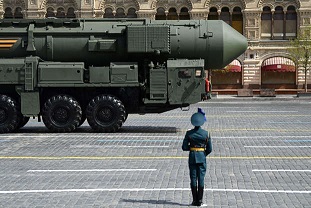
The Sarmat RS-28 is ready for action
In April 2022, Russia successfully launched its RS-28 Sarmat intercontinental ballistic missile, proving it now had the capability to strike anywhere in the world with ease.
.jpg)
Vladimir Putin's comments on the Sarmat RS-28
"This is a great, significant event in the development of promising weapons systems for the Russian army," Vladimir Putin said in a speech after the successful launch.
.jpg)
A truly unique weapon
"This truly unique weapon will strengthen the combat potential of our Armed Forces, reliably ensure the security of Russia from external threats and make those who, in the heat of frantic, aggressive rhetoric, try to threaten our country, think twice," Putin added.
.jpg)
Nicknamed the Satan II
Nicknamed the Satan II by NATO intelligence according to Business Insider, the RS-28 Sarmat is a truly terrifying weapon of war designed for maximum destruction.
.jpg)
A few details on Putin's new missile
"Measuring around 112 feet long and weighing just over 211 tons, the liquid-fuel ICBM is capable of carrying more than a dozen nuclear warheads, which can destroy entire cities,” wrote Business Insider’s Sophie Ankel, who pulled her information from Vice.
.jpg)
Multiple Independently Targetable Re-Entry Vehicles
“The warheads are known as Multiple Independently Targetable Re-Entry Vehicles,” Ankel added, “which means they can be sent to hit different targets at once.”
.jpg)
Hitting multiple targets at once
One RS-28 missile could theoretically hit multiple targets and Military Today broke down some of the Sarmat’s new multiple re-try warhead options.
.jpg)
What can it carry?
“It can carry 10 Multiple Independently-targetable Reentry Vehicles (MIRVs) with a blast yield of 0.75 MT each” Military Today wrote on their website.
.jpg)
Other alternatives
“Alternatively it can carry 16 smaller MIRVs, or up to 24 Avangard hypersonic glide vehicles,” Military Today added. “It is the first Russian missile capable of deploying these highly maneuverable vehicles.”
.jpg)
More difficult to intercept
The military website added that the RS-28’s penetration aids had been improved, which they believe would make the missile far more difficult to intercept.
.jpg)
How far can the Sarmat fly?
The RS-28 Sarmat is what the Center for Strategic Studies’ Missile Threat called a silo-based intercontinental ballistic missile and it has a range of 6200-11,000 miles.
.jpg)
Replacing Russia's aging nukes
Missile Threat noted that the RS-28 was designed to replace Russia’s aging R-36 silo-based missile, which was designed by the Soviet Union in the late 1960s.
.jpg)
A force of sheer destructive power
What sets the RS-28 apart from other long-range devices is its sheer destructive power. Not only can Putin’s newest intercontinental ballistic missile be used to launch multiple warheads at once but it can also be switched to drop a single 10,000-kilogram payload.
.jpg)
Comparing the RS-28 to the bomb that destroyed Hiroshima
To put that number into perspective, the bomb that destroyed the city of Hiroshima during World War II had a total payload of 64 kilograms of highly-enriched uranium according to data from the World Nuclear Associatio
.jpg)
The Satan II could destroy America
Alexei Zhuralev is a member of Russia’s Duma and explained how only a few RS-28 Sarmat intercontinental ballistic missiles would be needed to totally destroy the United States.
.jpg)
Only two Sarmat's needed to destroy the East Coast
“I will tell you absolutely competently that to destroy the entire East Coast of the United States, two Sarmat missiles are needed," Zhuravlev said during a May 2022 appearance on Russia-1 according to a translation from the New York Post.
.jpg)
The West Coast would need four
“And the same goes for the West Coast,” Zhuravlev added. “Four missiles, and there will be nothing left,” comments that might not be too off the mark if we look at Military Today’s estimates of the RS-28 Sarmat’s destructive capabilities
.jpg)
A single Sarmat could destroy three states...
“A single RS-28 missile with MIRVs can completely destroy 3 US states, such as Maryland, Vermont, and Rhode Island,” according to Military Today, a truly terrifying prospect for anyone opposing this deadly weapon.
Meet Satan II: the nuclear missile that gives Russia the edge over the United States (msn.com)
Silicon Valley Bank (SVB), the nation’s 16th largest bank, failed after depositors – mostly technology workers and venture capital-backed companies – hurried to withdraw their money this week as anxiety over the bank’s situation spread.
Global institutions including the Bank of England are monitoring the situation closely amid concerns that the turmoil could put customers’ deposits at risk and lead to further panic across the financial system.
“Fear is contagious,” said Angela Lee, a Columbia Business School professor of venture capitalism. “Bank runs can start on a rumor and this is much bigger than a rumor. I worry about folks overreacting to this and overcorrecting.”
SVB had prompted a global sell-off in banking stocks after it launched a rescue share sale to plug a near-$2bn (£1.7bn) hole in its finances.
The bank lost the funds when it sold a portfolio of bonds in response to a decline in customer deposits. Those bonds had dropped in value as a result of rising interest rates, leaving SVB with a shortfall.
Its US-listed shares initially plunged 60% on Thursday, and were halted on Friday after tumbling 66% in pre-market trading, before regulators stepped in.
The troubles facing SVB were relatively unique – given it serves startups in the tech sector, for which funding has dried up in recent months. Silicon Valley was heavily exposed to the tech industry and there is little chance of contagion in the banking sector similar to the chaos in the months leading up to the recession more than a decade ago. The biggest banks – those most likely to cause a systemic economic issue – have healthy balance sheets and plenty of capital.
However, those troubles raised broader fears that the recent increases in interest rates have affected the value of other banks’ bond portfolios, which tend to fall in price when interest rates rise.
There were concerns about how that could affect lenders’ capital levels, which are meant to offset riskier parts of banks’ balance sheets. Those fears prompted a drop in UK banking stocks, which the Bank of England’s regulatory arm, the Prudential Regulation Authority (PRA), is closely monitoring.
The Guardian understands the PRA is keeping an eye on market movements, and is speaking with firms it supervises – including high street banks such as Barclays, NatWest and Lloyds Banking Group – amid fears there could be further contagion from market jitters over the turmoil affecting SVB.
However, it is understood that the PRA believes that the UK banks it monitors are resilient, given that bond values are usually part of annual stress testing, and that most have seen their income rise as a result of higher interest rates in recent months.
It was not immediately clear what the implications for SVB’s UK operations would be, though its roughly 3,500 customers were understood to have been pulling deposits in light of the turmoil. That is despite the subsidiary having assured that its operations were “ringfenced” from the US parent firm, and that clients’ deposits were protected up to £85,000 by the Financial Services Compensation Scheme.
A Bank of England spokesperson said: “Silicon Valley Bank UK is supervised and authorised by the Prudential Regulation Authority. The UK bank has no personal retail depositors. We are aware of the issues impacting the firm and are closely engaging with it and overseas regulators.”
However, the troubles have raised broader fears that the recent increases in US interest rates have affected the value of other banks’ bond portfolios, which tend to fall in price when interest rates rise. The collapse of Silicon Valley pushed shares of almost all financial institutions lower on Friday.
Silicon Valley Bank’s failure arrived with incredible speed, with some industry analysts on Friday suggesting it was a good company and still probably a wise investment. Silicon Valley Bank executives were trying to raise capital early Friday and find additional investors. However, trading in the bank’s shares was halted before the opening bell due to extreme volatility.
Shortly before noon ET, the Federal Deposit Insurance Corporation moved to shutter the bank. Notably, the FDIC did not wait until the close of business to seize the bank, as is typical in an orderly wind down of a financial institution. The FDIC could not immediately find a buyer for the bank’s assets, signaling how fast depositors had cashed out. The bank’s remaining uninsured deposits will now be locked up in receivership.


The bank had $209bn in total assets at the time of failure, the FDIC said. It was unclear how much of its deposits were above the $250,000 insurance limit at the moment, but previous regulatory reports showed that much of Silicon Valley Bank’s deposits exceeded that limit.
As its name implied, Silicon Valley Bank was a major financial conduit between the technology sector, its founders and startups as well as its workers. Hundreds of companies held their operating capital with the bank, and it was seen as good business sense to develop a relationship with Silicon Valley Bank if a founder wanted to find new investors or go public.
“We saw building a relationship with Silicon Valley Bank as a logical step, given their reach,” said Ashley Tyrner, CEO of FarmboxRx, a company that delivers food and medicine to Medicaid and Medicare recipients. While Tyrner has money in other banks and can make payroll, she said a good portion of her business’s profits were now locked up with the bank.
But Silicon Valley’s connections to the tech sector became a liability rapidly. Technology stocks have been hit hard in the past 18 months after a growth surge during the pandemic and layoffs have spread throughout the industry.
Tyrner said she had spoken to several friends who are backed by venture capital. She described those friends as being “beside themselves” over the bank’s failure. Tyrner’s chief operating officer tried to withdraw her company’s funds on Thursday, but failed to do so in time.
“One friend said they couldn’t make payroll today and cried when they had to inform 200 employees because of this issue,” Tyrner said.
While the SVB meltdown is unlikely to have a major impact outside of tech, it is going to be “catastrophic” for startups, Columbia professor Lee said, and the broader Silicon Valley atmosphere.
“Startups are not able to access their funds and companies are going to go out of business to cover this,” she said. “The sentiment coming out of this is going to be devastating globally.”
The Associated Press contributed reporting
Crypto bank Silvergate announces liquidation amid sector turmoil
Wind-down and liquidation plan follows mass withdrawal of deposits after collapse of FTX exchange

The cryptocurrency-focused US lender Silvergate is to wind down its operations after it was hit by customer withdrawals following the collapse of crypto exchange FTX.
The California-based bank had warned last week it was “less than well capitalised” after depositors demanding their money back, adding that it was evaluating its ability to operate as a going concern.
Silvergate said a voluntary liquidation of the bank was “the best path forward” in light of “recent industry and regulatory developments”. The failure of FTX sparked renewed volatility in the crypto markets. Silvergate also revealed it was being investigated by the US Department of Justice.
Its wind-down and liquidation plan includes full repayment of deposits, the bank added. Silvergate reported a $1bn (£840m) loss for the fourth quarter of 2022 after investors raced to withdraw more than $8bn in deposits, forcing it to incur losses as it sold assets to cover the cost of the withdrawals.
Multiple partners of the bank, including Coinbase, a crypto exchange, and Galaxy Digital, a crypto-focused financial services company, cut their links with Silvergate last week. FTX and its affiliated trading arm, Alameda Research, had Silvergate accounts.
After Silvergate’s statement, Coinbase said it had no client or corporate cash at the lender. Changpeng Zhao, the chief executive of Binance, the world’s largest crypto exchange, said his company did not have any asset losses at Silvergate.
Founded in 1988, Silvergate ventured into crypto in 2013. The bank had also operated a mortgage warehouse business, but announced in December it would be winding down that division, citing the rising interest rate environment and reduction in mortgage volumes.
Last week, the bank discontinued the Silvergate Exchange Network (SEN), its crypto payments platform and one of its most popular offerings. That network enabled round-the-clock transfers between investors and crypto exchanges, unlike traditional bank wires, which can often take days to settle.
While risks of contagion are minimal, given that Silvergate has said it will repay depositors and has performing loans, the loss of SEN is disappointing, said Ram Ahluwalia, the chief executive of Lumida Wealth, an investment adviser that specialises in digital assets.
“It’s more of a strategic loss of critical infrastructure for crypto,” he told Reuters.
Federal prosecutors in Washington are investigating the company and its dealings with FTX and Alameda Research. In January, three US senators asked Silvergate for details about its risk management and FTX.
More than $1tn was wiped off the value of the crypto sector in 2022, as rising interest rates affected appetite for riskier assets.
After rapid growth in 2020 and 2021, bitcoin, the most popular cryptocurrency by far, fell more than 60% last year, pressuring the digital assets industry. Bitcoin fell below $16,000 after FTX’s collapse in November, but has since recovered to about $21,000.
“It’s more of a strategic loss of critical infrastructure for crypto,” he told Reuters.
Pat Phelan, co-founder and CEO of Sisu Clinic, said he realised early last week that the falling stock of SVB was something he needed to keep his eye on.
On Friday, US regulators pulled the plug on SVB – a key lender to US startups since the 1980s – after a run on deposits made it no longer tenable for the medium-sized bank to stay afloat on its own.
US Treasury Secretary Janet Yellen today said the government wanted to avoid financial “contagion” from the implosion of the Silicon Valley Bank but ruled out a bailout of the institution.
The Ireland Strategic Investment Fund (ISIF) has said the around $100m it had invested in five funds managed by SVB Capital, a subsidiary of the Silicon Valley Bank (SVB) Financial Group, would not be impacted by the panic that had started on Thursday with a massive drop in share price and a subsequent share sale.
“This means ISIF does not expect any impact on these investments arising from SVB Financial Group’s announcement that it will issue additional shares in the group,” a spokesperson for ISIF told RTÉ.
“The distributions received by ISIF from these investments since 2012 exceed the amount currently invested.”
Pat Phelan told RTÉ’s This Week: “I started looking at their [SVB] stock price, and it started dropping quickly and by Wednesday was in freefall, Thursday it was down 60%.”
Phelan said he had a lot of money on deposit in SVB because “we’re a venture-backed startup and the venture capitalists like you to use SVB”.
“Our experience, Ireland, tells you that it’s slow, and then it’s fast,” said Whelan.
“But I don’t think anyone could have predicted that a top 20 bank in the US, the banker of start-ups, could be gone in 24 hours.”
The Sisu Clinic co-founder told RTÉ he became “obsessive” about the stock price on Thursday afternoon and pulled “millions” from the bank on Thursday night.
“I thought ‘this is too risky’ and we pulled our companies millions out of there on Thursday night via WhatsApp.
“I had wake up the world, we’re going to need multiple signatures on this and empty the account.
“I knew that we were guaranteed to $250k but that was just a fraction of what it was.”
Crisis measures put in place by the Federal Deposit Insurance Corporation (FDIC) protects customers with up to $250,000 in deposits with the bank.
SVB is expected to reopen on Monday under a new name, with billions in customer deposits now under FDIC control.
“We pulled it all out,” said Phelan, “and I started dealing with calls from friends who are in the startup world, ‘what do you think?’
“I said, ‘I’m pulling, I’ve gone’, I couldn’t take this level of risk and we just shifted it back to our Bank of Ireland dollar account.”
‘Going to get stung’
However, Phelan told This Week that the “worst part” has been getting calls from people in Irish companies that left money in the now collapsed bank.
“I was talking to one person in particular, who runs a very successful Irish company, and has $8 million that they have no access to today.
“And then you look at Twitter this morning where the big venture capitalists are saying that this needs to be the government now, because their companies don’t have money to make payroll next week.”
He warned that “a huge amount of startups are going to get stung”.
“On Monday, you’ll see startup CEOs beginning to panic,” said Phelan.
“And I think what you’re going to see is probably contagion coming into Bitcoin as well – probably a considerable drop in Bitcoin values.”
Bitcoin is the leading form of cryptocurrency and other cryptocurrencies have been rattled by the collapse of SVP.
The supposedly “stable” cryptocurrency USDC fell sharply after the firm that created it, Circle, announced it holds $3.3 billion in SVB.
The USD Coin, or USDC, was launched in 2018 as a “stablecoin,” meaning it was indexed to a currency backed by a central bank, in this case the US dollar.
It is listed as the second largest “stable” currency worldwide, based on its volume in circulation (around $40 billion), behind Tether.
Stablecoins are supposed to be backed by equivalent reserves in immediately available assets, either cash or readily convertible financial securities.
Overnight Friday to Saturday, the USDC fell to its lowest level ever, dropping to 87 cents before recovering to around 94 cents.
-With additional reporting from AFP
A Dig Towards the Core of the Earth Uncovers a Lot of Scientific Secrets By Christine R. -16 January 2023
Source: Maternity Week

Source: Maternity Week
In a remote peninsula somewhere in Russia, a group of scientists has spent decades drilling down the ground to reach the center of the earth. But after decades of hard work, the team made a discovery that forced them to stop digging deeper.
In a remote peninsula somewhere in Russia, a group of scientists has spent decades drilling down the ground to reach the center of the earth. But after decades of hard work, the team made a discovery that forced them to stop digging deeper.
The ambitious goal to dig towards the center of the earth started with a competition between the USA and the USSR to conquer the subterranean world. We all know the space race between the two nations to conquer outer space but little was known about another race to dig as far into the Earth's crust as they possibly could.
You may think that dirt and rocks are not that compelling compared to the mystery of the cosmos but the Earth's crust leads the way to the mantle - the mysterious inner layer that makes up 40% of Earth's mass. What could that 40% be made of?

Source: Maternity Week
Project Mohole
You may think that dirt and rocks are not that compelling compared to the mystery of the cosmos but the Earth's crust leads the way to the mantle - the mysterious inner layer that makes up 40% of Earth's mass. What could that 40% be made of?

Source: Maternity Week
Project Mohole
Project Mohole was funded by the National Science Foundation. However, 8 years into the project, the funding was cut off by the US House of Representatives. Despite starting first, the Americans never got to the mantle.
Kola project
It took a while for the USSR team to start their project. In fact, it was not until May 24, 1970, that the Russians started drilling toward the center of the Earth.
They started drilling in the Pechengsky District, a low-populated area in the Kola Peninsula, Russia.

Source: Maternity Week
The Russian team had a simple goal – to dig as far as possible into the Earth's crust. Of course, they aimed to go further than the 600 feet that the American team achieved. In fact, the goal was a minimum of 49,000 feet.
Specialized equipment

Source: ResearchGate
Throughout the project, the Soviet team developed instruments that would help them take direct physical measurements at the bottom of the borehole. Because of this, they had greater measurement integrity. In 1974, the team upgraded to an Uralmash-15000.
The Bertha Rogers Hole
While all of this is going on, the Americans had been doing some progress of their own as well. In 1974, the Lone Star Producing Company started drilling for oil in Washita County, Oklahoma. They never found oil but they were able to dig the deepest hole existing on the planet at that moment.
In 1974, the Lone Star Producing Company started drilling for oil in Washita County, Oklahoma. They never found oil but they were able to dig the deepest hole existing on the planet at that moment.

Source: Maternity Week

Source: ResearchGate
Their drill became the "Bertha Rogers hole" which is a manmade hole that reached over 31,400 feet below the surface of the Earth. Although no longer the deepest manmade hole in the world, it still remains to be the deepest manmade hole in America.
Surpassing the American team
On June 6, 1979, one of the boreholes created by the Russian team surpassed the depth of the Bertha Rogers hole. The borehole was dubbed SG-3. By 1983, the SG-3 borehole has reached a depth of 39,000 feet below the surface.
ce.

Source: Maternity Week
The hole had a width of 9 inches. This meant the Russian team was only 10,000 feet shy of their minimum goal. They stopped drilling for 12 months so that different researchers could come to visit and see the site.
Focusing on another borehole
When the Russian team resumed drilling a year later, they unexpectedly had a technical problem that forced them to stop drilling at borehole SG-3. Unfazed, the Russian team decided to start again with another borehole. This borehole had a depth of 23,000 feet.
ce.

Source: Maternity Week
In 1989, the new borehole the Russian team focused on reached its goal. In fact, the drilling reached 40,230 feet deep. That was about 7.5 miles into the Earth's crust. This encouraged the team and made them believe that they could reach 44,000 feet sometime in 1990.
An unexpected heat
But things did not go as well as the Russian team had hoped for. As they dug deeper, they had no idea they were about to come in contact with something unexpected. As their drill slowly inched closer to the earth's center, a complete change occurred.

Source: Maternity Week
The first change was that the temperature inside the borehole started to change. As they dug further, the heat started to shoot up faster. By the time they were nearing their target of 49,000 feet, the heat in the hole was already 180 °C (356 °F) to a full 80 °C (176 °F). The team did not expect this much heat.
Plastic rocks
The heat is not the only strange thing the Russian team noticed as they dug further into the borehole. The researchers found that the rocks at those depths were less dense. And because of this, the rocks reacted differently to the higher temperatures.

Source: Dark Ecology
For instance, the rocks had an almost plastic-like texture. This strange texture eventually became a problem because it made it almost impossible to drill through the rocks. Not only that but the heat and the rocks were too much for their machine.
The end of the journey
It was at this point that the Russian team started to think that their drilling toward the center of the Earth would be over soon. Their equipment would not last long with the extreme heat and the plastic-like rocks.

Source: Atlas Obscura
They tried to press on with the project until 1992 but they never got to go any deeper. They had no choice but to discontinue drilling. The drill site was officially shut down and the Kola superdeep borehole was sealed in 2005. Although the project was abandoned, it does not mean that the whole thing was a bust.
Fascinating finds
The research team was able to gather some fascinating findings before they sealed up the borehole - which they dubbed the Kola Superdeep Borehole. The Kola Superdeep Borehole became a geological treasure trove of information.

Source: Maternity Week
Although the Russian team failed to reach the mantle, they were able to dig the deepest hole known to mankind. And in their dig, they were able to uncover a lot of information that made a huge difference to the science community.
2-Billion-Year-Old Fossil

Source: HashtagChatter
The fossils were in very good condition given that they were encased several miles below the earth's surface for a very long time. In fact, the fossils were estimated to be over 2 billion years old. The science community definitely found this as a win.
Updated temperature map
The temperature map of the Earth's interior was updated thanks to the findings from the Kola Superdeep Borehole. Now geologists have more realistic data to rely on when it comes to the Earth's temperature.

Source: Maternity Week
The temperatures encountered during the drill turned out to be much higher than what was expected. It was a huge change in the field of Geology proving that we can still learn so much more over the years. And that's all thanks to the Russian team.
Debunking theories
The Russian project produced a lot of geological data that expanded what we know about the Earth. The Kola superdeep borehole gave a direct look at the structure of the crust and was able to confirm and debunk a lot of theories in geology.
One of these theories is the "Conrad discontinuity" which predicted that there was a transition from granite to basalt 3 to 6 kilometers beneath the surface. The Kola Superdeep Borehole findings would debunk this theory.
Granite all the way
The Conrad discontinuity theory was created by measuring seismic waves. For a while, this was how science pictured the Earth's crust – having layers from granite to basalt rocks. But the Kola Superdeep Borehole showed that this was not the case.
Flowing water beneath the surface
But the most fascinating find from the Kola Superdeep Borehole was when they ran into flowing water several miles deep beneath the surface. Before that, nobody would have thought that liquid water could exist so deep beneath the surface.

Source: Maternity Week
This showed that the crust of the Earth was not as dense as what was once predicted. Pathways existed that allowed fluids to flow. The research team believed that the flowing water is the result of a strong pressure that forced the hydrogen and oxygen atoms out of the rocks.
A tourist spot
Coincidentally. the closure of the Kola Superdeep Borehole also happened during the fall of the Soviet Union. Today, the site is abandoned and marked as an environmental hazard. This did not stop curious visitors from coming by and checking it out though.

Source: HashtagChatter
It seems hard to believe that an abandoned drill site that had rotting wood and scrap metal scattered all over the area sits in the deepest hole in the planet. Although the Kola Superdeep borehole is welded shot, it still remains a fascinating find.
So close yet so far
To this day, nobody has beaten the record of the Russian team. For perspective, the borehole's depth is the height of Mount Everest and Mount Fiji on top of one another. The Kola Superdeep Borehole remains to be the deepest manmade hole on the planet.

Source: DoubleHelix
Was the project at least able to reach the center of the Earth? Although the Kola Superdeep Borehole is quite an impressive feat, it still is shallow if you compare it to the Earth's depth. The truth is that the borehole was only able to penetrate about a third of the Earth's crust and 0.2% of the entire distance toward the core of the planet.
A long way to go
Other attempts were made to reach the Earth's core by other countries including Germany, Sweden, and Austria. But none of these projects were able to go deeper than the Kola Superdeep Borehole. Some were longer because they veered off from a vertical course but they do not go deeper.

Source: HashtagChatter
There is still definitely a long way to go when it comes to humanity's journey toward the center of the Earth. Who knows what we would find in the mantle someday? Looks like we will have to wait.
.jpg)
Anna Hazare's Message Letter in Hindi for Jan-Lokpal Bill & India Against Corruption
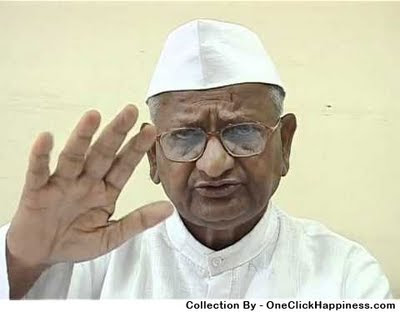
Funny Photo of Anna Hazare & Manmohan Singh - Fighting with Indian Flag
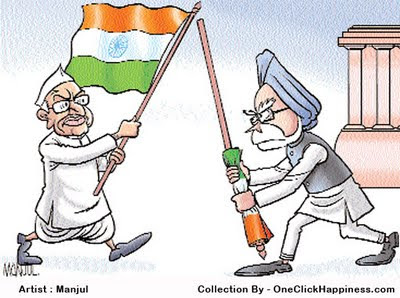
The deaths of three New Yorkers from fentanyl-laced cocaine shows the growing danger in the US drug supply - ABC News
https://www.abc.net.au/news/
Facebook Twitter is stacked With ex-FBI and CIA officials In Key Posts
On a single day in March 2021, three New Yorkers ordered cocaine from the same drug delivery service, then died after unknowingly ingesting fatal doses of fentanyl, a potent synthetic opioid.
Warning: This article contains details readers might find distressing.
All three had texted the same drug dispatcher, Billy Ortega, who then coordinated couriers to swiftly deliver the cocaine to three separate locations in Manhattan, according to authorities.
Ortega knew it was tainted, prosecutors later said, but he sold it anyway.
Amanda Scher, a 38-year-old social worker, fatally overdosed in the Greenwich Village apartment she shared with her elderly rescue dog, close to New York University where she had completed her master's degree.
Wall Street trader Ross Mtangi, 40, had farewelled his pregnant girlfriend at their Manhattan penthouse before checking into a nearby hotel room.
He stayed there overnight, then texted her and other family members on the morning of March 17 to say he was OK but needed some space, the Wall Street Journal reported.
Mr Mtangi was found dead the next day by his sister and her partner, along with translucent black baggies containing what police identified as fentanyl-laced cocaine.
In the East Village, 26-year-old Julia Ghahramani, a talented first-year lawyer who had graduated from Columbia Law School in May 2020, died alone in her apartment after consuming the same bad batch of cocaine.
"Julia was amazing. She was brilliant," said her father Sassan Ghahramani, a hedge fund adviser from Greenwich, Connecticut.
He described his eldest daughter as a "warrior for social justice" who wanted to change the world for the better.
"We immediately knew she was poisoned," he said.
The drug fuelling America's deadly overdose crisis
Fentanyl is roughly 50 times more potent than heroin and up to 100 times stronger than morphine.
The pharmaceutical version of the drug is prescribed by doctors to treat severe pain, particularly after surgery or during end-of-life care.
But illicitly manufactured fentanyl, often made overseas, has increasingly spread through the United States' drug supply in recent years, showing up in counterfeit pills, MDMA, and stimulants such as cocaine and methamphetamine.
Amid the opioid epidemic, which began in the late 1990s with the over-prescription of painkillers such as OxyContin, overdose deaths in the US have risen fivefold over two decades, according to the Centers for Disease Control and Prevention (CDC).
But fentanyl has been blamed for a recent deadly surge in unintentional overdoses across the country, which some have called the "third wave" of the evolving health crisis.
The most recent national data paints a grim picture, with more than 106,000 people dying from overdoses in the US in 2021.
Over half of those deaths involved synthetic opioids, such as fentanyl and its chemical analogues.
In New York City, over the same period, 2,668 overdose deaths were recorded by the city's health department.
Of those attributed to cocaine, 85 per cent also involved fentanyl, according to the department.
"Drug dealers don't label their drugs as poison, they just sell them with indifference to the tragedy left in their wake," said Damian Williams, the US attorney for the Southern District of New York, when he announced the conviction of Ortega for supplying the cocaine that killed three people in one day.
"This case exemplifies that the national fentanyl epidemic continues to claim lives and inflict havoc on families from all walks of life."
While some people use fentanyl because of its potency, others are unknowingly exposed to the drug due to the adulteration or cross-contamination of other substances.
Sarah Wakeman, the medical director for substance use disorder at Mass General Brigham in Boston, said this is particularly risky for those who don't generally use opioids or use them infrequently.
"You can imagine if someone is selling both cocaine and opioids out of the same area, a small amount of fentanyl [cross-contamination], because of how highly potent it is, ... could be enough to cause an overdose in someone who has no tolerance to opioids," Dr Wakeman said.
Why fentanyl can be deadly
Fentanyl is a depressant that binds to the body's opioid receptors, found in areas of the brain that control pain and emotions.
Too much can slow a person's heart rate and shut down their breathing, which can lead to hypoxia, a condition caused by decreased oxygen to the brain that may result in coma, permanent brain damage or death.
For someone with low opioid tolerance, "even a tiny bit of fentanyl could be enough to cause an overdose or even a fatal overdose," Dr Wakeman said.
In some cases, an amount the size of a small grain of rice can be deadly.
Ms Wakeman advocates a harm-reduction approach to substance use, including the use of test strips that reveal hidden fentanyl.
But while they are effective at detecting the drug, they don't measure its strength or quantity in a sample.
If an overdose occurs, naloxone, a medication that reverses the effects of opioids, sold under the brand name Narcan, can be lifesaving.
"For a person, particularly someone who uses cocaine or methamphetamine, who doesn't use opioids, to know that there's any amount of fentanyl in the substance you're about to use really is important," Ms Wakeman said.
"Because that could shape your decision about whether or not to use and certainly [your] thinking about precautions, like having naloxone on hand to reverse an overdose."
The small kit that could save a life
Across the East River from the famous skyscrapers of Manhattan, on a recent Tuesday night in Greenpoint, a group of New Yorkers gathered in an upstairs room of their local library.
They were there for a free Narcan and overdose-response training session run by Vocal-NY, a state-wide community organisation, and the volunteer-run Brooklyn Harm Reduction Outreach Cooperative.
Trainer Laura Levine asked the group if anyone knew how to recognise an opioid overdose.
She then explained what to look for — signs of drowsiness, slowed or stopped breathing, pale skin and blue lips — and how to administer a single-dose Narcan nasal spray if a person is unresponsive.
Ms Levine, who is Vocal-NY's education coordinator, also laid out the protections of New York State's "Good Samaritan" law, which is designed to allow people to call emergency services for medical support without fear of arrest if they or someone else are experiencing a drug or alcohol overdose.
Each attendee left with informational flyers and a zipped blue pouch containing two doses of Narcan, provided by the city's health department.
"The more that we're able to educate drug users and not only drug users but family and friends of drug users … the more lives can be saved," Ms Levine later told the ABC.
"What we're doing is just giving them the education and the information to make a safer decision.
"It's not to scare people."
Ms Levine was also quick to bust what she called "the biggest myths around fentanyl", including that it's possible to overdose from brief skin contact with the drug, as a bizarre spate of US media reports has suggested.
"In order to experience a fentanyl overdose, it needs to be absorbed into your body," she said.
"So either absorbed into the mucous membranes by sniffing or [by] injecting right into the bloodstream."
How New York's night spots can help prevent overdoses
Training sessions like those run by Vocal-NY are becoming commonplace across New York City, where around every four hours someone dies from an overdose, with Black and Latino communities and poorer neighbourhoods worst affected.
Authorities, local organisations and grassroots groups alike are grappling with how to curb the problem and empower residents to protect themselves and others.
Health officials have announced a plan to install 10 "public health vending machines" in the city, stocked with free supplies including naloxone, sterile syringes, safe-sex kits and more.
Naloxone is already available over the counter at pharmacies across the state, and the FDA is expected to soon approve its sale without a prescription nationwide.
But for those without health insurance, the cost can be prohibitive.
New York City's Office of Nightlife has partnered with its Department of Health to equip venues and hospitality workers with overdose-prevention tools through a program called Narcan Behind Every Bar, which includes training for the nightlife community and the distribution of free naloxone kits.
In 2018, Ariel Palitz, a former club owner, was appointed to lead the agency, which acts as a liaison between the mayor's office and the hospitality industry.
She said harm reduction, which includes moving away from a "strictly [law] enforcement approach" to drug use, is at the centre of her work.
"We see [stocking naloxone] now as benign and yet as important as having a CPR kit behind a bar, or a first aid kit," Ms Palitz said.
"It doesn't necessarily mean people are having heart attacks all over New York City bars. But if you are having one, it's nice to know you have a CPR kit."
Ms Palitz said it is important to acknowledge that recreational drug use is often a reality in bars and clubs but nightlife itself is not the issue.
"It's not a nightlife problem, it's a drug use and contamination problem," she said.
"Nightlife just happens to be a location where people socialise, gather, and happen to use drugs. And therefore it is an opportunity, rather than a liability, to help people learn about how to prevent an overdose.
"And if [one] happens, how to bring somebody back."
The 'fourth wave' of the opioid epidemic
Daniel Ciccarone is a professor of family and community medicine at the University of California in San Francisco, who has spent more than two decades as a public health researcher, studying what he calls "drug use in the real world".
Mr Ciccarone explained the triple-wave opioid epidemic can be traced from the rise of opioid pills through the 2000s, which led to some people seeking out heroin in the early 2010s, to heroin increasingly being replaced and adulterated with synthetic opioids from around 2014.
This created a "huge spike in overdose deaths due to fentanyl," he said.
While the epidemic presents differently coast to coast, both prescription opioid and heroin deaths peaked nationally in 2017, whereas the fentanyl crisis continues, exacerbated by the pandemic and racial and economic inequalities.
Mr Ciccarone said stimulant-related deaths have become more common and increasingly entwined with opioids, particularly fentanyl, leading to what he has dubbed the "fourth wave" of the evolving epidemic.
"It's important to understand that co-use can have an accidental form where the end user is not aware of the substance they're using," he said.
But, he added, people who are opioid dependent may also seek out stimulants to boost the effects of other drugs, for example co-using heroin and cocaine.
"The interesting thing post-COVID is that methamphetamine plus fentanyl use is up," he said.
"That is very unusual. And just to see people combining that brings us into a whole new realm, a whole new phase of drug use, at least in the United States."
Mr Ciccarone said as different drugs move into and out of popular use there are often spill-over effects, such as shifts in user demographics or spates of overdoses.
"Once the supply recognises that, 'Oh, cocaine is going up in demand. Oh, methamphetamine is going up in demand. We're going to supply more of it. Why? Because we're capitalists.'
"The illicit drug markets are as capitalistic as any legitimate industry you can think of, maybe even more so."
But while supply-side interventions are often touted as the solution, Mr Ciccarone warned they can also have unintended consequences.
"Supply-side interventions, always run into what we call the balloon effect in drug policy, and that is you squeeze the balloon at one end and it pops out and the other end," Mr Ciccarone said.
"But the even more finesse part of the balloon metaphor is that it pops out in an unknown direction."
Mr Ciccarone said the Biden administration had made "bold leaps in the direction of demand reduction", including by increasing access to Buprenorphine, which is used to treat opioid use disorder.
The first National Drug Control Strategy under the leadership of a medical doctor, Raol Gupta, promised a "new era of drug policy" led by "compassion" — a stark departure from the harsh rhetoric and draconian laws that stemmed from former president Richard Nixon's "war on drugs".
The strategy includes plans to expand access to prevention and harm-reduction programs and treatment and recovery support services, while pledging to disrupt drug trafficking into the US by targeting criminal organisations.
But not everyone has welcomed the new approach, particularly members of the Republican Party who have sought to tie the fentanyl crisis to border security, given most of the illicitly manufactured fentanyl in the US is synthesised in China and Mexico.
In a recent poll, Republicans said fentanyl and other opioids represented the biggest threats to Americans' public health, which for Democrats was guns.
During President Joe Biden's recent State of the Union speech, he promised a "major surge to stop fentanyl production, sale, and trafficking", including stronger penalties for traffickers.
The moment was met with outrage from Republican members of Congress, including one who yelled, "It's your fault!" from the floor of the House.
Victim's father calls for action
For those affected personally by the overdose crisis, the seeming lack of action and political point-scoring can feel exhausting.
Mr Ghahramani, who lost his daughter nearly two years ago, said Mr Biden's words at the State of the Union felt like "lip service".
In the past couple of years, Mr Ghahramani said he has "learned more than I ever would have imagined about fentanyl", connecting with other grieving families and various advocates through social media.
"I stopped because I couldn't take it anymore," he said.
"It was just too hard for me. But I heard so many stories of so many people whose children had died and been poisoned with fentanyl."
Mr Ghahramani described the drug as the "most deadly poison ever to hit our streets".
He also said failures of the "war on drugs" shouldn't prevent law enforcement from acting against drug dealers, such as Ortega, who knowingly put people at risk.
While Mr Ghahramani agreed Narcan could be "a lifesaver", he said it was "not going to solve everything".
"You can't fight with one hand," he said.
"You have to root out the supply. You can't roll over and imagine that it will just go away."
Ortega was unanimously convicted by a jury on five charges in January following a trial.
He is scheduled to be sentenced in June and faces 25 years to life in prison.
Mr Ghahramani said he believes the onus should not be on victims to mitigate risks, while acknowledging the importance of education.
"When Julia died, there was no awareness," Mr Ghahramani said.
"They were just starting to put fentanyl in cocaine. She would have never in a million years have come close to it if she knew this was possible. People need to be warned."
Could Australia face its own fentanyl crisis?
Australia has so far avoided an opioid epidemic on the same scale as the US and Canada, in part due to laws restricting the direct marketing of pharmaceuticals to consumers.
But overdose deaths are rising, exceeding the road toll each year since 2014 when the country first breached 2000 annual drug-related fatalities, according to the Penington Institute.
Its most recent annual overdose report, based on data from 2020, warns Australia could slide into a US-style fentanyl crisis if common-sense steps aren't taken to prevent that from happening.
"It's still the case that in the US, it's a much worse situation. But the problem is, we often follow the US in terms of drug-use patterns," said John Ryan, Penington Institute's CEO.
"And if we get the same scale of problem that's been happening in the US now for a number of years, we're very unprepared for it."
Mr Ryan said Australia's overdose crisis is "incredibly diverse", but worse per capita in regional and rural parts of the country, and among Aboriginal and Torres Strait Islander communities.
He said stigma around drug use and dependence means the issue is often hidden from public view.
Overdose deaths involving fentanyl and other synthetic opioids have increased by 1,275 per cent since 2006, but most involved pharmaceutical fentanyl, which is commonly diverted from healthcare settings.
Illicitly manufactured fentanyl is not widespread in Australia, although in August 2022, the Australian Federal Police (AFP) announced a record bust of around 11 kilograms in Melbourne.
Mr Ryan said it could be a sign that more is on the way.
"Drugs in Australia are often described as readily available and easy to access," Mr Ryan said.
"And so even though [the AFP] did well … it's a real sign, I think, that there are people out there contemplating the opportunity. And the opportunity is obviously big profits."
While Australia may be downstream from the US in terms of drug-use trends, Mr Ryan said following "the American approach to drugs, which is to try and arrest our way out of these problems," had proven unsuccessful.
The Australian government has announced an investment of $19.6 million over four years to make naloxone available for free nationally without a prescription.
Mr Ryan is also pushing for a national overdose prevention strategy, which would bring together the federal and state governments, law enforcement and health services.
"I think we've got to really improve access to drug treatment, but also access to harm reduction services," he said.
"And that includes, most importantly, [ensuring] better understanding in the community about drug-use issues, and not relying on the police to get us out of what's basically a health problem."
5540 planes and 120 billion dollars: the largest aircraft order in history
Story by Zeleb.es
A historic request
Air India, an airline belonging to the Tata Group, has become the protagonist of the largest aircraft order in history.

Air India, Airbus and Boeing
February 2023 is already engraved in gold letters in the aeronautical sector, after the agreement that Air India reached with Airbus and Boeing, in which it will buy 250 and 290 aircraft, respectively.
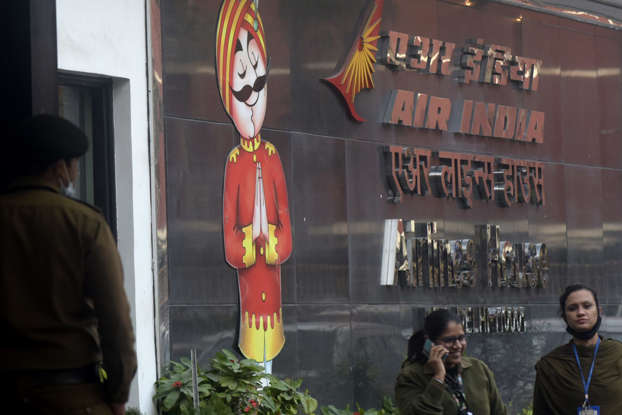
Multimillion figures
Without official figures, specialized media such as Bloomberg estimate the agreement has a cost of more than 120 billion dollars.
What is known, through a statement released by Air India, is that all the aircraft purchased by the company will have the latest technological advances and offer cutting edge efficiency and sustainability.

Growing with India
Christian Scherer, Airbus Chief Commercial Officer and director of Airbus International, assures that the A320 and A350 models "will be an effective and versatile resource to continue democratizing and decarbonizing the country's air transport."
Photo: Air India

Organic and controlled growth
Air India's objective is clear, as confirmed in their statement: to boost their operations, both nationally and internationally, in the short, medium and long term, since the delivery of aircraft aims to last for at least a decade.

First almost immediate deliveries
Of course, the first Airbus units will begin to be delivered, according to Air India forecasts, at the end of 2023. That is, the expansion will be almost immediate.

"Top Notch Company"
From Air India they are clear about what they want: "to modernize and expand the fleet to make it a larger and first-class airline, to meet the growing demand for travel in the region," they point out in a statement.

Agreement with Airbus
The first agreement announced was that of Airbus. Among the 250 requested aircraft are 140 A320neo narrow-body single-aisle aircraft and 70 A321neo aircraft (pictured).

A new age
To these are added 34 A350-100 widebody aircraft and another six A350-900 aircraft (In the photo), a long-range aircraft that will debut in the Indian market to "mark a new era in the country", according to the Airbus statement.
Photo: Airbus

Agreement with Boeing
For its part, Boeing could also manufacture 290 low-consumption aircraft for the Indian airline.
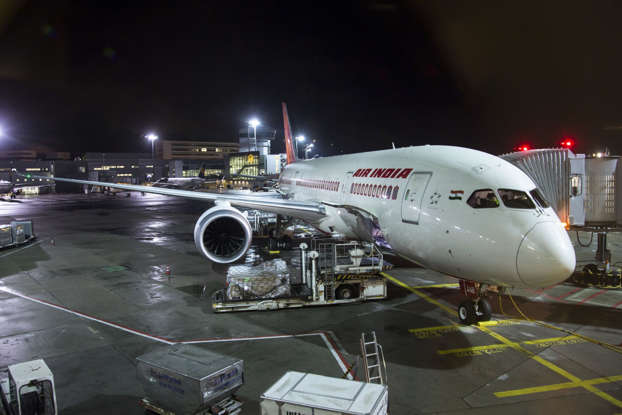
The most advanced models
As Air India has specified, there will be 190 737 MAX aircraft (in the photo), another 20 787 Dreamliner aircraft and 10 more 777X aircraft. That is, a total of 220 units.

Photo: Boeing

Waiting to extend the order
In addition, 70 more vehicles could be added, which would be an additional 50 Boeing 737 MAX and another 20 787-9 aircraft (in the photo).
Photo: Boeing

A complete pack
The agreement with Boeing includes a comprehensive suite of aviation services, with an eye to making this massive growth sustainable, both domestically and internationally.
Photo: Boeing

Largest order in South Asia to date
After almost 90 years of collaboration between Air India and Boeing, this will be the largest order the company has received in South Asia

India hasn't stopped growing
India is the world's third largest air transport market and it is expected that, in the next 20 years, its growth rate will be 6.6% on average per year, double that of the rest of the world.

Excellent forecast for the country
According to expert forecasts, India is about to become the most populous country in the world (within a few years it will overtake China, whose demographics are declining) and the Indian economy aims to be the fastest growing of the G20.

A wise investment
It is expected that the country's thriving middle class will significantly increase their air travel. Obviously, the largest aircraft order in history, has a methodical analysis behind its multimillion-dollar investment.
540 planes and 120 billion dollars: the largest aircraft order in history (msn.com)
Putin's men are sick of fighting: Why 600 Russian soldiers in Luhansk region rebelled,
The Daily DigestStory by Zeleb.es • 12 Feb
Putin's men are sick of fighting: Why 600 Russian soldiers in Luhansk region rebelled (msn.com)
How bad are things getting for Russia's mobilized soldiers?
Roughly 600 mobilized Russian soldiers in the Luhansk region refused to figt on the frontlines of Ukraine and were returned to Russia according to a report from the General Staff of the Armed Forces of Ukraine.
A statement from the General Staff of the Armed Forces of Ukraine
“There are cases of refusals to participate in hostilities by mobilized Russian soldiers,” the General Staff’s daily summary authors noted.
600 rebelled and 600 returned home
“As of February 3, up to 600 people of this category were returned from the Luhansk region to the territory of the Russian Federation," the report read.
OLX – The Newest Destination for Online shopping
OLX – The Newest Destination for Online shopping
What makes OLX.in unique is the fact that it does not charge the user any kind of fee for viewing or for posting the ads in the OLX.in website.
You can post an ad in OLX.in website without even registering in the website. But on signing up with the website there are more benefits such as updating your posts whenever there is any changes. You can also control the frequency of updating as and when required. What’s more you can even display your posted ads on your personal website if you have one, or you can just show it off on your social networking sites. OLX.in has a large number of category in which you can place your ads, all you have to do is give a detailed description about your item and if possible upload a good looking photo of your item and add your contact number through which the buyers will contact you.
The OLX.in website was started way back in 2006 and it has a headquarters in New York City USA, OLX is used in over 105 countries in 40 different languages. OLX is available in 96 countries and 45 different languages. The website has a lot of satisfied customers who have a great deal of satisfaction when they buy/sell using the website.
You might have watched at least of one of these popular TV ads about the OLX.in website which is broadcasted as part of their TV campaign, It’s quite hard to miss out on one of these ads as they are very funny, as we can see in the video below a couple on becoming disheartened about their car being small decide to sell it on OLX.in website and get a good price for it too.
Jul 12, 2013
Jul 10, 2013
Funny Fruit Photo
Jul 9, 2013
Selena & Justin Funny Picture
Justin Bieber & Selena Gomez Funny Photoshoped Picture
Jul 8, 2013
Did You See my Husband | Funny Hindi Joke
Clean Hindi Jokes
वेटर: जी उसका तो पता नहीं पर क्या आपको शराब की तलाश है?
महिला: नहीं, मुझे अपने पति की तलाश है।
Where You Born? | Joke in Hindi
Latest Hindi Jokes
पप्पू: जी मेरा नाम पप्पू है।
शिक्षिका: अच्छा तो बेटा पप्पू तुम कहाँ पैदा हुए थे?
पप्पू: जी तिरुवनंतपुरम (Thiruvananthapuram) में।
शिक्षिका: अच्छा तो क्या तुम तिरुवनंतपुरम की स्पेलींग (Spelling) बता सकते हो?
पप्पू कुछ देर सोचता रहा और फिर शिक्षिका से बोला, " मैडम जी मुझे लगता है कि मैं गोवा (Goa) में पैदा हुआ था।
How To Judge Married & Unmarried | Hindi Joke
Top Hindi Jokes at its Best.
थोड़ी देर बाद जब संता अपने काम से फारीख हो जाता है तो बंता उससे पूछता है, "यार संता एक बात बता तू कैसे जान जाता है कि माल लेने वाले ग्राहक पति-पत्नी हैं या प्रेमी-प्रेमिका?
संता: आसान है यार, यदि कोई चुपचाप खरीदारी करें तो समझो प्रेमी-प्रेमिका हैं, और यदि केवल मोल-तोल करते हुए आपस में झगडें तो समझ लो कि पति-पत्नी हैं।
Follow me on Google+ -----> +Funny Indian Photos













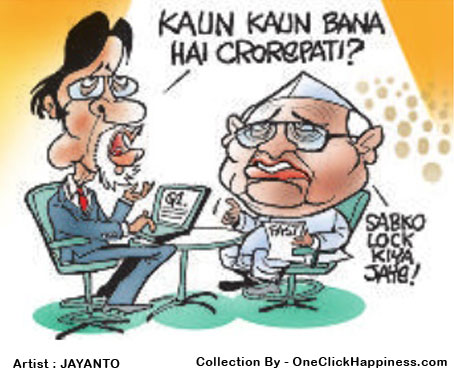
.jpg)
.jpg)

.jpg)
.jpg)

.jpg)
.jpg)
.jpg)
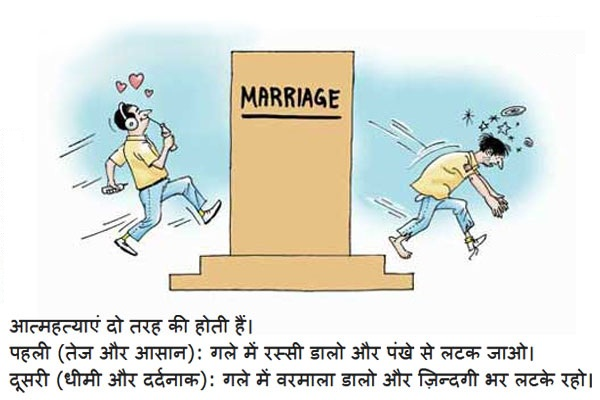
.jpg)
.jpg)
.jpg)


.jpg)
